CLEANING UP MOUNT EVEREST: First Ever Human Waste Treatment Plant For Everest Base Camp
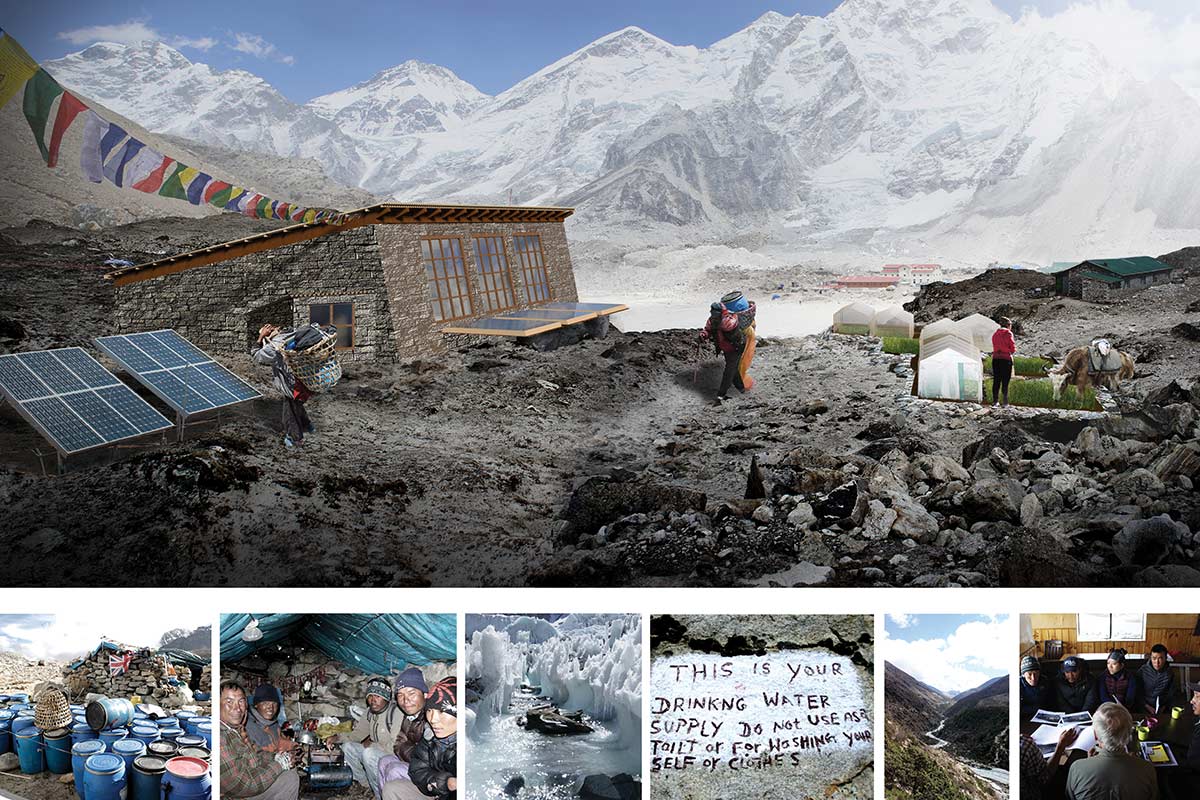
by Shail Desai
Click here to donate online - Cleaning Up Mount Everest by The Mount Everest Foundation.
Human Waste is piling up at Everest Base Camp and nothing has been done about it. Until Now!! The Everest Biogas Project has received the endorsement of the UIAA Mountain Protection Award, has been featured in The Economist, on CNN, in the Washington Post, and on Thurston Talks. After extensive research and perfection of the design, the Biogas team are fully engaged in raising awareness of, and funds for construction of the facility near Everest Base Camp . Please give generously to help deal with harmful impacts of untreated waste on Everest, and please share this appeal with all of your family, colleagues and friends Need more information?
 International Climbing and Mountaineering Federation
International Climbing and Mountaineering Federation
UIAA MOUNTAIN PROTECTION AWARD WINNER. MOUNT EVEREST BIOGAS PROJECT. HEALING THE HUMAN IMPACT ON EVEREST
Climate is no longer the only major challenge for Mount Everest climbers. It's poop!
Please read down further and contact info@MountEverestFoundation.org . Website: www.CleaningUpMountEverest.org
Cleaning Up Mount Everest - Mont Everest Biogas Project Video
Mt. Everest Biogas Project-Converting human waste to methane
20 October - IMPACT OF COVID-19 CAUSES CONCERN FOR PROGRESS OF MOUNT EVEREST BIOGAS PROJECT
Following recent profiles on the progress made by two past UIAA Mountain Protection Award winners – Mountain Wilderness France and AlpineLearning Project Weeks – the focus turns to winner Mount Everest Biogas Project (MEBP).
The United States-based project, launched in 2010, is a volunteer-run, non-profit organisation that has designed an environmentally sustainable solution to dealing with the impact of human waste on Mount Everest and eventually other high altitude locations. This year was set to witness significant on-site progress on Everest but the Covid-19 pandemic, as detailed below, has caused significant hold-ups.
Mount Everest boasts a massive climbing industry, with hundreds of climbers – and support staff – make the trip up the Khumbu Valley each year . This tourism has left a trail of human waste, approximately 12,000kg per year, that has given way to environmental and public health concerns. MEBP’s proposal is to use an anaerobic biogas digester to treat human waste. It will eliminate the dumping of solid human waste and destroy pathogenic fecal coliforms that threaten the health of the local communities – lessening the impact of the tourism industry on a mountain that is sacred to the Nepalese.
The Mt. Everest Biogas Project was designed to address this environmental and health hazards in a sustainable manner and serve as a model for other regions that must deal with similar waste problems at high-altitude, regardless if it is caused by climbers or local communities. The system will convert waste into methane, a renewable natural gas, and a reduced pathogen effluent.
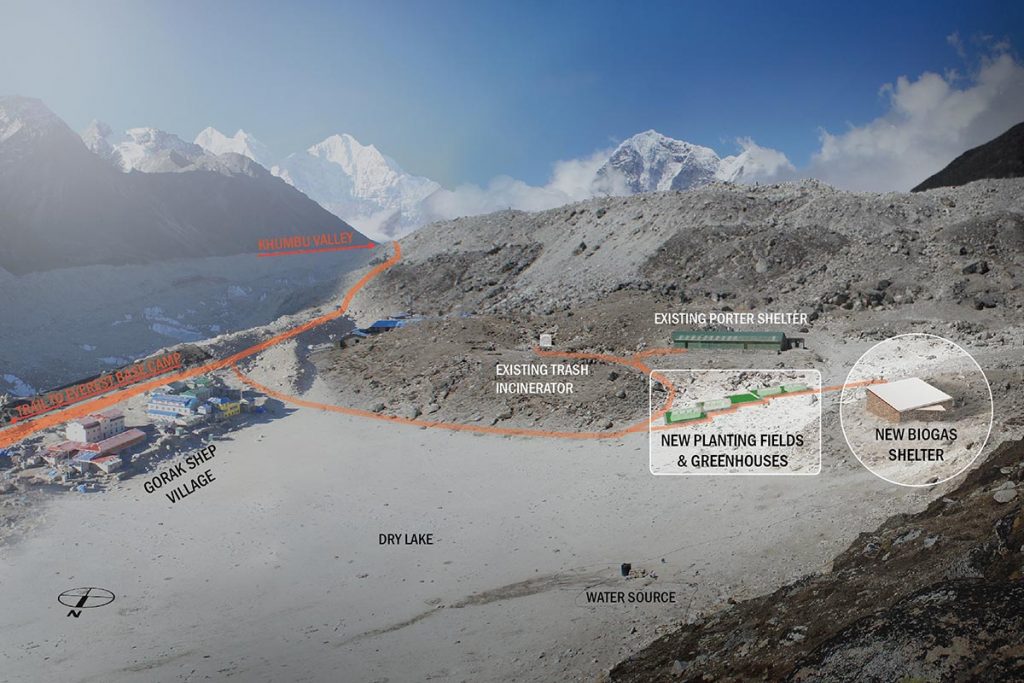
Mount Everest Biogas Project – Site render
Following the project’s MPA win in October , groundbreaking for the biogas digester was planned for spring and an operational date slated for winter, early spring. The UIAA caught up with Dr Daniel Mazur, head of the project, to assess progress made during the past few years and in particular the impact of Covid-19.
UIAA: How much of a boost to the Mount Everest Biogas Project was winning Mountain Protection Award?
MEBP: The Award brought recognition from an established international organisation, providing the MEBP with much welcome exposure as a legitimate development project for all those familiar with the UIAA. This has broadened our project’s recognition, and encouraged donor’s trust.
Can you briefly summarise how the project has evolved ?
We fully vetted our design, travelling to Nepal and signing Statements Of Work (SOW) with all the Nepali subcontractors we will work with to build the system. These SOW detail the scope of work for the subcontractors to accomplish and the cost expected at that time. So at this time we have all the required Nepali subcontractors lined up to start construction, and we have approval by the local government authorities to build within the Mt. Everest National Park. We have been working with Kathmandu University on a biogas research component for proof of design.
What sort of testing has been taking place?
Research undertaken by MEBP and Seattle University (SU) financed a second round of digester experiments at Kathmandu University . This research supported an MSc student, Mina Pokhrel. The pilot scale tests used blue barrel waste and were operated at mesophilic temperatures (25-30 C). The tests demonstrated biogas production in all four replicates.
The University of Washington and SU collaborated to analyse the microbial ecology of BSP type digesters in Nepal. This work was presented as a poster at the AEESP (Association of Environmental Engineering and Science Professors) conference and is currently being prepared for publication. BMP tests are being conducted at SU to determine the impacts of antibiotics commonly used by climbers on biogas production. Current results indicate little to no impact of the antibiotics. BMP tests are being conducted at SU to identify biodegradable bags that can be used to collect the waste, avoiding the need to macerate them prior to adding into the digester. Three tests have been completed with all bag types showing poor biodegradability. Four new bag types are currently being assessed.
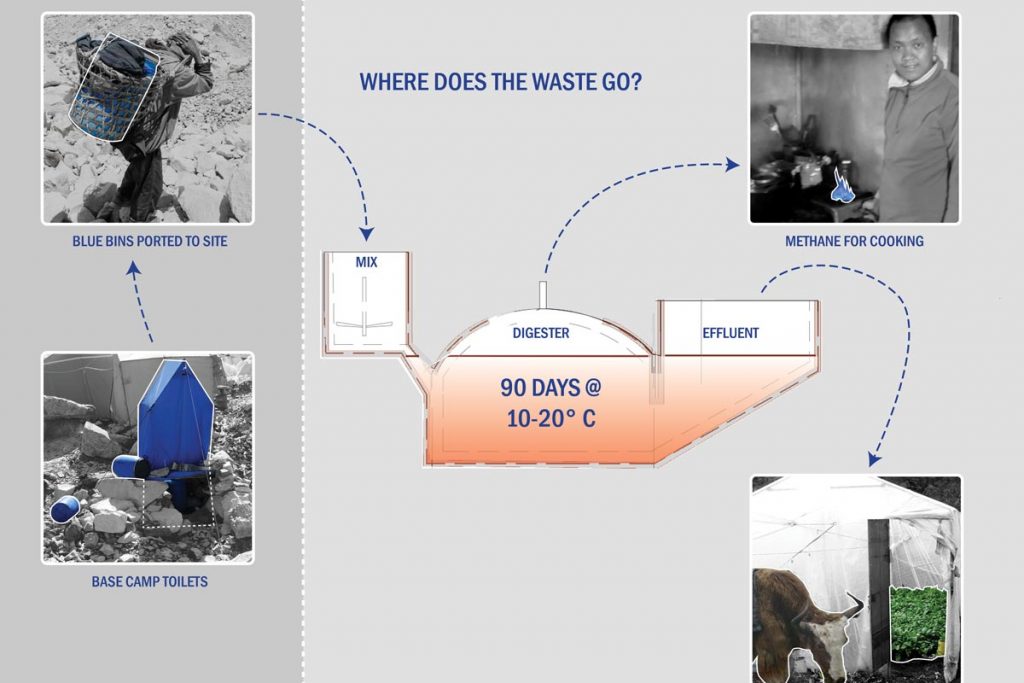
How has your project been impacted by Covid-19?
Construction work in Nepal has been shut down by the Covid-19, stopping the possibility of building the MEBP anytime soon. The world economy has also contracted substantially because of this pandemic. This has slowed most donations to our project, and created a difficult fundraising environment where almost every country has a crisis and people are seeking funding from any source to survive through the year. Any help from UIAA, or its members, to find a funding sponsor would be greatly appreciated. The UIAA has dedicated an area of its donate page for the climbing community to help support the project.
During Covid-19, much of the groundwork in Nepal was put on hold. The team has taken this opportunity to sponsor an internship in the US for an aspiring engineer. This engineer has been working with the architect in the building of a physical construction model. That model will help work out construction sequencing and aid in communicating with the local builders, particularly in the details that are not standard in the local building traditions.
Regarding research, Kathmandu University is willing to start a new round of tests but we have to wait until the pandemic clears. Similarly at Seattle University, the students working with us can no longer work in the lab so that work is effectively on hold.
With access to the Nepalese mountains being restricted, were you nonetheless able to assure progress of your project?
Nepal is currently closed for most travel/construction. As soon as Nepal open from the pandemic, everyone will be hungry to get their industries back into motion. If we are able to fund the project at the time Nepal opens again then our Nepali subcontractors will certainly be happy to construct this project with us.
What are the priorities for the next twelve months?
As soon as Nepal opens and providing our fundraising efforts can continue, then we will finish building the project.
What is the risk that the project stops here and all the hard work over a decade comes to nothing?
From the standpoint of our own organisational (Board) members, the Mount Everest Biogas Project is going forward as the people involved are deeply concerned about this troubling issue. When the Everest climbing expeditions get going again, after Covid, there will be thousands of people using the toilets in base camp and their waste will once more be dumped in unlined pits near the Everest trail. This waste must be treated. The Biogas Project provides an elegant solution. Treat the waste, removing pathogens, and convert it into biogas cooking fuel and fertilizer. We are working very hard to try and raise the money, so that this problem can be solved. If we don’t solve it now, before it is too late, the pits will overflow even more than they are now and contamination will spread from Everest basecamp throughout the entire Khumbu Valley and further poison the Sherpa people and tourists, trekkers, and climbers visiting Everest. On another matter, we have all been working hard to line up all of the necessary paperwork, permits and supporters in the Nepal government and climbing community. This Nepal wide organisational support has been achieved. If for some reason, we are not able to raise the funds soon, then this support may erode as the government changes, and we might have to begin the process all over again, causing further delays and the tragedy of climbers and Sherpas and Nepalese staff’s untreated waste from Everest Base Camp could continue unchecked for many years to come.
What advice would you give to other organisations and/or UIAA members running similar sustainability-led projects? What makes a successful project?
Close coordination with the local people is key to selecting spaces, techniques and collaborators; so as to avoid crossing cultural taboos or overstepping the project’s invitation to alter the community, landscape or how things are done. We must strive to create development projects that address the specific requests of a community, instead of pushing preconceived “solutions” that may impose our culturally informed view of how things should be done. The MEBP is still on guard to avoid these pitfalls, as we continue to pursue implementation of our system for Gorakshep.
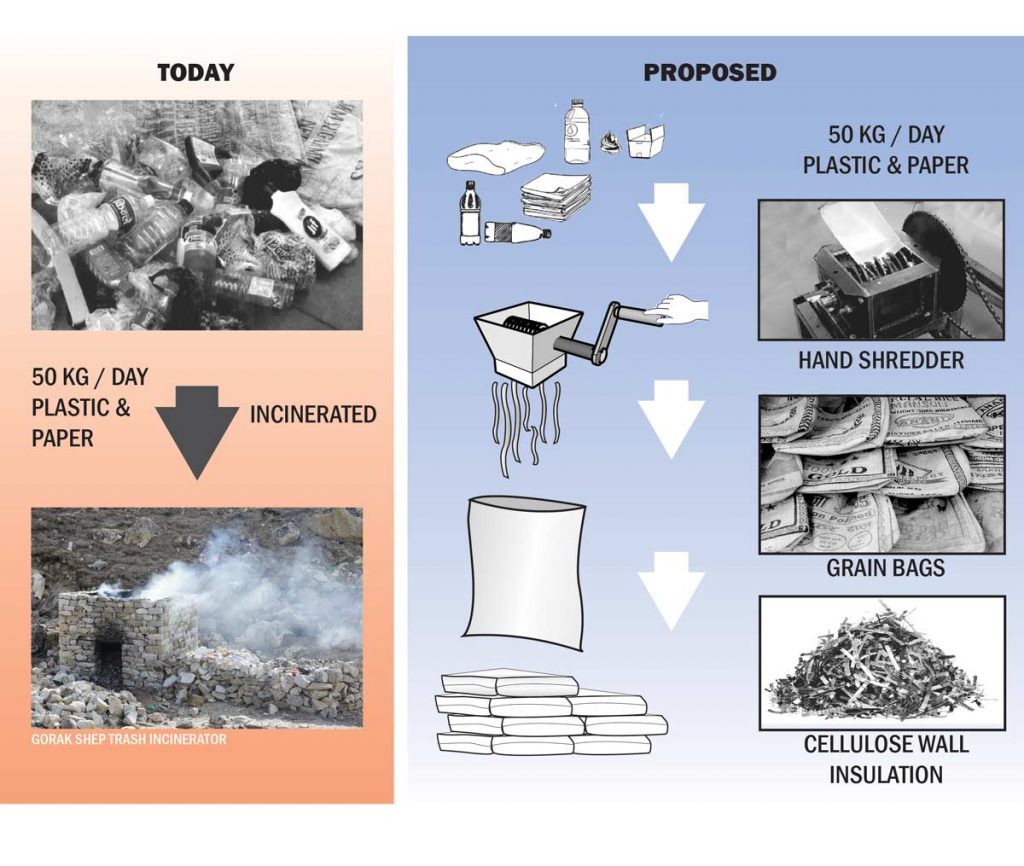
How can the general public support/mountaineering community support your project?
Donations to the project from climbers and the public are a very tangible way for people to support this project. But even sharing about our project through social media and other outlets helps to expand our project’s recognition and inch us closer to completing our fundraising goals. Thank you very much for your interest in helping to solve the human waste problem on Mount Everest. We greatly appreciate all that everyone at the UIAA is doing to take care of our world’s mountains!
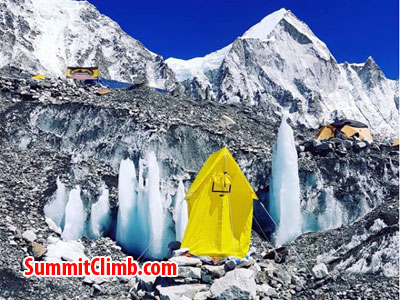
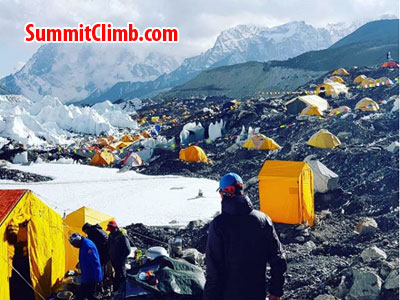
toilet tent at basecamp. tents and views. Photo M Williams
At one end of Kathmandu University is an isolated structure that is not too popular with the students. A few signs on the door announce “Human faecal matter”, “Highly contagious” and “Do not enter”. Those working inside, led by Bed Mani Dahal, associate professor of the Department of Environmental Science & Engineering, could hardly disagree with the revulsion caused by the project his team is associated with.
“You don’t really feel comfortable when you are working with human faeces — the smell is the worst part of it. Precautions are a must because you can also get easily infected,” Dahal says, smiling.
It’s just another day in the life of the researchers, from Kathmandu University and , who are associated with the Mt Everest Biogas Seattle University Project that looks to address the poop issue on the highest mountain in the world. According to the records of the NGO, Sagarmatha Pollution Control Committee, around 12,000 kg of human waste is generated each year on Everest, 80% of which is produced in the spring climbing season alone (April-June). This waste is carried off the mountain and down to the village of Gorak Shep in Nepal — the first human settlement for those descending the mountain, after the Everest base camp — where it is simply dumped in unlined pits in the area, leading to serious issues of contamination.
“When water seeps through the ground, it looks clean because it’s filtered through the soil. But it has a lot of pathogens due to this human waste, which makes it unsafe for the local community,” says Michael Marsolek, associate professor at Seattle University.
The idea to find a solution was first conceived around a decade ago. Dan Mazur, an American mountain guide who leads expeditions up Everest, was all too aware of the impending problem, ever since commercial expeditions took off in the early ’90s. According to The Himalayan Database, while there were 77 successful ascents between 1985 and 1989, that figure escalated to 634 . Add to that the expedition support staff, and Everest sees a civilisation at base camp during the climbing season each year. Mazur got together with Garry Porter from Engineers Without Borders to conceptualise a biodigester that could convert the human waste into methane gas, which could be used by the local community for cooking.
This would also reduce their dependency on other fuels. With a little treatment, the residue left behind could also be used as fertilisers.
“Cutting of wood for fuel led to defoliation wherever there was vegetation. Besides, homes burning wood or yak dung led to inhabitants getting pulmonary diseases,” Porter says. “The design of the bio-digester was deliberately made open source, so that it can be replicated and it has drawn interest from organisations in Pakistan and Iran as well.”
The concept isn’t novel in terms of implementation. In the lower reaches of Nepal, around 3,00,000 bio-digesters process faecal waste, animal dung and crop residue to cater to the needs of rural households. In fact, the Nepal government even provides subsidies for the installation through the biogas support programme. But at higher elevation, the altitude and the erratic weather patterns add to the challenge. “Bacteria can easily break down mixed waste, as compared to solely faecal matter. And at those heights, the process takes longer,” Marsolek explains.
Over the last four years, the team has worked on a bio-digester design that exclusively processes human waste. The facility at Kathmandu University was then used to simulate conditions on the mountain to understand the optimum temperature at which microorganisms could break down the waste and produce adequate biogas. On the mountain, solar panels would help a bio-digester maintain suitable temperatures. “Researchers have been able to generate biogas at high temperatures, but they’ve not had much success in low-temperature areas. This is the main constraint, so we spent a lot of time on the design of an insulated greenhouse and regulating temperature inside it. We’ve had success in the lab and now look to scale up,” Dahal says.
A major aspect of their work has been fundraising — for the research, as well as to construct the facility at Gorak Shep. So far, a crowdfunding campaign has managed to raise around $2,600 in nine months. The project was also awarded the UIAA Mountain Project Award last year, which earned them a grant of $5,000. “It’s hard to arrive at a figure until we start building. But if a bag of cement costs Rs 1,500 in Kathmandu, it’s about Rs 20,000 up in the mountain. A porter must carry it for two weeks to get it there, else it has to be ferried by helicopter, which is $2,400 an hour. At least two-thirds of the total cost is transportation,” Mazur says.
Once in operation, the project will provide fuel for the local community and will address the environmental hazard on Everest. It will also generate employment as people would have to be hired to maintain the bio-digester and the pipelines distributing the gas. “One problem with these humanitarian engineering projects is that they are not monitored for a long time, so our fundraising accounts for this as well,” Marsolek says.
If the funds are gathered, the project could be implemented as soon as monsoon next year. “The great thing about Mt Everest is that there’s a lot of appeal — there’s only one Everest, after all. And we hope that will encourage others to join in,” Mazur says.
So Porter, along with fellow climber Dan Mazur, established the Mount Everest Biogas Project almost eight years ago to try get rid of this "environmental hazard."
Over the years they have been toying with the idea of installing a biogas digester at Gorak Shep to convert human waste into methane gas.
While biogas digesters are used around the world, and fairly easy to make, they are difficult to operate at altitude in sub-zero temperatures.
This is because the process requires bacteria to feed on organic waste, and these living microorganisms need to be kept warm, explains Porter.
The Mount Everest Biogas Project plans to use a solar array panel to transmit heat into the digester. There will also be a battery array to store energy at night when the sun sets.
Rendering of the proposed biogas digester.
The end products will be methane gas, which can be used for cooking or lighting, and effluent that can be used as fertilizer for crops.
"It takes a nasty product and makes two products that can be used by the Nepali people," explains Porter.
However, Porter says climbers often take antibiotics, and he was initially concerned that antibiotics in the poop might impact the microbes' ability to break down the waste.
But he says mini digesters at Kathmandu University successfully converted human waste from base camp to methane gas.
The Economist -
How to dispose of human waste on Mount Everest. Unsavoury problems at 18,000 feet
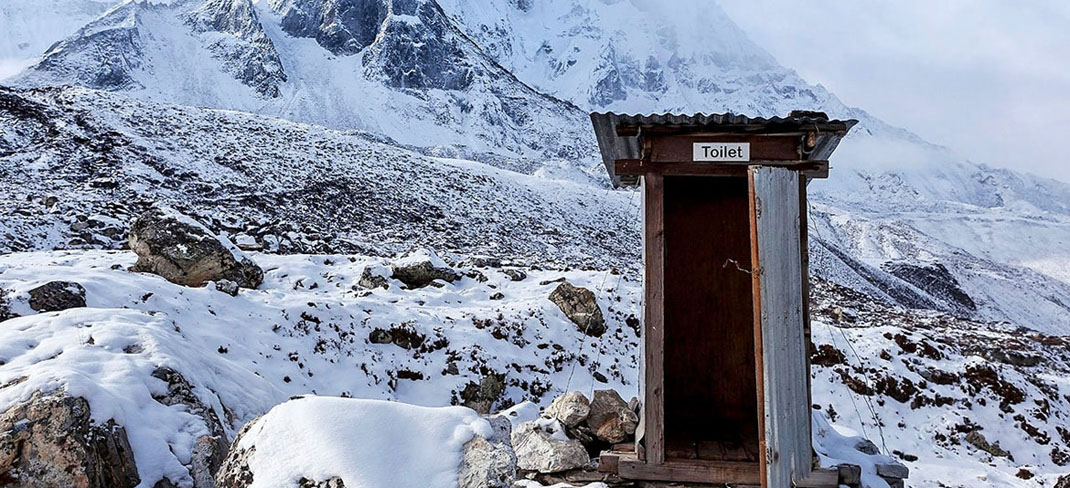
Oct 25th | GORAKSHEP | By Kaitlin Tosh
“Take only memories, leave only footprints” is more than a clichéd hiking motto at the Sagarmatha National Park in Nepal. The large box of rocks sitting next to the metal detector at the local airport is a testament to that: tourists departing from Mount Everest have to dispose of material they have collected before stepping onto the dauntingly short runway. Fulfilling the second half of this mantra, however, is harder. Tens of thousands of tourists leave more than just footprints. They have created a mountain of faeces, which is becoming an environmental problem.
648 people reached Everest’s summit, more than seven times the number two decades ago. Many more make it to base camp. Currently, toilet waste is carried and dumped into pits near the town of Gorakshep, an hour’s walk down the mountain. The amount of waste is increasing fast, says Budhi Bahadur Sarkhi, a porter who has been carrying poo from base camp to these pits for 12 years. When Mr Sarkhi started there were seven porters hired for the job. Now there are 30.
Dumping sites are filling up quickly, and the run-off is infiltrating the region’s water channels, some of which feed into wells that supply drinking water. When tests were done at nine water sources in the region, seven were contaminated with significant levels of E. coli. The presence of human by-products in the water, like nicotine and sunscreen, suggests that the contamination came from human faeces, rather than that of the many local yaks.
One innovative solution could help. The Mount Everest Biogas Project, led by two mountaineers, hopes to install a biogas reactor in Gorakshep at the start of next year. All of the faeces from base camp would then be converted into two by-products: fertiliser and methane gas, possibly for cooking. In which case the mountain would be a little less brown and a little more green. For more information: www.MtEverestBiogasProject.org
This article appeared in the International section of the print edition under the headline "A mountain of waste"
Everest Base Camp Waste Treatment Research Collaboration Between Kathmandu University and Seattle University: www.CleaningUpMountEverest.org .
Researchers from the 2 Universities are now in Kathmandu and working together to build a waste treatment plant for Everest Base Camp.
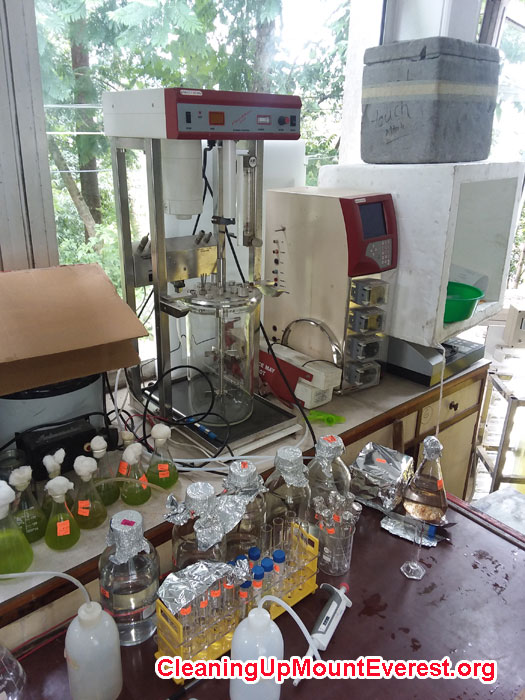
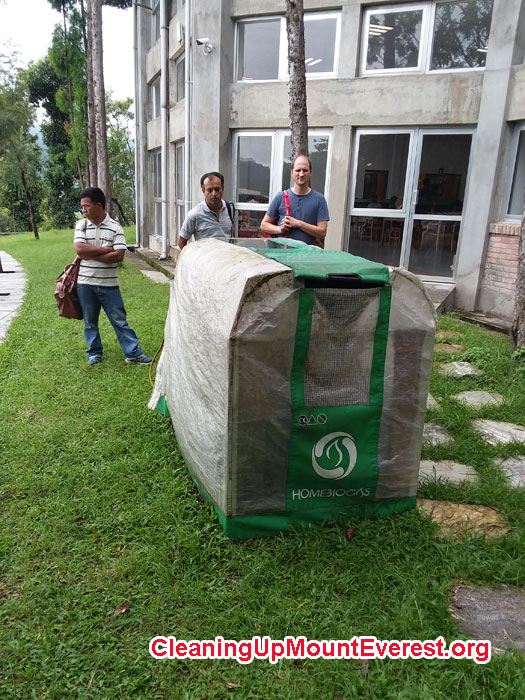
Biogas Laboratory at Kathmandu University. Professor Bed Mani (KU), and Mike Marsolek (SU) in front of portable biogas digester
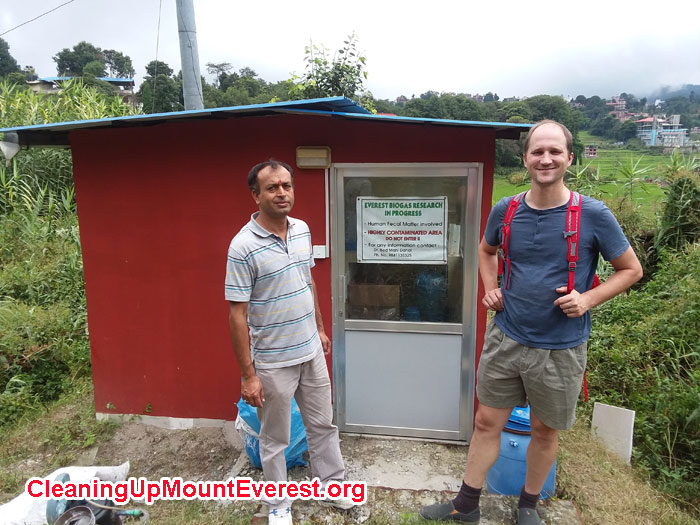
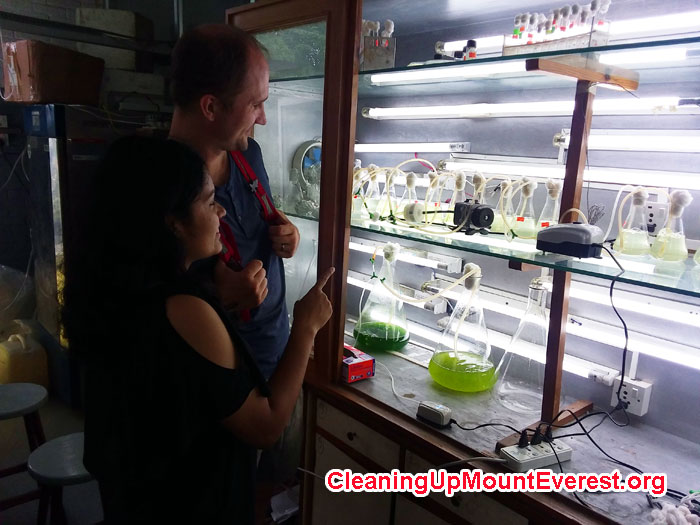
Professor Bed Mani (KU), and Mike Marsolek (SU) in front of the new Everest Base Camp Waste Treatment Research Building at Kathmandu University. KU Grad Student Garima Baral and Professor Bed Mani (KU), and Mike Marsolek (SU) discussing biogas research.
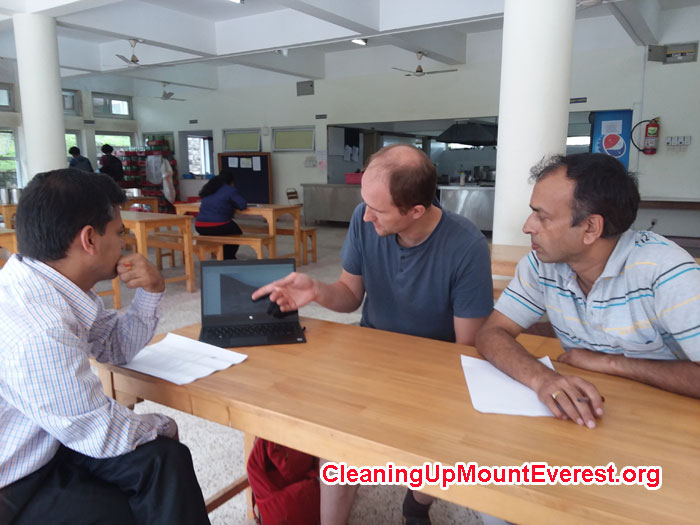
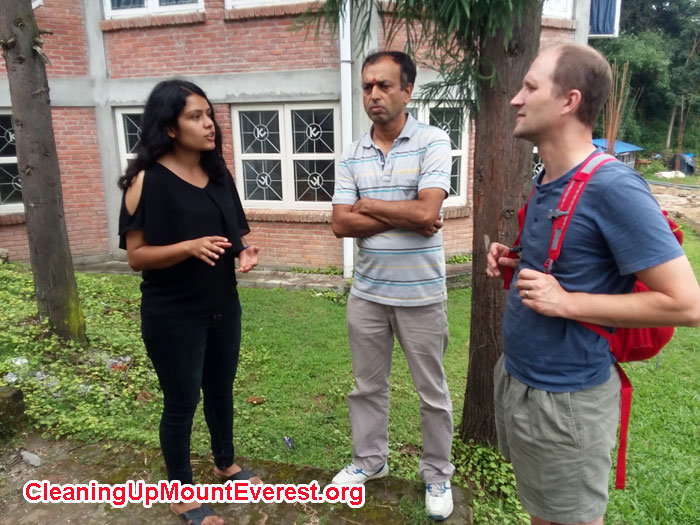
Professors Sunil Prasad (KU), Mike Marsolek (SU), and Bed Mani discuss Everest Base Camp Waste Treatment Research. KU Grad Student Garima Baral, and Mike Marsolek (SU) Looking at Biogas Research Setup at Kathmandu University.
By Katy Scott, CNN - August 6 - Solving Everest's mounting poop problem
The human impact on Everest (CNN)When climbing enthusiasts take a stab at the highest mountain in the world, thinking about their bodily waste is probably low on their list of priorities.
This season, porters working on Everest schlepped 28,000 pounds of human waste — the equivalent weight of two fully-grown elephants -- from base camp down to a nearby dumping site, according to the Sagarmatha Pollution Control Committee (SPCC), a local NGO tasked with cleaning up Everest.
At Gorak Shep, a frozen lakebed 17,000 feet above sea level, waste matter is dumped in open pits where it shrivels and dehydrates. But there is a risk that it will leak into a river and contaminate the water supply system, explains Garry Porter, a retired mountaineer and engineer from Washington state.
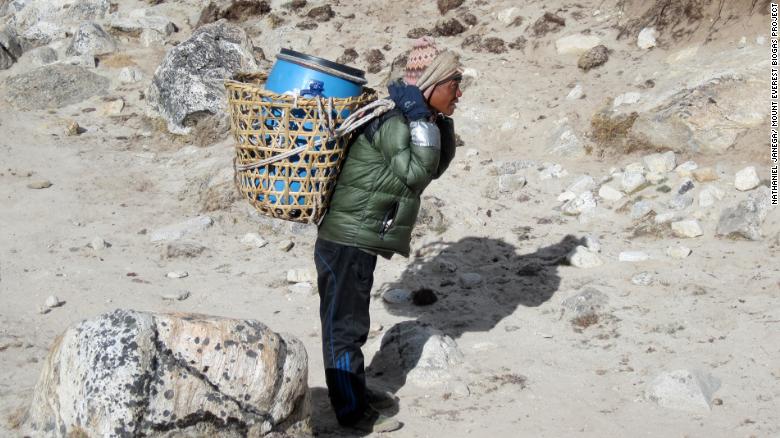
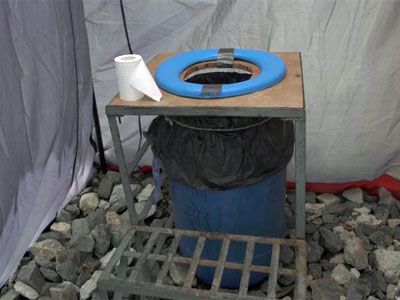
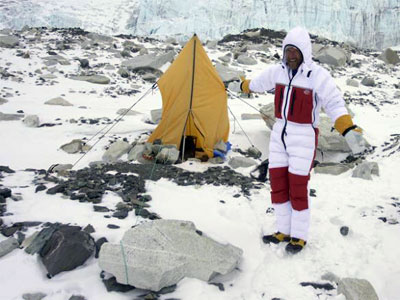
"It's unsightly and unsanitary, it's a health issue and an environmental nightmare," Porter tells CNN.
"I experienced the thrill and grandeur of Mount Everest, but I also saw what happens when we, the Western world, leave, as if our waste doesn't stink."
But Porter doesn't fault climbers, as he says their main preoccupation is summiting and returning home in one piece.
Nor are Nepalese authorities to blame, says Porter, as there are no waste treatment plants nearby.
Yangji Doma, of the SPCC, agrees that the current human waste management system is problematic.
"We make sure that it's not dumped on the glacier itself," she tells CNN. "But the main problem is ... it's very cold and it doesn't naturally degrade, we understand that. It's managed but it's not sustainably managed."
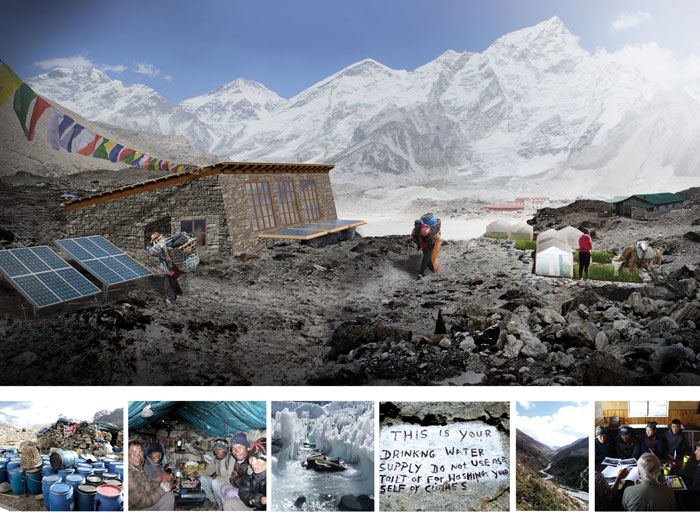
Photo Bio Gas Digester
So Porter, along with fellow climber Dan Mazur, established the Mount Everest Biogas Project almost eight years ago to try get rid of this "environmental hazard."
Over the years they have been toying with the idea of installing a biogas digester at Gorak Shep to convert human waste into methane gas.
While biogas digesters are used around the world, and fairly easy to make, they are difficult to operate at altitude in sub-zero temperatures.
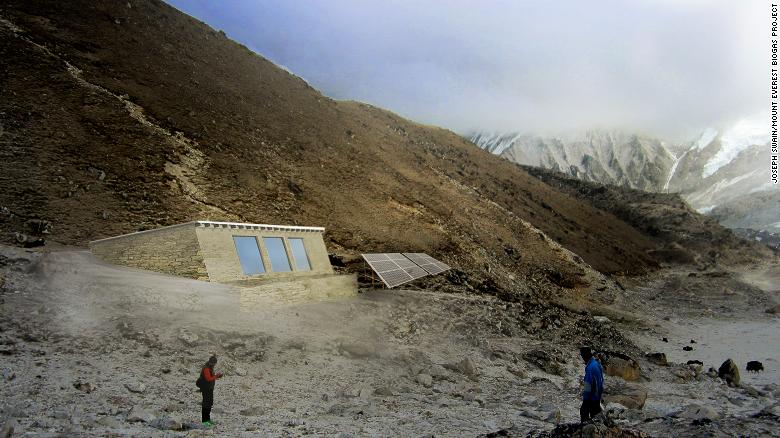
This is because the process requires bacteria to feed on organic waste, and these living microorganisms need to be kept warm, explains Porter.
The Mount Everest Biogas Project plans to use a solar array panel to transmit heat into the digester. There will also be a battery array to store energy at night when the sun sets.
Rendering of the proposed biogas digester.
The end products will be methane gas, which can be used for cooking or lighting, and effluent that can be used as fertilizer for crops.
"It takes a nasty product and makes two products that can be used by the Nepali people," explains Porter.
However, Porter says climbers often take antibiotics, and he was initially concerned that antibiotics in the poop might impact the microbes' ability to break down the waste.
But he says mini digesters at Kathmandu University successfully converted human waste from base camp to methane gas.
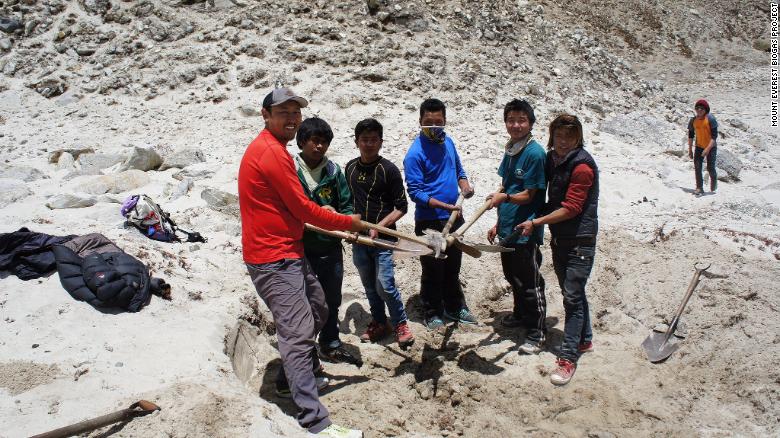
The team still needs to test whether the effluent will be free of hazardous microorganisms and therefore safe to use as fertilizer. Porter says they will begin testing the effluent this year and if it is dangerous, the plan is to filter out contaminants in an underground septic system.
Read: Rebuilding a Nepali village, one block at a time
Researchers from the Mount Everest Biogas Project test soil at Gorak Shep.
The Mount Everest Biogas Project has a signed agreement with the SPCC and is ready to break ground once they have raised the necessary funds.
Porter estimates that the first digester will cost around $500,000, mostly because of the transportation cost to lug the materials up to Gorak Shep.
Thereafter the cost will come down and Porter plans to "hand the keys" to the SPCC.
Doma hopes the project will be a success: "It is a very innovative solution to address human waste in the long run, because right now the way we do it is not that good. It is not sustainable."
For Porter, it is about paying off a debt to the Nepalese people.
"I was part of the problem, so hopefully now I can be part of the solution," he says.
Mount Everest Biogas Project was announced as the overall winner of UIAA Mountain Protection Award during the UIAA General Assembly in Shiraz on Saturday 21 October.
The United States-based project is a volunteer-run, non-profit organization that has designed an environmentally sustainable solution to the impact of human waste on Mt. Everest and other high altitude locations. The Mount Everest Biogas Project (MEBP) is the fifth winner of the annual Award joining projects from Ethiopia, Tajikistan, Nepal and France.
The Mount Everest Biogas Project is a deserving winner of the Award,” explained UIAA Mountain Protection Commission President Dr Carolina Adler. “Waste in the mountains is a real problem that calls for implementation of solutions to address and test it under often very challenging environmental and social conditions.”
Stephen Goodwin, member of the UIAA Mountain Protection Commission, a vice-president of the Alpine Club (UK), and one of the Award assessors, added: “The Mount Everest Biogas Project project perfectly meets the aims of our Commission in that it is clearing up the waste of mountaineers and trekkers in an iconic location. There are multiple benefits for the “downstream” Sherpa population (notably less polluted water) and providing the project proves a success this technology can be applied to other high altitude mountain locations where climbers and/or trekkers have created a waste disposal problem.”
For the Award winners themselves, this is recognition for seven years of intense work and development towards helping resolve the major issue of ‘what to do with human waste in an extreme environment’. Garry Porter, one of the project’s co-founders, explains the potential benefits of winning the Award: “The Mountain Protection Award is a huge morale boost to our volunteer team members because it acknowledges their efforts in addressing a solution to the issue of human waste in mountains. The prestige of an endorsement by the UIAA will provide a major boost to our fundraising effort.”
Please watch New Video of Keeping Mount Everest Pristine with Mike Marsolek
Please watch New Video of Mt. Everest Biogas Project-Converting human waste to metha
Please watch New video of, Professors Making Biogas in the Laboratory at Kathmandu University.
The Mt Everest Biogas Project kicks off their fall fundraiser with this exciting news. Please show you care about cleaning up human waste on Everest!! Get involved today at:
Proposed Location and Design of Everest Base Camp Biogas Shelter in Gorak Shep, by Joseph Swain.
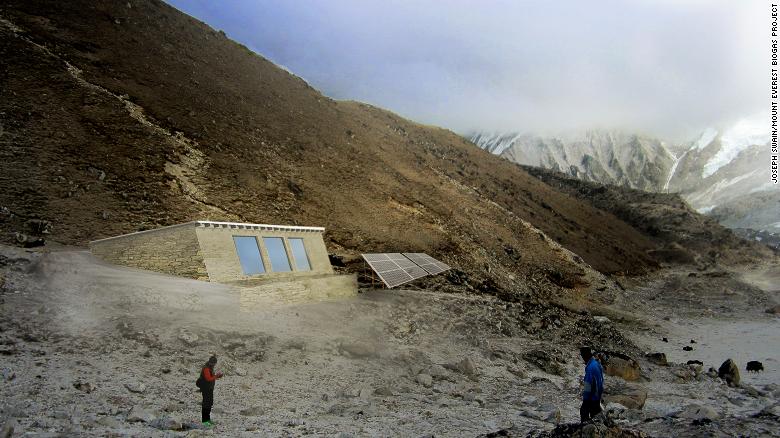
------------------------------------------------------------------------------------------------------------------------
CLEANING UP MT. EVEREST (Converting poop to power)
Climber decending to southcol after summit. Photo Mike Fairman. Just a bit of the rubbish collected from basecamp and Gorak Shep being burned and processed for transport to lower altitude.
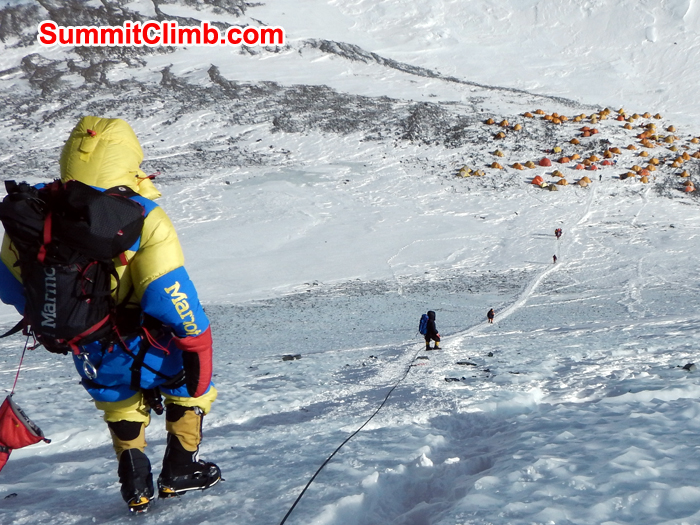
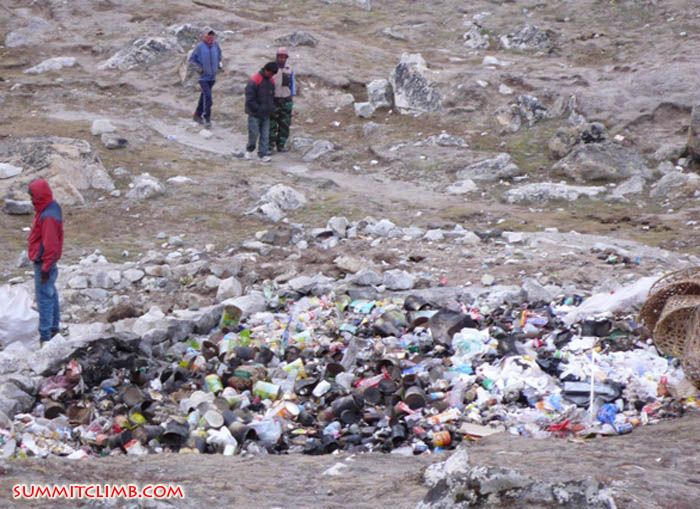
Climber decending to southcol after summit. Photo Mike Fairman. Just a bit of the rubbish collected from basecamp and Gorak Shep being burned and processed for transport to lower altitude.
Thanks to the support of many of you who have been following this campaign, the Mt. Everest biogas project volunteers made the trip to Nepal and ultimately to Mt. Everest base camp for a few of us. We have been back for a little over 2 months and I want to update everyone on the incredible progress that we made on this trip. It is hard to know where to start other than by saying that we accomplished more in this trip than anyone ever expected. And it would not have been possible without the generous contributions of many of you.
So let me summarize the trip first and then provide a link to our new Facebook page that was developed along the way to Everest base camp by one of the volunteers on the trip. She writes much better than I, so bear with me while I try to summarize what was accomplished. So here goes.
A major milestone was achieved when we met formally with the two agencies Sagamartha Pollution Control Committee (SPCC) and Buffer Zone Committee (BZC) that control who and what can be built within the Mt. Everest National park. This was a key meeting in that the biogas project needed their approval to build at Gorak Shep or all the design effort over the past 6 years would be for naught. We met in Namche Bazar, they listened, they liked what we were proposing to do and they signed a three party memorandum of understanding with us. Equally important, they agreed to take ownership of the biogas system following construction at Gorak Shep which was a critical "exit strategy" for the team. We were elated after the meeting because this was the formal go ahead we needed.

Basecamp panaroma at trekkers rock. Mike Fairman Photo
Then on to Gorak Shep and along the way, we met with other members of BZC and ultimately the teahouse owners at Gorak Shep. Incredible support from everyone we talked to. We were flying high by the time we got to Gorak Shep even though we were at 17,000' and the elevation was starting to show its affect on us.
At Gorak Shep, we briefed the teahouse owners on the design and then laid out the planned location of the biogas system. Part of the plan was to dig a 6' deep hole to run water infiltration tests but unless you are fully acclimated to the altitude, that is a tougher job than we planned. Fortunately, 8 young volunteers from the tea houses helped us and in 3 hours it was done. Then on to Everest base camp before heading down mountain. Anyway you cut it, the hike/trek to Gorak Shep is tough. Hiking down is not much easier because the distance still has to be covered.
Back in Kathmandu, the trekking team met the rest of the biogas team who had been meeting with potential subcontractors and re-affirming their interest in the project.
One final stop at Kathmandu University before heading home. It has been the intent of the project to ultimately involve the academic community in the biogas project A Seattle University engineering professor, who is part of the biogas team, has established a formal relationship between Seattle University and Kathmandu University to conduct lab/bench level tests of the actual human waste from Everest base camp. The project has predicted performance data but the testing and resultant test data would answer the question, "will the system work at Gorak Shep"? The testing started a year ago, shortly after the earthquake in Nepal and the students have struggled with the project. Not exactly a pleasant engineering test program but they persevered and when we were there, they showed us clean burning methane gas produced from the human waste from base camp. Great way to finish the trip.
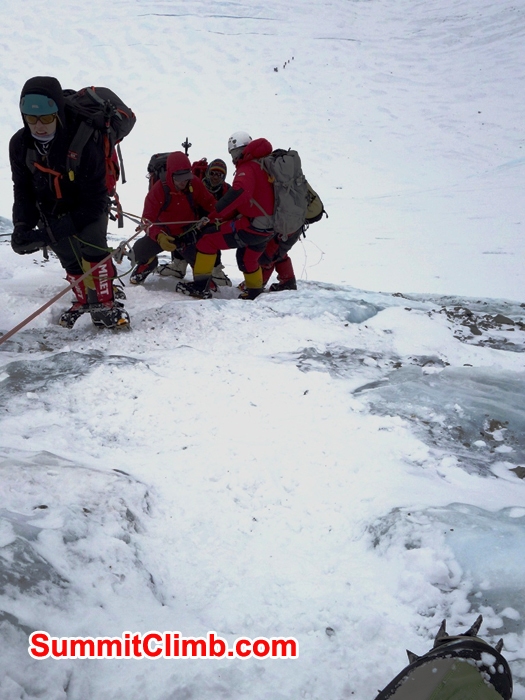
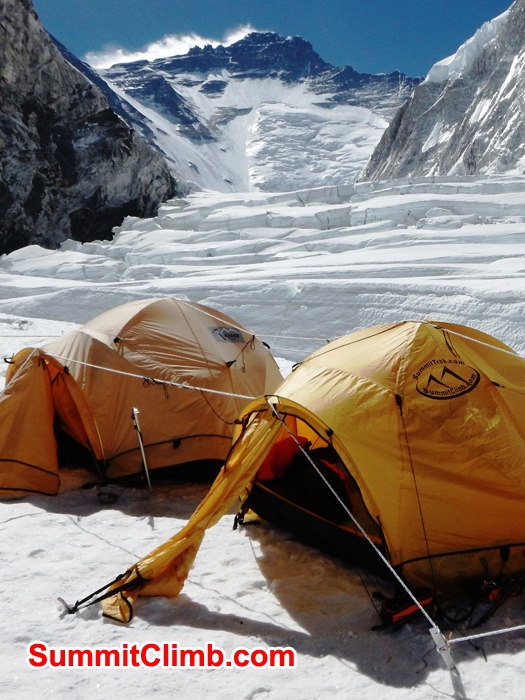
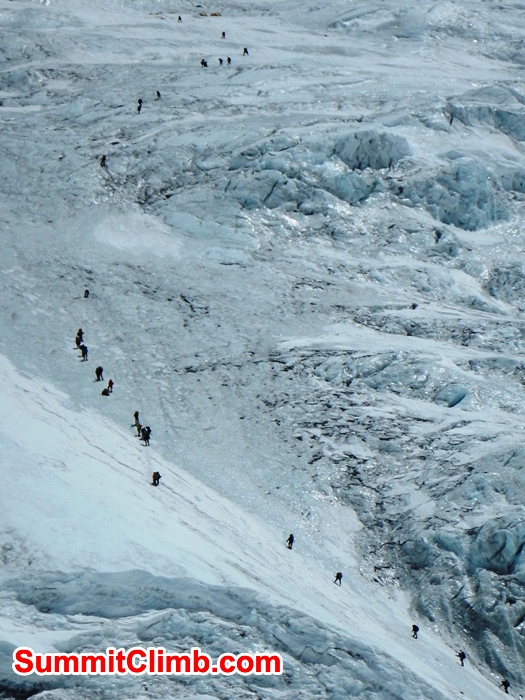
Ascending team overtakes descending team on Lhotse Face. Franz Ruehrlinger Photo. Camp 1 with Mount Lhotse in background. Mike Fairman Photo. Climbers on the Lhotse Face. Mike Fairman Photo
For a much more detailed day by day trip report, please go to the new Facebook account called The Mt. Everest Biogas project. Lots of pictures and written with great enthusiasm by one of the team members, Brenda Bednar. I hope you enjoy her writing and can feel the excitement that we felt.
I will try to provide more frequent updates as we move into the next critical phase of the project: fund raising for the construction at Gorak Shep. If we are successful in raising the funds, construction could start as early as next spring.
------------------------------------------------------------------------------------------------------------------------
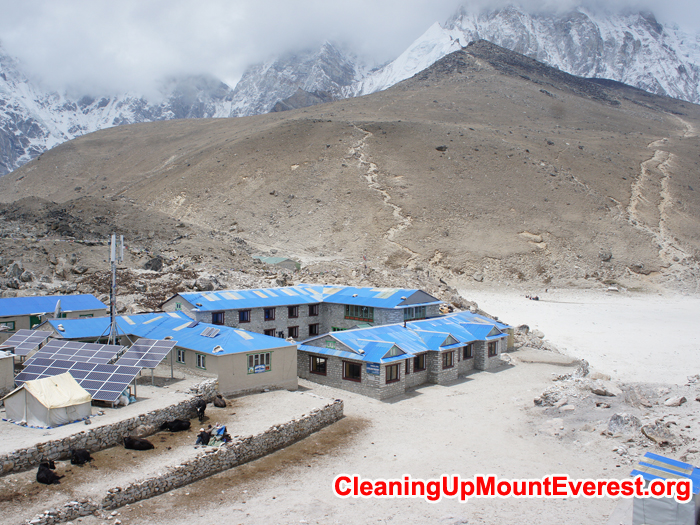
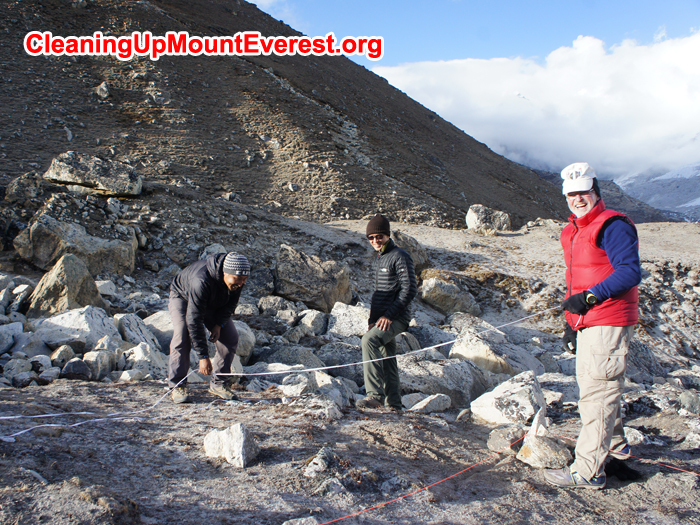
Gorekshep is going to base for Biogas. Measuring the area at gorekshep. Photo Joe Swain
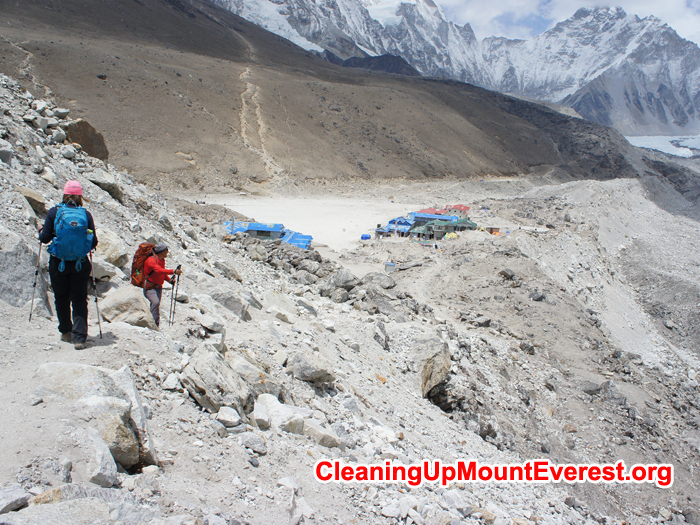
Working hard for BioGas project at Gorekshep
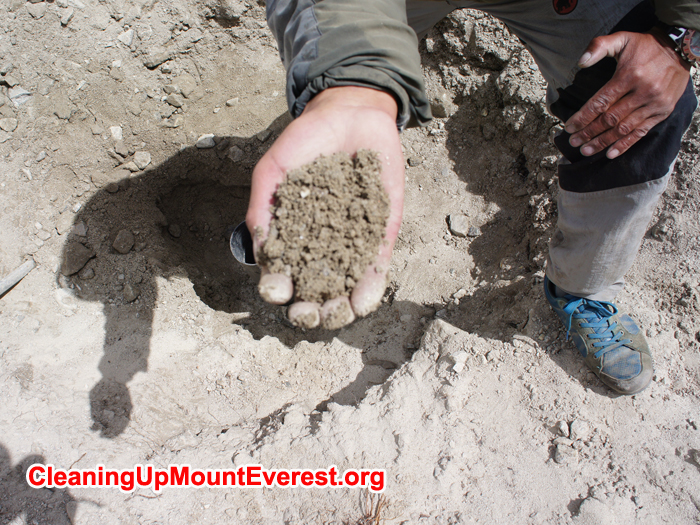
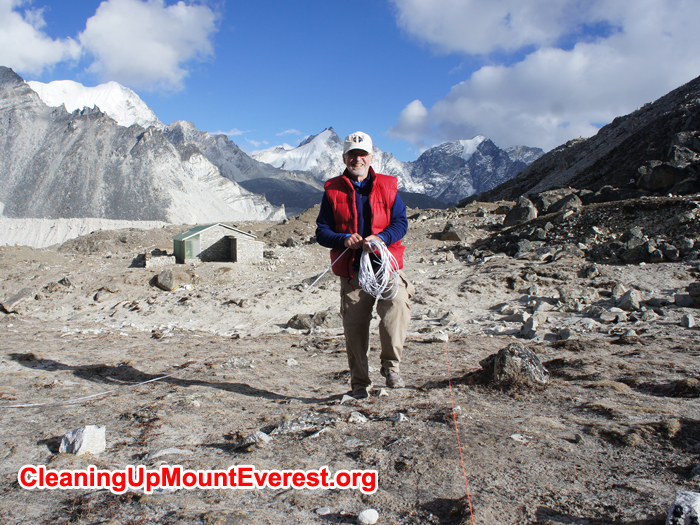
On going research. Research for the soil test.
-------------------------------------------------------------------------------------------------------------------------------------------------------------------------Nepal Running Journal The Mt. Everest Biogas Project : Joseph Swain, Project Lead, Architects Without Borders-Seattle
This is a daily log of the May 4-26, trip to Nepal by MEBP team members Garry Porter and Joseph Swain, along with travel companion and Honorary Social-Media Coordinator Brenda Bednar. As availability of internet and computers will be inconsistent on the 17-day trek through the Khumbu Valley, posts will be written daily but uploaded when possible. Posts will eventually make it to the project website, facebook page, funding page, etc., along with photos.
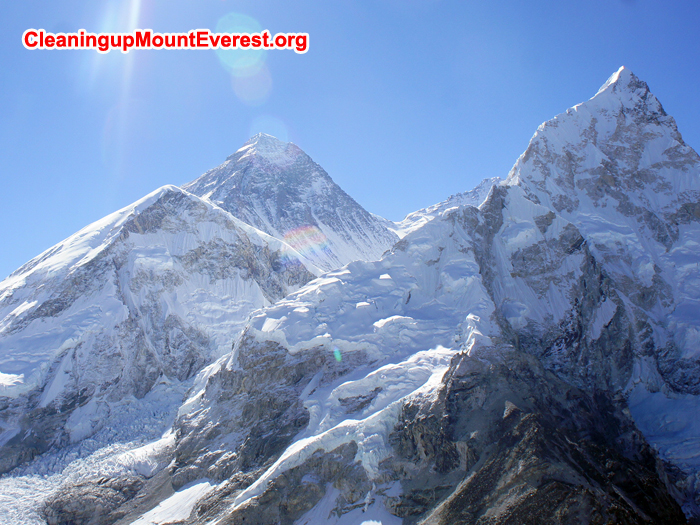
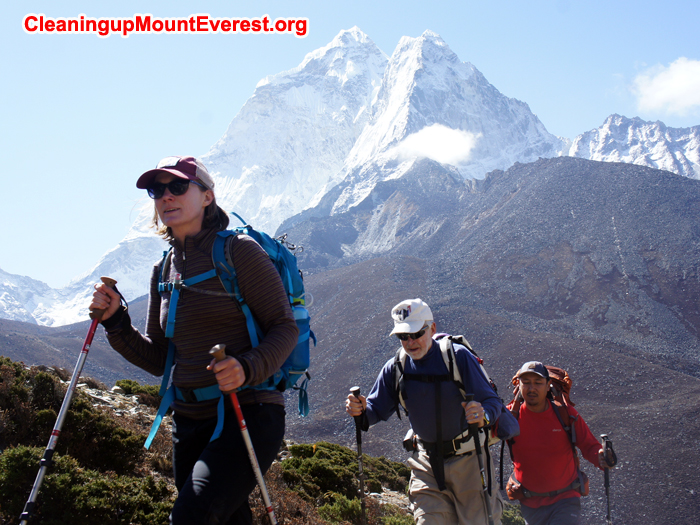
Everest, Nuptse seen from Kalapather. Trekking to Everest Basecamp
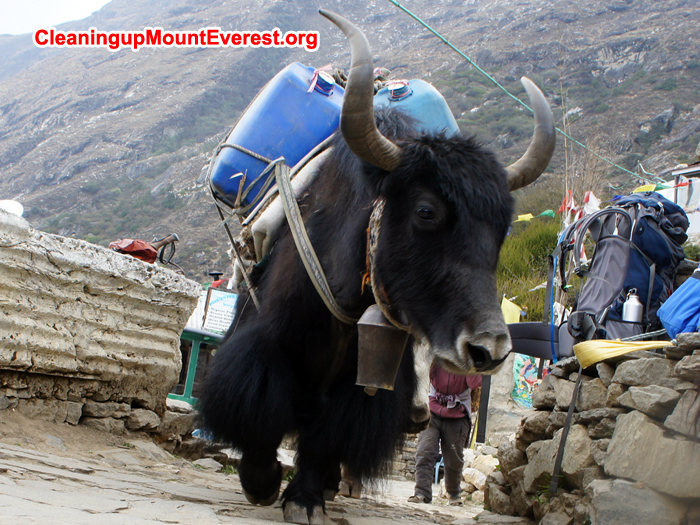
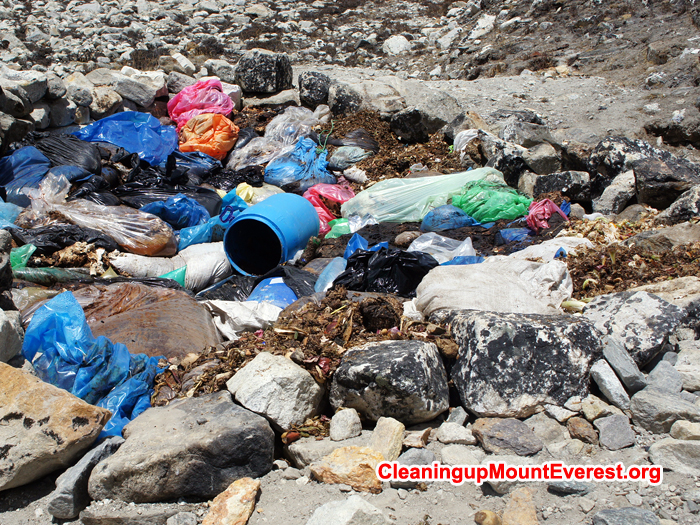
Yak carrying load to Everest Base Camp Waste store at Gorekshep Wednesday,
May 25
On Monday I had gotten in touch with an American-Nepali NGO called Portal that is working in Kathmandu. They started out a couple of years ago fabricating custom utility bicycles that could transport large loads, gas cans, corn huskers, etc., and selling them to locals who needed them subsidized and on micro credit. I was interested in working with them to develop a method for converting the excess paper and plastic bottle waste up at Gorak Shep into a form of cellulose insulation.
Our design currently calls for a thick cavity wall for site-manufactured insulation of about R-1 per inch, and the assumption is that we can shred the trash into fine enough strips and place them into a the ubiquitous rice or utility bags to make insulation "pillows" for the cavity wall. My thought was that if Portal could make a pedal-operated corn husker, they might also be able to create a pedal-operated paper and plastic shredder that we could wheel up to Gorak Shep.
I met Caleb Spear, Portal's Executive Director, at their steelyard/workshop early int he morning. Their yard was full of steel wide flanges, which will soon be part of their new workshop/warehouse. I soon learned that after the earthquake last year, Portal switched gears, so to speak, from bike design to emergency and permanent steel shelters. They have some prototype quonset-style shelters in their yard which are little more than steel pipe and corrugated metal sheets, but can be transported in a truck and erected extremely quickly. They also have a permanent kit that consists of frames, chainlink fencing, and corrugeted metal roofing. The frames are welded and bolted HSS, about 2"x2". The prefab systems are impressive not only in their compactness, but also the speed in which they weere designed and developed. Caleb said they have more than one hundered orders for the more permanent shelters, but they are on hold because of a bottleneck at the government approval level. This was a common theme with respect to relief efforts throughout our visit to Nepal - there are a lot of resources and hands ready to help, but the government can't act quickly enough.
Portal has a handful of workers and interns who can cut, weld and fabricate steel parts, most of whom are from very disadvantaged families in the area. There are a handful of westerners, some of whom are volunteers. As we talked about construction and steel fabrication in Nepal I helped the entire crew of about 10 reorganize and move their steel wide flanges by hand. I hadn't planned on doing any physical labor during my meeting, but it felt good to get some sort of workout in, as this was my fourth day in Kathmandu and I was feeling energetic, thanks to all the oxygen here (despite stores selling running and workout gear in Thamel, there aren't any good places to go running in the city, according to Mingma).
I showed our MEBP designs to Caleb and Emily, another American who was working on site. They were generally supportive and liked the idea of creating a pedal-powered shredder for our insulation. Caleb said the mechanism would be pretty simple to build, and changing gears could mean we could control how much speed or torque we put into the shredding attachment. What that attachment would be remains to be seen. He sent me to a local market where I took some photos of some off-the-shelf hand-operated grinders and such.
The cost of building a bike-shredder to Portal's standards would probably be in the $300 range. Caleb also thought the idea of trusses site-fabricated out of smaller pieces and bolts could work. I liked this idea because it would mean we would be using less wood, a rare resource in the upper valley, and we may be able to get a longer span for the same transported weight. Portal also seemed like a great place to look if we need custom-fabricated steel parts, say, for steel-to-stone attachments. Being able to communicate with them in English could be huge when we are under construction. When we have a better idea of our construction timeline, I will be in touch with them about these things.
After my meeting with Portal, I went back to the hotel to pack and run some errands with Brenda. In the meantime, Kirk, Garry, Nate and Mingma met the researchers at Kathmandu University and with engineers at Gham Power. Both meeting went very well, particularly at KU. One of our last hurdles (after getting our partnerships and approvals hammered out the previous few weeks) before fundraising was the looming question of whether we could get actual climber waste to break down and produce methane in a controlled environment. In May , Mike Marselek had gone to KU for us to set up some experiments with climber waste transported down from EBC by Dan. As of last month, there had been no measurable amount of methane. However, in the past few weeks, some new experiments using dow dung as a starter innoculum have allowed the climber waste to produce a significant amount of methane. I was told Mingma has a video of it burning in the lab on his cellphone. In any case, this is great news for the project. We will need to write about this more in-depth in a later post.
With all this exciting news, it was hard to believe that we had to leave today, but Garry took off at 7pm tonight and Brenda and I flew out of Kathmandu at 11:15pm. Kirk and Nate will be in the city until Saturday to finish their round of meetings. Everyone agreed that it has been a fruitful couple of days, especially with the entire team overlapping in one place.
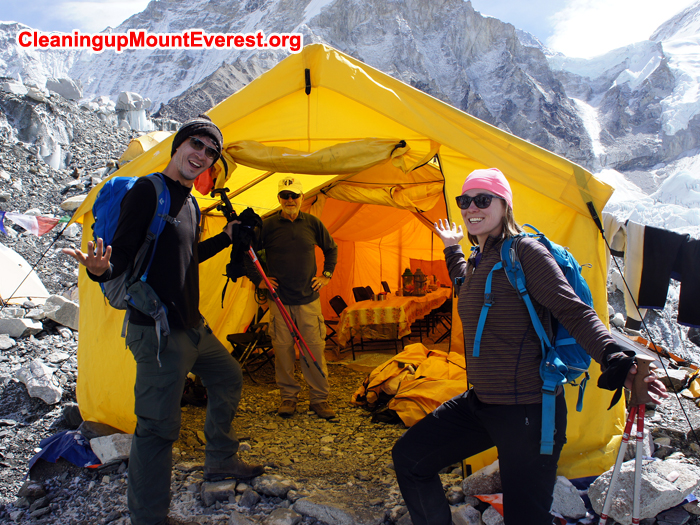
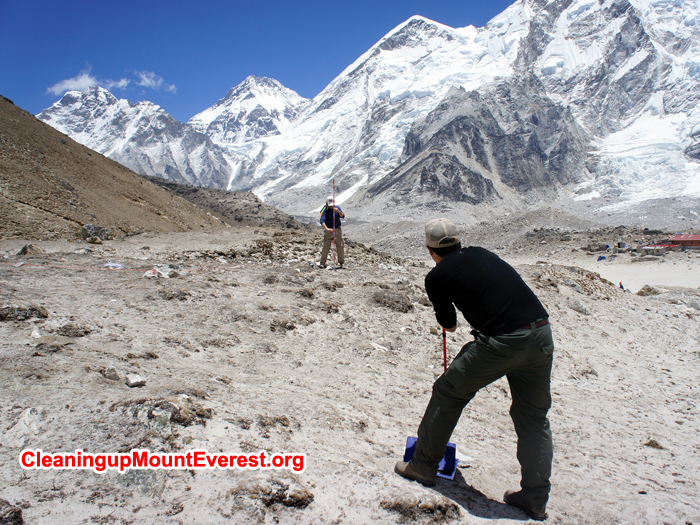
Team reach Everest Basecamp. Team working at Gorek Shep Everest Cleanup project. Tuesday,
May 24
Kirk and Nate had scheduled a big meeting with the Biogas Support Partnership - Nepal organization (BSP-Nepal) that has overseen the construction of thousands of biogas digesters in the country. BSP provides support, expertise and instruction to communities and builders, but is not in the business of building biogas plants themselves.
Kirk, Mingma, Garry, Nate and I had an early lunch meeting to go over the agenda and what we hoped to accomplish before heading out to BSP's offices. Our primary goal was to get a nod of approval for our technical strategies and an agreement that we could move forward with the design with the expectation that BSP would provide their support services at Gorak Shep.
Overall the meeting went very well. We met with an assistant director, Mr. Prakash Lamichhane, who expressed excitement over the project, especially the prospect of building a "historic" working biogas system at 17,000 ft. Kirk summarized other points of the meeting as follows:
In the evening, the entire team went out for a celebration dinner with Mingma and his family, as Garry, Brenda and I are to leave the next day. We went to a family restaurant of Mingma's choosing, Alice, where we tried an array of Nepali specialties, including several thali sets, curries, momos (spinach and buckwheat) and soups. We were joined by the head of the Khumjung Buffer Zone Committee, who happened to be an old classmate of Mingma's. As a thank-you gift, Brenda and I had had t-shirts custom stitched with the MEBP logo (or a close apprximation) by a local embroiderer. Garry presented these to everyone, including Mingma's family, alongside some smoked salmon from Seattle.
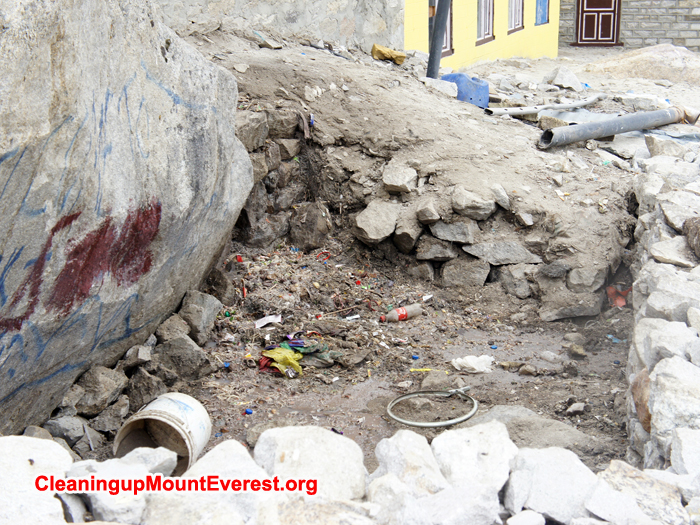
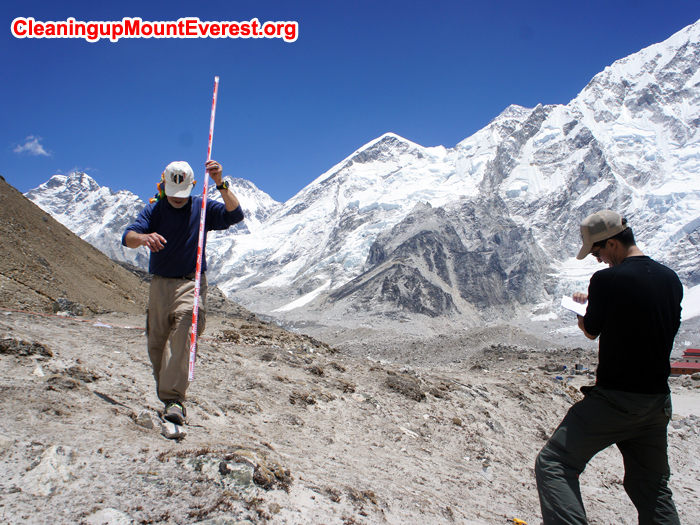
Bit of rubbish at Gorek shep. Everest Cleanup project team working at Gorek Shep.
Monday, May 23
Due to a snafu at the Dubai airport, Nate won't be making it to Kathmandu until this evening. We only had a meeting with Gham Power scheduled for this afternoon, which Nate was able to change to Wednesday instead.
Kirk had booked Mingm's wife as a tour guide for Sarah and Nick, her boyfriend, but Sarah was feeling under the weather, so Kirk invited Brenda and me to go on a half-day tough of the main sights in the city. We first walked through some of the older markets and checked out Durbar Square, a World Heritage site that sustained some serious earthquare damage last year. There hasn't been a lot of permanent rebuilding yet, but one can see masonry walls of nearly all the buildings proppsed up with either steel or wood buttresses. We took a cab to the Boudah Stupa, one of the biggest stupas in the world. It takes about 10-15 minutes to walk around once (clockwise), and we did three laps. This World Heritage site also sustained some damage at the top (the "lotus" and the" pinnacle") but the dome was more or less intact. There was some very impressive wood scaffolding set up on one part of the done to facilitate moving bricks and cement up to the top. It reminded me of the renderings of how Egyptian pyramids might have been built thousands of years ago.
In the evening Mingma and his family met us at our hotel and we walked to a nearby Italian restaurant for dinner. It may have been because we were still coming off of more than two weeks of teahouse food, but the pizzas and salads were incredibly good. Nate landed around 5pm and Mingma picked him up and brought him to the restaurant in time to eat everyone's leftovers.
After a 30-min flight, we landed and grabbed a taxi to our new hotel, the Kantipur Temple House, a hotel Kirk and his daughter, Sarah, were staying at. The place is a little oasis on the edge of the busy Thamel district, with a generous courtyard and garden separating it from the street, and beautiful carved wood and brick details everywhere. It's reminiscent of some Indian Heritage hotels in the architectural quality and service - there are no TVs or AC in the rooms, not that they would be necessary - though the building itself is only 19 years old.
A warm shower and a nap had us feeling like completely new people after 15 days of trekking with the occasional shower. Kirk was waiting for us in the courtyard when we arrived and Garry caught him up on our adventures. We all got together in the evening to make new plans for the coming week over drinks and dinner, though Nate doesn't get in untl late tonight.
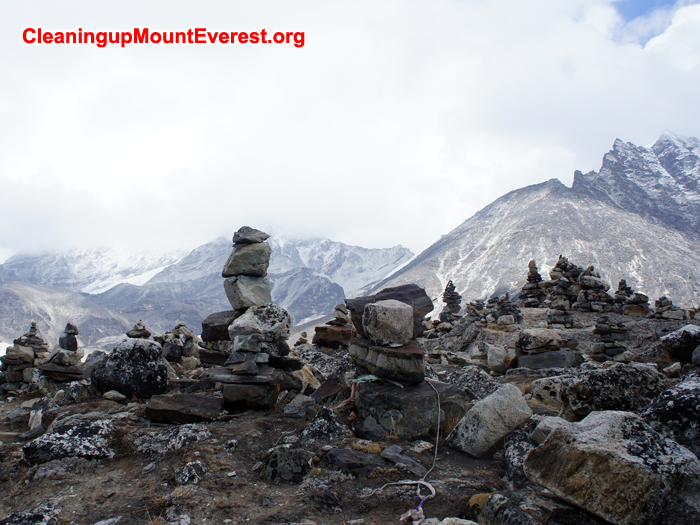
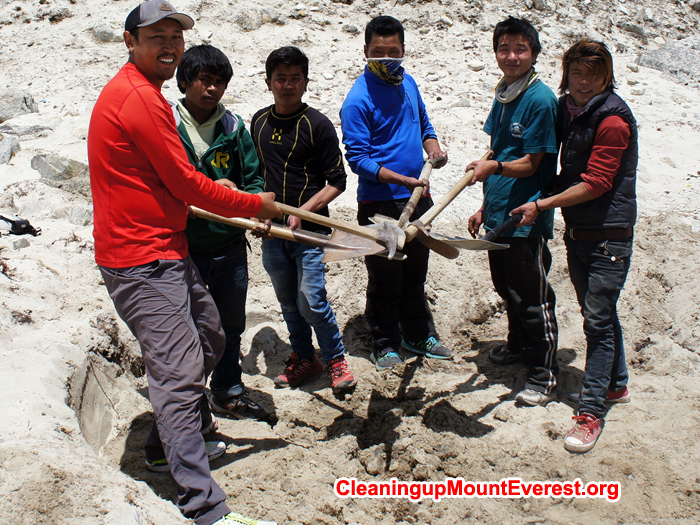
Memorial. Mingma with local for Everest Cleanup project
Sunday, May 22
Mingma was able to secure four seats on a Goma Airlines flight from Lukla to Kathmandu one day earlier than we had planned, so we were up early and were racing down the 18% runway by 8:45am. The sensation was similar to a roller coaster, except when you expect the plane to drop off the end into the valley below, it instead levels out and everyone breathes a sign or relief.
Saturday, May 21
We are exactly one day ahead of schedule at this point. We left Namche Bazaar early to take advantage of the perfect trekking weather - fairly warm and dry. We saw some a famiy of Himalayan tahrs across the river as we walked, as well as some birds we'll have to look up once we get home. After descending down to Phakding for lunch, the sky clouded up. The final three hours of our 15-day trek turned out to be pretty tough, as the route turned uphill and for the first time we experienced high humidity in the valley.
The skies opened up just as we entered Lukla, and we speed-walked through the main street to our last teahouse. It didn't matter that our clothes got wet and muddy, as nearly every piece of clothing we owned was worn through to the end of its socially-acceptable life.
Before dinner, Mingma had us put cash in two envelopes for our porters for tips (about $90 each) and led a semi-formal presentation for us that essentially released the porters from their duties. After dinner, Garry, Brenda and I went to bed early, as we needed to be at the airport to catch our flight out of the Khumbu to Kathmandu (weather permitting).
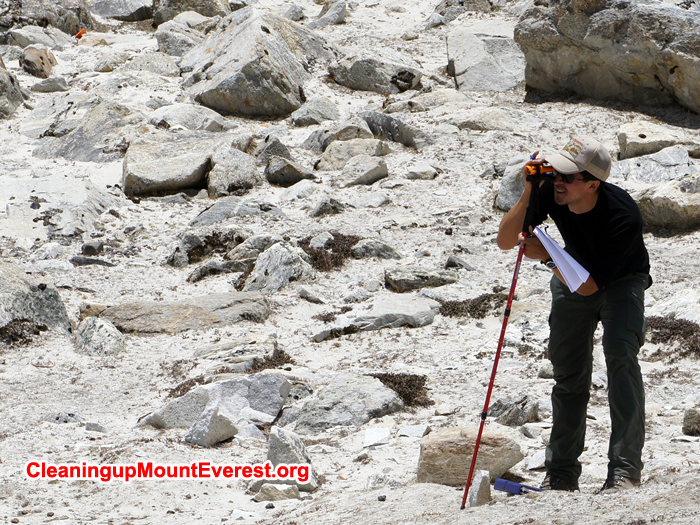
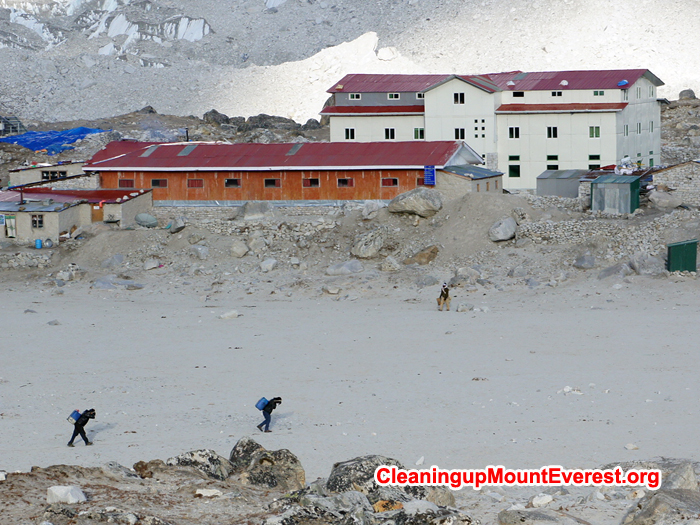
Everest Cleanup project. Gorek Shep Everest Cleanup project.
Friday, May 20
We were all up early on Friday for a 9am meeting with the presidents of the SPCC and BZC, a follow-up to our initial meeting the week before. Mr. Ang Dorjee, the SPCC president, gave us only one minor edit to Mingma, so I ran down to the nearest internet cafe and made the change (the official name of the BZC is the Sagarmatha National Park Buffer Zone Management Committee). A few minutes later we were all shaking hands over sweetened nescafe and signing the MOU documenting the partnership between our three organizations.
By 9:30am our work was done and Garry went to scan the documents and send out the good news. Everyone else took the rest of the day to go shop for souveniers, catch up on emails (Namche was the first reliable internet we have had since .... Namche), and rest up. Nine straight days of hard trekking had caught up to us, and our legs appreciated the day off. Garry also handed his boots off to a cobbler who promised to fix the soles before we left the next morning.
At dinner we celebrated our progress with the Nepalis over yak steaks and Sherpa beer. (Of all the beer we had tried in Nepal thus far, this is our favorite, though it's still a pretty light kolsch-style beer that may or may not be brewed by Sherpas).
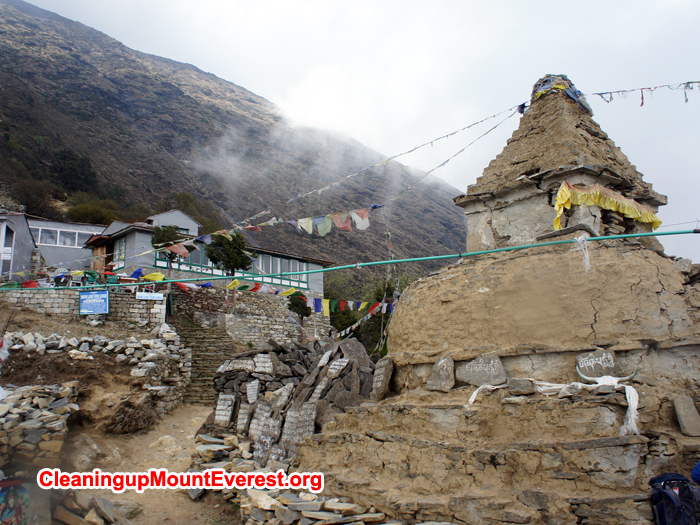
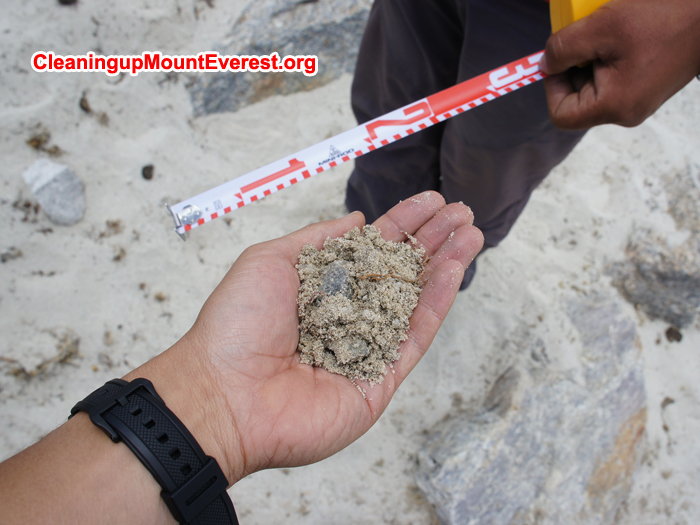
Re-construction need for stupa. Research process at Gorek Shep.
Thursday, May 19
On our way out of Phortse we stopped by the Khumbu Climbing Center. The two-story steel structure is still going up, though most of the first-floor structure is in place now. The site was buzzing with workers, and the site supervisor, Brandon Lampley, was extremely helpful in showing us what can be done in the region, construction-wise. Brandon has a background in the historic preservation and renovation of older masonry buildings in the US, and he said he's been working his whole life to be prepared for this project. Some things we learned from our 90 minutes on site included:
The Nepalis are excellent at problem solving and figuring out new and custom solutions when confronted with a problem, for example, fabricated steel parts.
The cost of a single, perfectly square and flat stone in a masonry wall is about $15-20, as it takes a skilled stone cutter an entire day at about $15/day.
The cost of a decent structural stone without the crisp, square finish is about 1/6 of the perfectly square stone.
Cutting stone is hard on the tools. The KCC team keeps a forge going 24 hours a day to hone their chisels.
Cutting stone is hard on the hands. I found this out after ten minutes of trying to chisel out a flat plan on a rough stone. Carpel tunnel must be one of the more common occupational diseases of the trade.
Steel parts can be fabricated in Kathmandu, as long as one can communicate the design.
Most everything comes from Kathmandu, including cement. However, for slightly less cost, one can sometimes get common materials at the air strip above Namche Bazaar.
Cement costs about $35 per bag in Phortse.
XPS (blue) foam rigid insulation is available in Kathmandu. The thickness KCC was using was around 3cm.
Wire mesh for gabion retaining walls can be woven on site with a makeshift loom and galvanized wire. It's cheaper to carry a roll of wire up the mountain than a pre-welded mesh.
The building season halts from July through September for cultural and religious reasons.
There was plenty more that we picked up, but this was some of the more pragmatic information.
From Phortse we trekked down to the Dudh River to cross and then up an interrupted 1,300 feet to Mong La, a small outpost with great views and a few teahouses. We had a light lunch of curry and dal and then decended slowly to Namche Bazaar. We stayed at the Mountain View Lodge, which is next to Mingma's childhood house. His parents joined him for a momo dinner there (the yak momos were some of the best momos we have had on the trip).
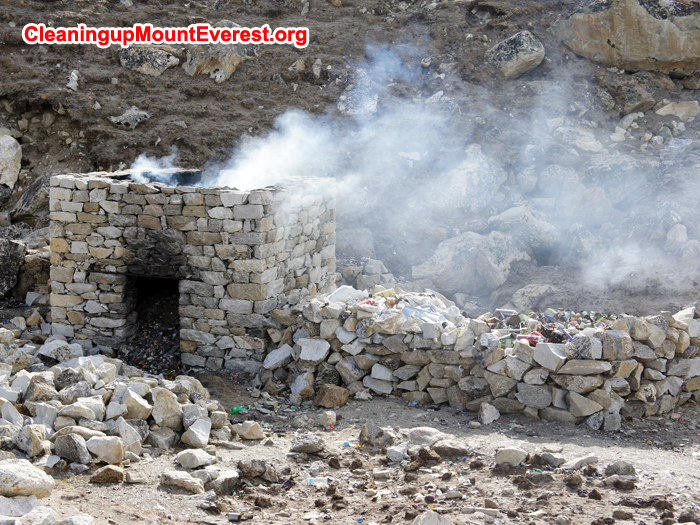
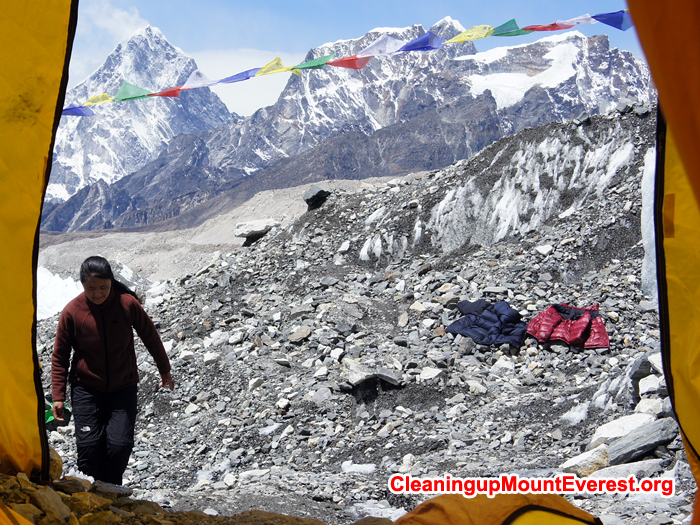
Rubbish were burned in Gorek Shep. Bring water in Tent.
Wednesday, May 18
Today was a straightforward day of trekking down the valley. We took a different route than the way we came up because we wanted to check out the Khumbu Climbing Center in Phortse, an ongoing construction project that was developed by the Alex Lowe Foundation and designed by students at the University of Montana. The two-story structure was designed to US standards, with steel structure and masonry walls. We arrived in Phortse too late (and just before a huge rainstorm) to check out the KCC, so we rested up for the trek tomorrow.
Tuesday, May 17
Twelve hours and 23km brought us from Gorak Shep to Everest Base Camp (17,200 ft) and then down to Pheriche (14,000 ft). Today featured a temperature swing from around freezing to blazing hot coming down from the glacier and back to a snowstorm for the final 90 minutes of trekking.
We arrived at EBC after about two hours of walking, and the camp mostly lived up to its reputation of disappointing thousands of trekkers every year. The glacier is covered with hundreds of tents from all corners of the world. We didn't see many climbers, just a few staff, as most everyone has either summited already or is on the upper mountain for a summit attempt. The most interesting things are the stonehenge-like ice structures that make up the exposed part of the glacier, as well as the massive boulders precariously perched on top of slowly melting ice pillars.
We slogged through the rock-chip path that winds between the camps until we found Dan Mazur's Summit Climb camp. Dan is a founder of the MEBP alongside Garry. Dan was leading his group of 10 climbers up around Camp 2 at the time, but we were able to say hi to him from the camp radio. We were then generously treated to tea by his staff, which included a two-course meal of ramen noodles, omlettes and toast. Afterward, Garry took photos of every outhouse tent he could, as well as porters carrying blue-barrel waste.
From EBC, we began the long trek down to Pheriche. The trek was fariyl quick, as it was nearly entirely all downhill. However, there were some difficult passages with long, steep steps, and somewhere between Gorak Shep and Lobuche Garry's 20-year-old boot soles gave out. After some quick tea in Dughla, we found ourselves in a dense snowstorm that included some motivating thunderbolts. By the time we arrived at our teahouse in Pheriche (The "Edelwiesse"), there were 2" of snow on the ground.
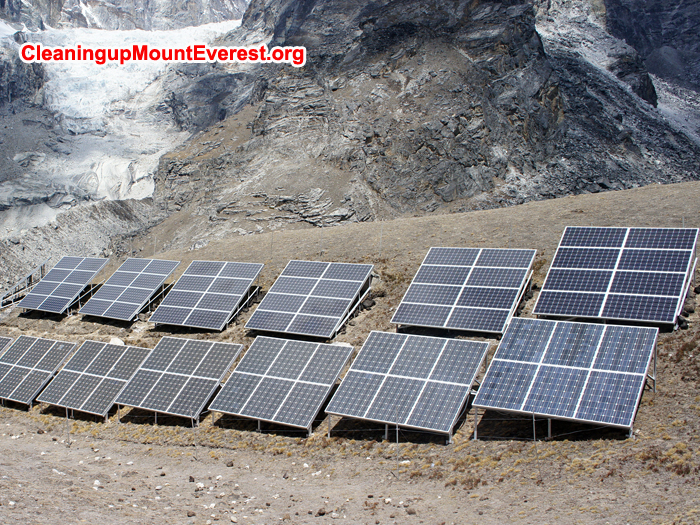
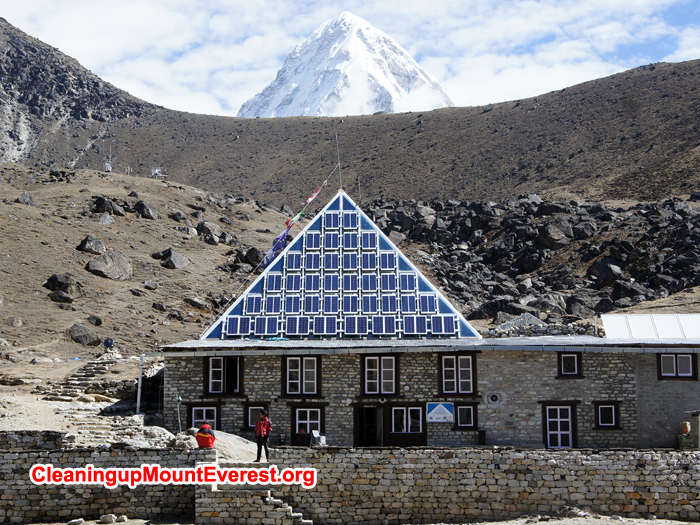
Solar power system in Khumbu valley. Solar power system in Khumbu valley.
Monday, May 16
Garry, Brenda and I began our second day in Gorak Shep by climbing the famed Kala Pattar "hill" that peaks at 18,200ft and has fantastic panoramic views of the surrounding mountains and lakes and has one of the best views of Mt. Everest, which interestingly is hidden from view during almost the entire EBC Trek. The climb was harder than advertised, but the views were as good as advertized, thanks to perfect weather.
Garry, Mingma and I then met for a quick brunch after getting back to the teahouse and we went out to the site and organized some teahouse helpers who began to dig a 5-ft pit below for our percolation tests. As the local guys dug (Garry and I tried for a few minutes - there were a lot of rocks), we took our surveying equipment up and took down the relative elevations of our 2-meter grid, which we will later use to create an accurate contour map. It turned out that the labor was donated by the Teahouse owners of Gorak Shep - a nice little initial investment into the project. After the pit was dug, we did some preliminary charging of the hole for our perc tests.
In the afternoon we had a meeting with the owners of the four teahouses in Gorak Shep. Like in our previous meetings we explained the project, why we are working on it, and why we think it will technically work. Overall the owners were all very appreciative and only had positive feedback. They had a few suggestions for getting the shelter more sun exposure, including turning it to the southeast instead of southwest, and also incorporating skylights. They indicated that there are people in town who would be willing to operate the digester year-round and they offered any help they could.
Perhaps the best feedback from our meeting was a field trip with the owners to the site to look at the outline we laid the day before. Other than the suggestion about turning the building more to the east, they approved the site and the way the building would fit in with the existing ones.
After our meetings, Garry and I were invited to tea at one of the teahouses by the owner, Mr. Pemba. We spoke with his son about the project, and eventurally Garry was talking about the project to a handful of people who would later show other international visitors the idea (more on this later).
Finally, after tea, Mingma, Garry and I went out to our fresh pit and ran the percolation tests as best we could with the equipment we had (Mingma ran water in jugs for each interval from the town water source). We took down the raw data and hopefully it will be enough information for Trae to work with. Everyone we talk to is up on the idea of a vegetated field/pen thatmight absorb the effluent more safely and more productively than just putting it into a drain field.
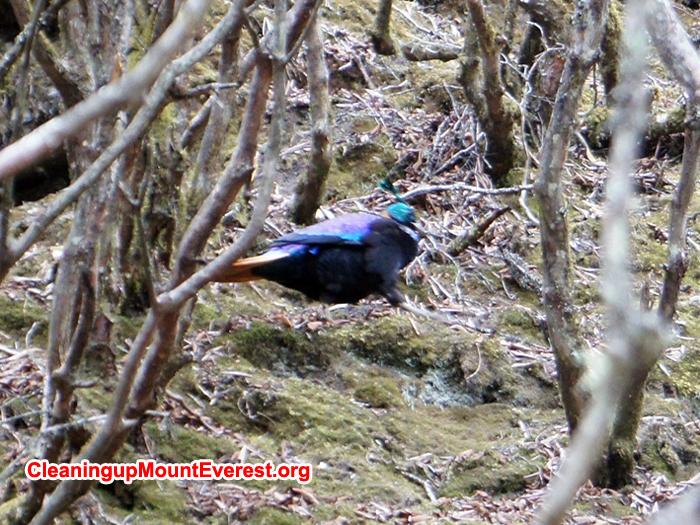
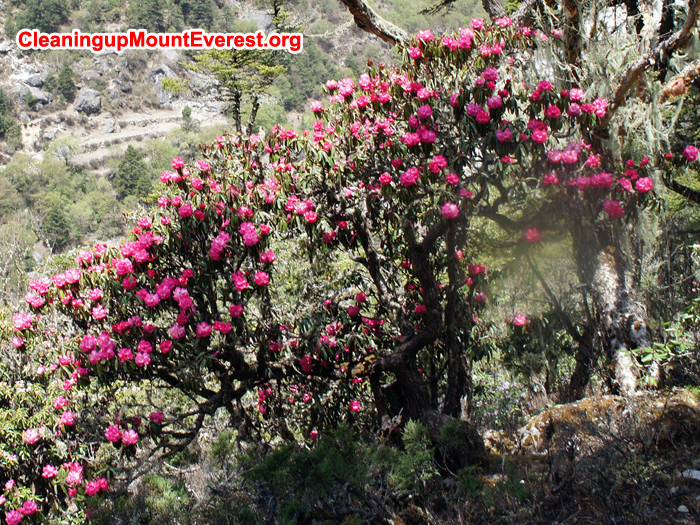
Spring Bird. Spring Flower on the way to Everest Basecamp.
Sunday, May 15
Today was one of our most active days so far. We had an early breakfast at our lodge at Lobuche (we still couldn't figure out how they could ruin oatmeal, but it was the least satisfying breakfast of the trip to match out previous dinner). We then trekked toward Gorak Shep, taking a detour to the famous Italian Pyramid, a climate and geological research facility not far off the path.
Mingma had an "in" at the Pyramid, as he used to be a manager there. The current director was generous to show us around the 25-year-old facility which is essentially a glass pyramid covered in solar PV panels sitting on a traditional stone plynth where the researchers live. They take temperature, wind, insolation, ground temperature, etc, from points around Everest, as well as from seismic sensors. Although some of their data would undoubtably be useful to our project, they only give it out if we ask and get approval from their central office in Bergamo, Italy. Gary was particularly interested in the fact that they had a total of 43kW in solar PVs on the building and off to the side. All panels either pointed east or south, contradicting other information we were given suggesting we orient our panels to the south and west.
After tea at the Pyramid, we moved further up toward Gorak Shep (17,100ft) with another detour to check out the current active dumping pits the blue-barrel porters usewhen coming from Base camp. The pits were fairly small and unassuming at first, but as we got closer, the smell and the breadth of the dump was apparent. There were four pits, several already closed up. More concerning was that the dump site was right alongside an outlet for an adjacent glacier. Mingma confirmed that in the monsoon season, water flows freely along this bed.
After a couple more climbs and a glacier crossing, we finally arrived in Gorak Shep, which may have the highest hotels in the world. Our teahouse was so new it could only be described as incomplete. There was furniture and building materials scattered around the building and the dining area hadn't been furnished. However, they had double-paned windows in place (albeit with small holes in the frames that let in a draft) and our rooms were furnished with beds if not totally painted. Mingma explained that this was one of the nicer accomodations in Gorak Shep, and it was clear that with average food it definitely beat our lodging last night.
After lunch and a quick nap, we went out to our proposed site at the western foot of Kala Patar and discussed how well it would work. Nate Janega had already scouted out the site with Mingma, but hadn't confirmed it had good winter sun exposure. There is a large hill to the south and west of the site that looked like it would likely cut off the afternoon winter sun exposure, possibly the most important time to absorb passive solar energy. We checked out a few sites higher up and further from town, but these were very rocky. Finally, we ended up jury-rigging my sight level with a bubble level app on my android phone to determine that the ridge at the original site would work just fine and we'd only lose some late afternoon winter sun.
Having agreed on the location for sun exposure, slope, and lack of huge, obvious boulders, we set out to outline the footprint with some colored construction line. We used rocks as corner pins and squared the foundation footprint diagonally. At this point the sun had come out again, so we prepared the site for a simple contour survey by laying out a 2-meter grid, marking each point with a stone set into the ground. The site is tricky, as it drops off for a couple of meters on three sides of the building, so it's not entirely clear how the drainfield would be situated. However, the site of the building itself is much flatter than anticipated. Tomorrow we will use our hand surveying materials to measure the relative heights of the points of the grid to develop some fairly accurate contours to work with.
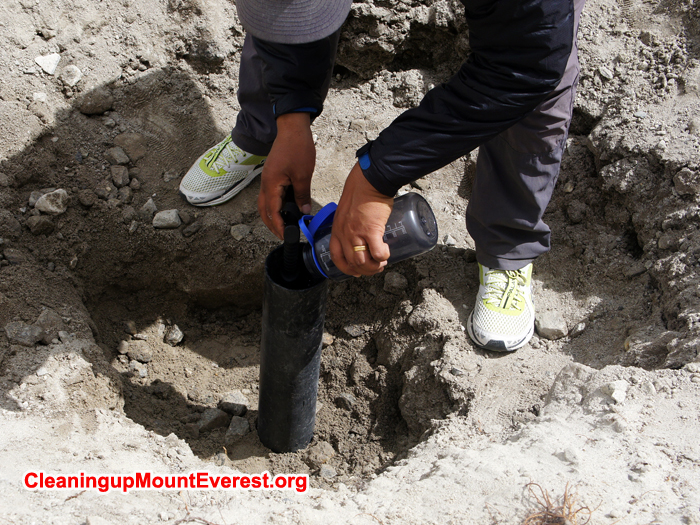
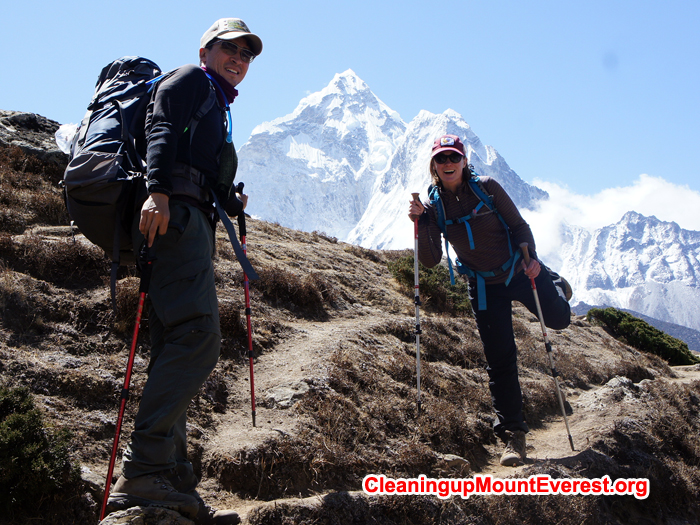
Taking sample for Everest bio gas project. Team enjoying.
Saturday, May 14
We left Dingboche with absolutely perfect weather. For the first time we had panoramic views of the surrounding mountains. Mts. Nuptse, Lhotse, Lhotse Shar, Ama Dablam, Pumori, Cho Oyu were seen with wonderful clarity. For the first two hours, our trek was a fantastic frolic over a slightly ascending rocky meadow. We even saw a far-off avalance on a nearby mountain. We then crossed a small river, stopped for a late afternoon tea, and then began an intense climb of 1000ft, making it up to Lobuche at 16,000ft. Along the way we befriended two stray dogs who climbed with us and saw a Lama Gerrer (Nepali Griffen).
Lobuche is not known for the quality of its lodging or its water quality, as anyone who has read Into Thin Air may remember. Everyone agreed that the food was by far the worst we have had in Nepal - the tomato soup was described as "hot water with ketchup" - but at least we only have one night here. (The business model for all the teahouses in the Khumbu region is similar to the Gillette razor model - the rooms are generally $2-5, but the food is always between $4-9 per person per meal. If you don't eat at your teahouse, your room rate may triple, and the teahouses make extra on $5 showers, $3 battery charging, $2-3 liters of water, and $3-5 wifi. You can therefore easily spend $40 or so per night).
Clouds rolled in as we arrived in town, but I went for a short climb up to the top off a nearby ridge for views of the Khumbu Glacier and a little bit of extra elevation. Now that we are so high, we are all hyper-aware of acclimitizing safetly, as we have a lot of work to do at Gorak Shep, beginning tomorrow.
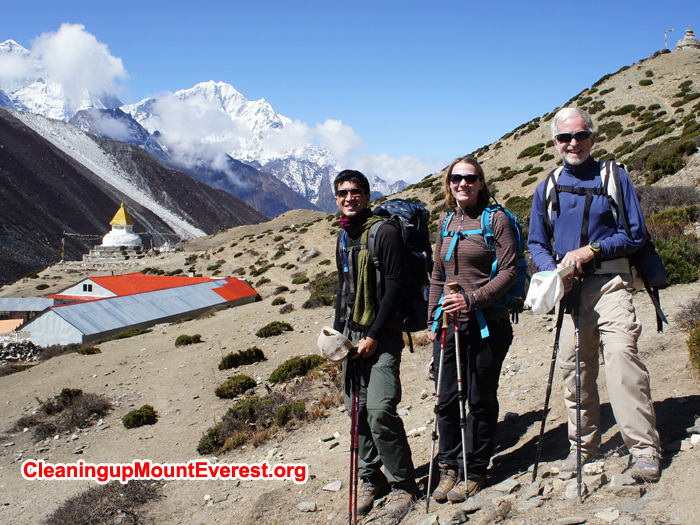
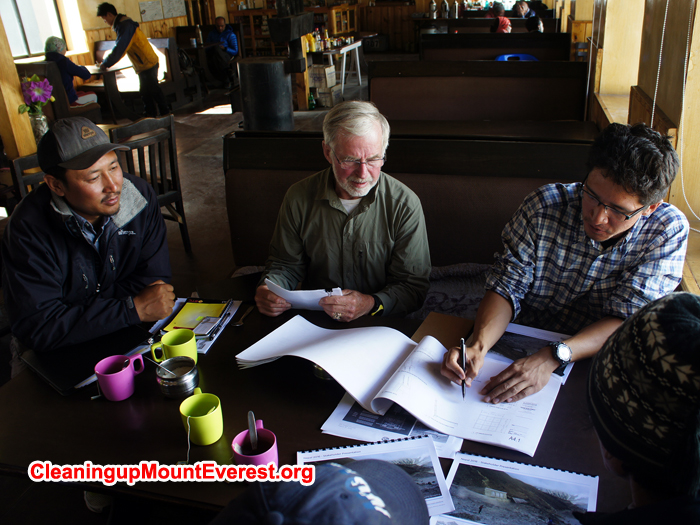
Team in Khumbu Valley in beautiful day. Team planning for Everest Cleanup project.
Friday, May 13
Today is a "rest" day in Dingboche, but Mingma had set up a meeting with the local Buffer Zone Committee and other local leaders. This included the head of the Khumbu Alpine Conservatinon Council and the owner of one of the oldest teahouses in Gorak Shep. Five officials all joined us in our dining room for tea and Mingma led a similar presentation to the one we did in Namche. The biggest difference was that he translated every exchange, though most of the officials understood some english, especially with the visual materials I provided for them.
Present at the meeting were:
Mingma Sherpa, MEBP
Garry Porter, MEBP
Joe Swain, MEBP
Brenda Bednar, MEBP
Lopsang Sherpa, Head of BZC, Ward 7 - Sagaramatha
Kusang Sherpa, Treasurer of BZC, Ward 7
Ram B. Tamang, Commitee of BZC, Ward 7
Mingma Sherpa, Khumbu Alpine Preservation Council
Ang Chhiring Sherpa, Gorak Shep Teahouse Assoc. Member
Feedback was almost entirely positive, even somewhat grateful for our work on the project. Both the teahouse owner and the local BZC head offered whatever help they could, including having local residents move rocks during construction. One bit of feedback that came up more than once was the usefulness of the digester effluent as a ferltilizer for plants. Apparently the growing tourist scene has displaced more and more grazing animals, meaning there's less dung for crops. Everyone was interested in either collecting the effluent or allowing it to go into a controlled growing pen (perhaps a greenhouse?) so they could put it good use. During our trekking, we had discussed this possibility, especially because we are unsure of the drainfield requirements at this point. Removing the effluent could make the digester useful to yet another local group, which could help in its long-tern sustainability. However, we left them with the opinion that until we could test the effluent, it should only be used to fertilize grasses and other crops for animals. Mr. Chhiring said that he would still prefer the effluent as fertilizer as compared to the chemical fertilizer they often have to carry up the mountain.
Nr Chhiring was helpful in his feedback for other design ideas. He agreed that our proposed site would be a good one because of the all-day sun exposure. He didn't have any objections to siting the building at the foot of Kala Pattar. After he offered the help of the tea houses, I also brought up the idea of using shredded paper and plastic trash from the trekkers and climbers as cellulose insulation. He said that could be possible; in fact, the floor of a new part of his tea house sits above empty mineral water bottles packed under the floor. I assume this is for insulation.
There was also a discussion about the methane produced. The officials acknowledged that it may or may not produce a marketable about of gas, but they were particularly positive on the fact that the waste would be treated either way. This was clearly a priority for them. One official mentioned that he went down to one of the waste pit dump sites and noticed that the waste was not breaking down noticeably at all due to the cold and dry conditions.
The rest of the day was spent resting and checking out the local bakeries, all of which have various pies and cookies. In the morning, Garry and Brenda had gone on a short hike up to 15,000ft for acclimitization while I tried to sleep off my cold. After a strong americano at a nearby "french" bakery, I did the same hike in the fog that had rolled in. For the first time on the trek, the effects of the altitude became apparent, as my legs felt heavier the higher I climbed.
Tomorrow we trek up to Lobuche, just a short stop before Gorak Shep.
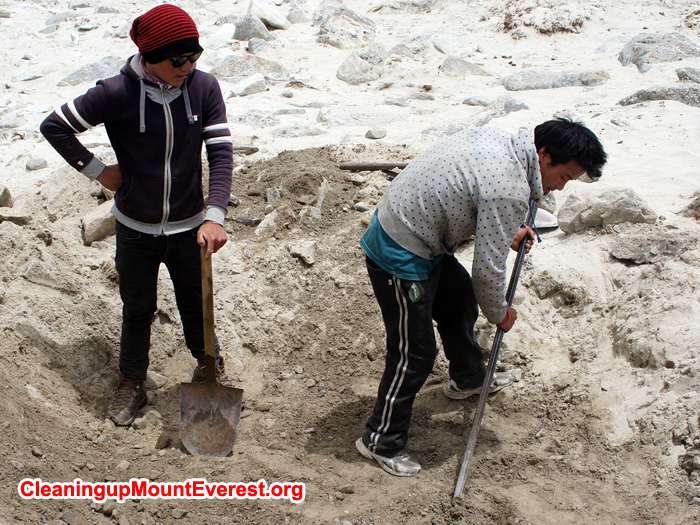
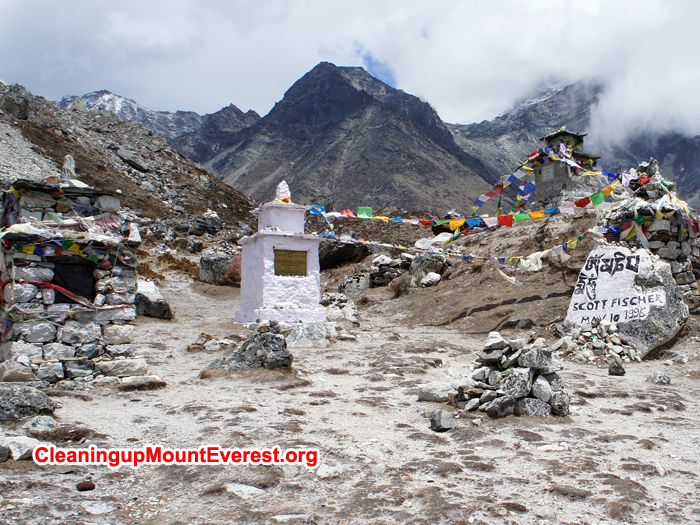
Worker digging soil for Everest Cleanup project. Tribute to climber
Thursday, May 12
Today was arelatively short day of trekking to move further up the valley. As we moved out of Pangboche, we got our first glimpse of Everest, but it lasted no more than a minute, as clouds appear instantaneously out nothing with the blink of an eye. The walk was relatively easy compared to previous days of trekking, particularly for Brenda, who didn't realize a 15lb rock had somehow appeared in her pack for the last climb. After a clear but windy three-ish hour walk back down to the river and up another bluff, we ended at Dingboche (14,200ft) in time for lunch. Not an hour too soon, as clouds began to blow in, and visibility (and sunlight) became nonexistent.
The afternoon became a rest day. I had developed a minor cold the day before, and took a nap to try to nip it. I realized the cold, dry air at this elevation will turn a common sore throat into a virtual inability to speak. We met for a brief dinner in the teahouse dining room, which was probably the warmest space we've encountered since our stopover in Dubai. Unfortunately, this was because of a stove in the middle of the room fueled by dried yak dung, so we had to repeatedly dodge outside for fresh air.
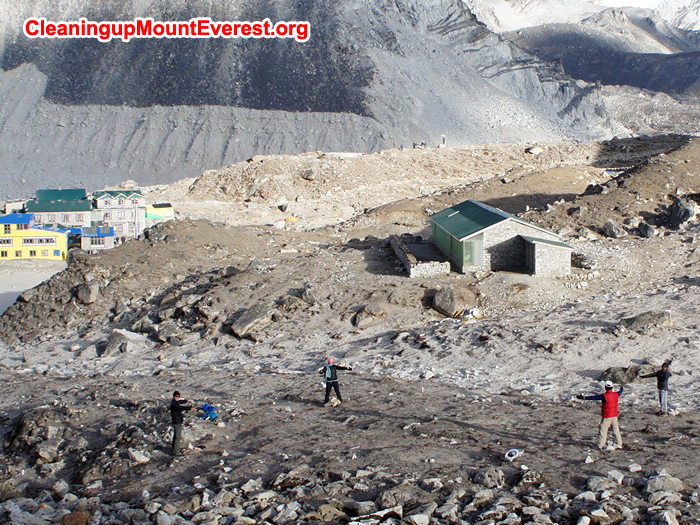
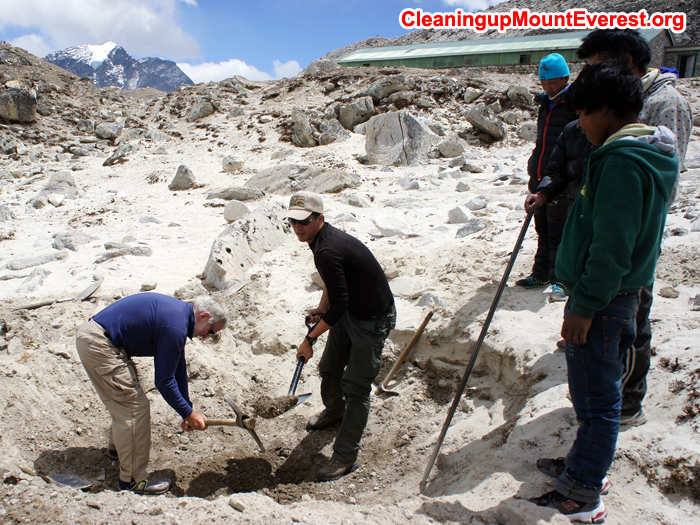
Team reach Everest Basecamp. Team working at Gorek Shep Everest Cleanup project.
Wednesday, May 11
Today is a trekking day from Namche Bazaar to Pangboche (12,800ft), via Tengboche and Deboche, the locations of the oldest monastery and nunnery in the region, respectively. We left after breakfast and climbed out of the Namche bowl and traversed the flanks of the river, only to descend almost 1000ft down to the river to cross it. After lunch we climbed straight out of the valley to Tengboche (12,700 ft), where Garry visited a memorial for a friend's father who had been on the first American team to summit Everest.
We then trekked about 30 minutes down to Deboche, where we visited the nunnery there. AWB-Seattle has been working to design a couple of buildings on this site for the nuns, including a new meditation center. Laura Rose, the project lead, had given me some documents for the nuns and a list of photos she needed. We found the nuns chanting in the middle of a 12-day silent meditation, so we left the documents with them without speaking to them. We then had some tea in the kitchen, where Mingma caught up on the news there (he has been very involved in the development of the nunnery projects for a long time).
After visiting Deboche, we again trekked down to the river (Gary always says never cede your elevation, but sometimes you have no choice), and trekked up to Pangboche. Garry had requested we stay at the teahouse of an old climbing friend, so we stayed at the Highland Sherpa Resort, which served some good Sherpa stew.
Tuesday, May 10
A blur of action in contrast to yesterday's relatively quiet rest day. After breakfast I ran down to print some last-minute energy-modeling documents that had some good graphics to help explain things at our meeting with SPCC and the Buffer Zone Committee. Mingma met us at 9am to go over how the meeting would run and then we walked over to the SPCC headquarters, which were on the second floor of a surprisingly unassuming building.
Mingma moderated the meeting after introductions. He had Garry give a rousing history of the biogas project and why it meant so much to him. Garry had rehearsed his points beforehand and nailed his recounting of his personal experience on Everest, including how he hated leaving his waste on the mountain as he descended for the last time. He also talked of Dan and Mingma's long involvement in the project.
After Garry set up the background, I presented the new developments in the technical design for both the digester and the shelter. Back in Seattle I had put together packets with plans, sections, site information and other visual information for these meetings, and they came in handy in communicating with three officials with varying levels of English. I also presented a full updated set of plans, which included engineering. The SPCC had sent us a list of technical questions, including how to store the waste throughout the year and how to keep the digester at the operating temperature.
A discussion followed, more led by the president of the SPCC, Ang Dorjee Sherpa, and Mingma. After asserting his doubts about the technical feasibiilty of the project, Mr. Dorjee became more optimistic, eventually saying "We must try it. If we don't try, we won't know if it won't work." From this, we began discussing the administrative hurdles in front of the project, including permits from the Sagaramatha National Park.
It soon became clear that the most straightforward path with the least red tape would be partnering with the SPCC and the BZC, since each has control over certain aspects of the park. This would allow us to bypass most of the normal National Park permit requirements, including the dreaded Environmental Impact Assessment. Like in the US, this could take up to two years and require several studies that could be expensive because of the remote location.
The final agreement of a partnership, to be confirmed with a signed MOU between all parties is as follows:
The SPCC will own and operate the project. It will share oversight in the permitting and construction ofthe project.
The MEBP will provide the initial capital investment, technical design, and long-term technical support.
The BZC will facilitate approvals and provide legal support and the acquiring of the land in the National Park.
This partnership was exactly the outcome we had hoped for (and absolutely needed). Even more exciting is that both parties appeared to accept our technical design wholesale. I asked what information they would need (plans, modeling, etc), and they said nothing else would be necessary to move approvals through.
We agreed to type up the meeting minutes and an MOU defining the partnership. We would leave these documents with the SPCC and the BZC and all parties would sign them when we come back through Namche Bazaar next week.
After the meeting, all four of us were excited, but had a lot of work to do before the end of the day as we needed to get the documents to the other parties. Brenda wrote up the meeting minutes, and I drew up a draft MOU, which was proofread by all the team members before I formatted the documents and had them printed. (For future reference, it costs 50 cents to print a black and white page in Namche Bazaar, so any heavy printing needs would be best taken care of in Kathmandu.)
After dinner, we packed up as much as we could, as we had a very long day of trekking ahead of us. On group work, Mingma's Sherpa wisdom of the day: "A thousand hands is golden; a thousand mouths is poison."
Monday, May 9
Today is a working/rest day in Namche Bazaar. We got word from Mingma that the SPCC head arrived in town this morning, so we are on for a joint BZC/SPCC meeting tomorrow morning. Therefore Mingma took the day off and Garry, Brenda and I set out on a four-hour day hike up to the towns of Khunde and Khumjung (12,600ft) to help with acclimatization. There are supposed to be fantastic views of some of the more prominent mountains in the area, including Everest, but after an hour of clear weather, clouds rolled in and we ended up getting rained on on the way down to Namche.
Garry and I attempted to visit the pre-fabricated REI-funded Emergency Disaster Center on the way back, but found it located on a small military base. The guard let us into a small dark office so we could as permission (he didn't speak any English) to check out the building, but no one came to meet us, and after 10 minutes we left. We did notice the outside of the building looked weathered and appeared to be peeling, which struck us as odd for a weeks-old building. It's possible it hasn't been finished yet, though the photos in the news articles made it look much better. We decided to ask Mingma if he thought it worth pushing the guards at the base to get a closer look.
The rest of the day was spent recovering from the hike, which included my first shower since Friday, and finishing preparations for tomorrow's meeting by printing out some last-minute documents at a local internet cafe.
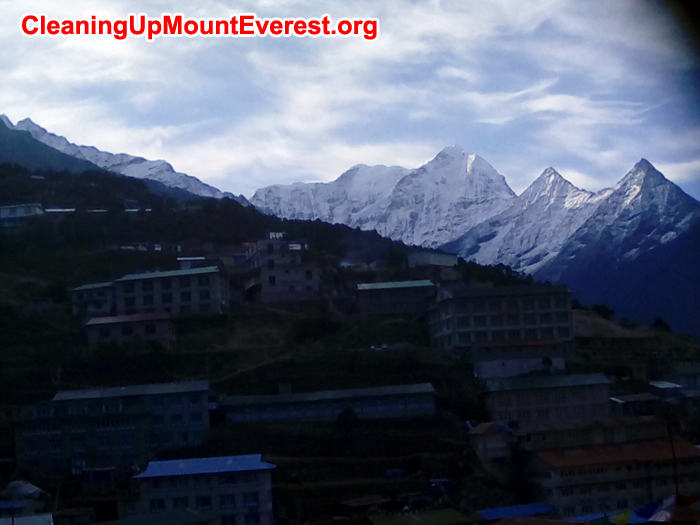
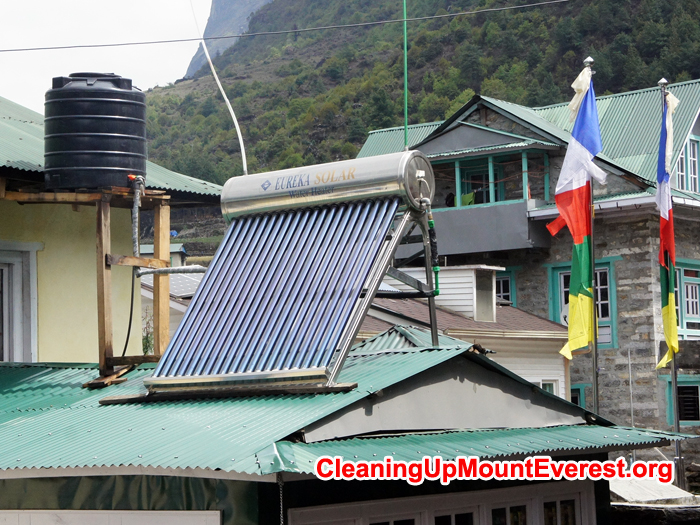
Photo Joe
Sunday, May 8
We trekked a challenging morning from Monjo to Namche Bazaar (11,000ft), with a net gain of about 2000ft, but considerably more overall climbing. The trail criss-crossed the river fed by the Khumbu Glacier (and contaminated by any waste that is currently dumped below Gorak Shep) before moving off the banks to Namche. We made didn't have much of a problem despite the elevation, though we made sure to take plenty of breaks. Mingma's Sherpa wisdom of the day: "For a long life, do not take short cuts."
We made it to the Yak Hotel, owned by friends of Mingma's in time for a late lunch. Mingma is from Namche Bazaar and of course knows everyone we pass on the street.
Although most people spend two nights here to acclimatize, we have scheduled three to make it easier to schedule meetings with the Central Buffer Zone Committee and SPCC. Namche is the center of the Sherpa region, and it is home to both of these organizations. I'd also like to meet with a builder or two here, as well as check out the Emergency Center just built this year with heavy support from REI.
After a nap we reconvened to plan for our upcoming meetings over coffee and surprisingly decent apple pie. Bakeries are on every corner here and most now serve Italian espresso drinks - sometimes you wonder if this town would exist if there weren't hundreds of western tourists coming through every day. In the meantime, Brenda set up a Facebook page for the MEBP to which we can hopefully post these notes and some photos.
Mingma explained the dynamics of the BZC and the SPCC, and how we might present the project to both of them. We have brought packets of visuals of the project, as well as a full plan set. The SPCC will be most interested in our progress solving the technical aspects of running a biodigester at high elevation. We discussed how to address the "exit strategy" question and how we envision these organizations sustaining the project after it's built. Mingma suggested we ask them for their suggestions, as they already have mechanisms for extracting fees, taxes and paying for infrastructural and environmental resources.
Mingma was confident that our showing our faces in the Khumbu Valley alone would go far in showing how serious the team is about implementing the biogas project. Nevertheless, he recommended Garry begin by recounting the history of the project and why everyone involved is so invested in the idea, the people and the region. The head of SPCC is supposed to arrive in Namche from Kathmandu tomorrow, so Mingma hopes to schedule the meething for Tuesday morning. The BZC meeting may be at the same time, or possibly on Monday.
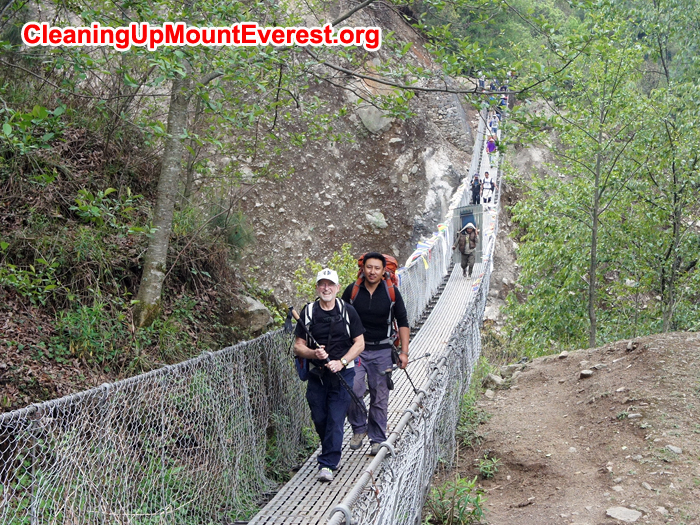
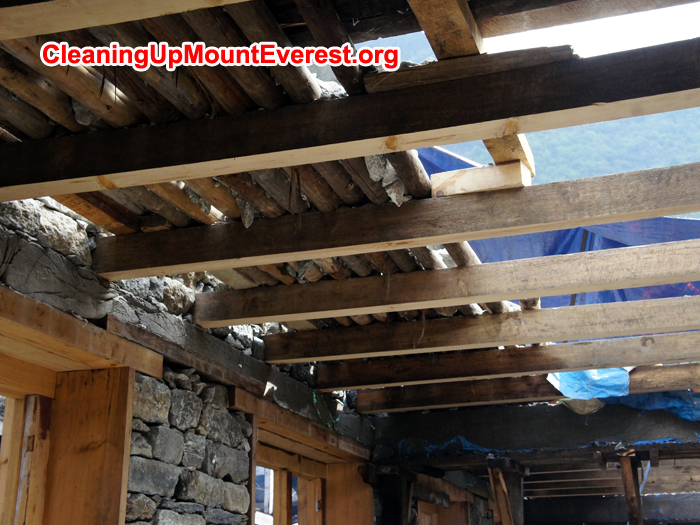
Photo Joe
Saturday, May 7
We met Mingma at the airport early to catch the first flight to Lukla (9000ft), the beginning of our trek. A series of miscommunications at the airport lead to our seats being given to other travelers. However, Mingma found us an alternative almost immediately. A helicopter (piloted by a 42-year-old journeyman named Ryan) was going out to Lukla to pick up someone with a broken leg, so we caught a 45-minute flight that spared us from having to land on the infamous 18-degree landing strip.
After reorganizing our bags and distributing some weight to two porters, the four of us trekked down to Phakding (8300ft) where we had lunch. This is the traditional first night on the EBC trek, but it was only 1pm and we were feeling energetic, so we pushed on to Monjo (9000ft) to save ourselves some climbing the next day to Namche Bazaar, probably the hardest day of trekking.
On the way we documented some tea houses under construction and the building methods they were using. There was a lot of wood framing, but some hand-carved stone blocks as well. One cladding material I hadn't seen in photos before was very thin (.45mm) sheet metal. It was flat and nailed directly to the studs, which were about 32" on center. The only other layer in the wall system was a sheet of 5-10mm plywood on the inside, which also could be the finish. There was significant oil canning on the metal sheets, which come in rolls. However, it's definitely cheaper than stone or wood.
We passed a friend of Mingma's on our way up to Monjo who was an 85-year-old Coloradan who had become a Buddhist monk years ago. We told him our destination and his response was, "You're going to Base Camp? You should save yourself some time and instead check out the New York or Seattle Dump."
Friday, May 6
Today was our only real day in Kathmandu before our trek, so we spent the first part of the day chasing down shopping list items, including medication for altitude sickness, trekking equipment, a map, and a SIM card for an emergency phone (+977 9823439534; Garry's is 9823439600). Mingma Sherpa, our project Sherpa liason and designated guide for our trek up the valley, met us after breakfast to take us around Thamel and and talk logistics. We later split so he could aquire our trekking permits. Our afternoon was spent figuring out how to re-pack our bags, send text messages, catch up on sleep lost to jet lag, and getting our gadgets charged (a challenge given the rolling blackouts schedulled everyday by the city).
Thursday, May 5
Garry, Brenda and I arrived in Kathmandu around 11pm after a delayed connection from Dubai. We were able to check out downtown Dubai and the Burj Khalifa thanks to a 6-hour layover and a generous immigration official. We ate a Lebanese & Armenian meal in the upscale mall overlooking the central canal, which was lucky because the flight to Kathmandu was a spartan flight mostly for migrant workers that offered no food or drinks. Our hotel was moved at the last minute due to overbooking, but this wasn't a problem for us. We ended up at Hotel Mums House south of Thamel.
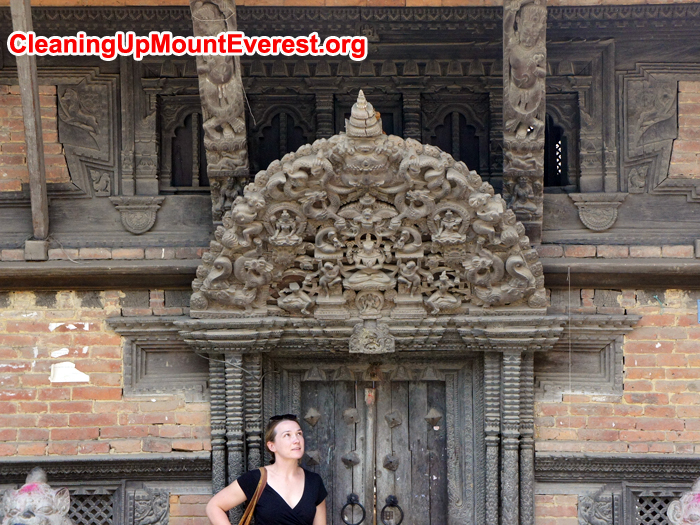

Photo Joe
=======================================================================
CLEANING UP MT. EVEREST (Converting poop to power)
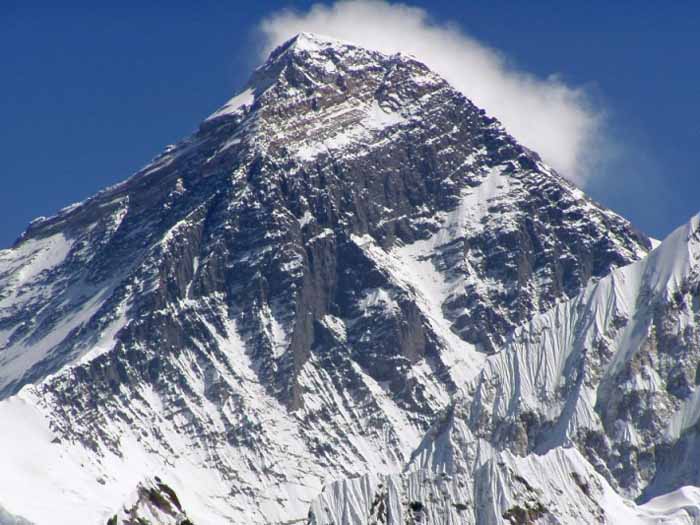
For climbers all over the world, summiting Mount Everest represents a lifetime dream and one of their greatest achievements. But when they leave Mt. Everest, their human waste is left at the nearby Sherpa village of Gorak Shep. Today’s average climbing season produces nearly 12,000 kg of solid human waste. While recycling and trash programs are now in place, no real solution exists for the human waste generated by the climbing community. Modern treatment plants are impractical to build and maintain in this isolated corner of the world, so this waste is currently dumped into unlined pits at Gorak Shep, contributing to an increasingly polluted water supply. Despite all the efforts to clean up Mt. Everest, it is this environmental disaster that we are addressing, and we need help to get there!
In April 2010, a group of volunteer engineers and architects from the Seattle area formed the non-profit Mt. Everest Biogas Project to address this environmental issue. We have designed a biogas system that will safely break down the human waste and create clean burning methane gas for the Sherpa community. Our design includes not only the biogas digester, but also a small shelter to minimize temperature variations. This is a familiar technology; biogas digesters are used prolifically throughout Nepal, India and China.
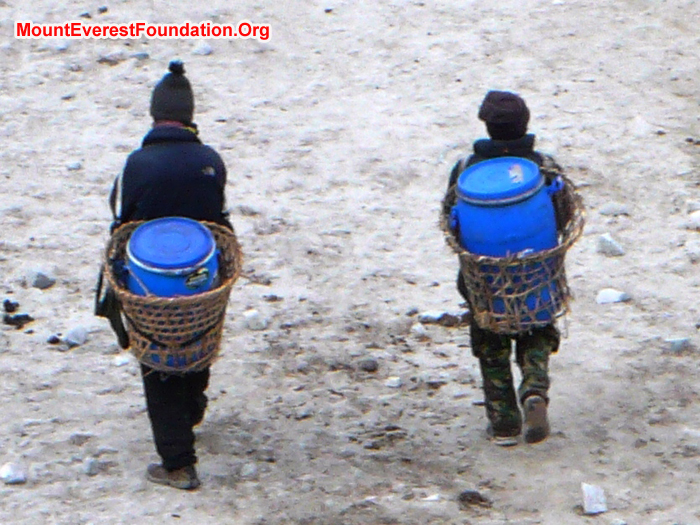
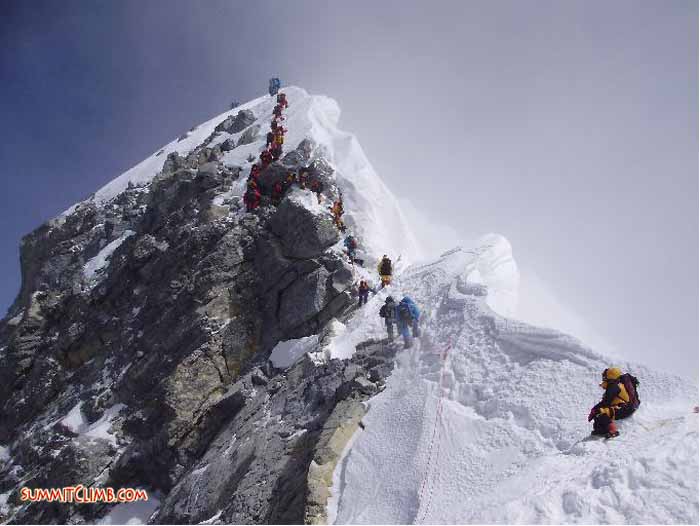
Porters carrying blue barrel toilet drums at Gorak Shep.The famous Hillary Step going up towards the summit of Everest (Richard Pattison Photo).
Our design has been peer reviewed by local technical professionals and now it’s time to implement it. The biogas system concept was presented to Nepalese officials and teahouse owners in 2014. Now that the design is nearing completion, it is time to give them an update and begin planning to break ground.
We are trying to get 4 or 5 technical team members to Nepal to present the proposed design as well as to meet with local contractors and plan for its construction. We hope to raise $10,000 to make this trip happen; to help pay for the airfare and cost of getting to Gorak Shep. Once in construction, our project will use locally available materials and manpower; hire local construction companies; and help build community investment in preserving Mt. Everest for future generations.
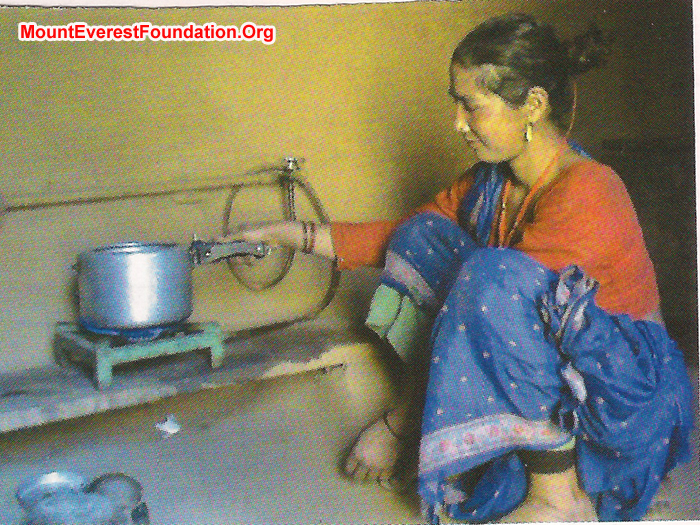
Woman using Biogas stove.
Although we are formally affiliated with Engineers without Borders (EWB) and Architects without Borders (AWB), we receive no funding from either organization. Our only contributions are from the volunteer team members both in their technical expertise and personal time. Traveling members are volunteers and will be paying their own living expenses and taking time off from work to make this trip happen. Please help us raise the necessary funds to realize our design!
If our design is sustainable at Gorak Shep, then the potential for replicating the design in other high altitude locations with the same environmental issue of human waste can be achieved.
For the Sherpa communities that dwell in the foothills of Everest, this mountain is sacred. Please help us climb high for them and keep it that way. Donate now. Be a part of preserving this world treasure. It’s a place dreams are made of and we have an opportunity to help keep it that way.
Students and Professors Making Biogas in the Laboratory at Kathmandu University February
Everest Biogas Project: Anaerobic Digestion of Human waste
Training Phase:
To be familiar with working condition, we practiced extraction and insertion of seed sludge in the reactors.We also practiced testing the following parameters:
- TS/VS
- pH
- E. coli
Sealing of the Reactors:
We sealed and tested the reactor many times to prevent any gas leaks.The types of seals used and their result are as follows:
- First, plastic zips were used at the joint between two pipes. Sealing tape was used at the cap. We checked the gas leak using Nitrogen. Nitrogen was flushed into the reactor and soap solution was applied on the joints to check any leakage. The presence of soap bubbles indicated gas leak.
- 100% adhesive silicone sealant was used next. Presence of bubbles was seen in the gluewhich caused the glue to peel off the joints.
- M seal PVC solvent cement was used. This was comparatively the best seal by far. However, we could observe gas leaks in some reactor after a few days.
- Plumbing M seal was used in those reactors which were leaking.
- To ensure complete air tight condition we used hot gun.
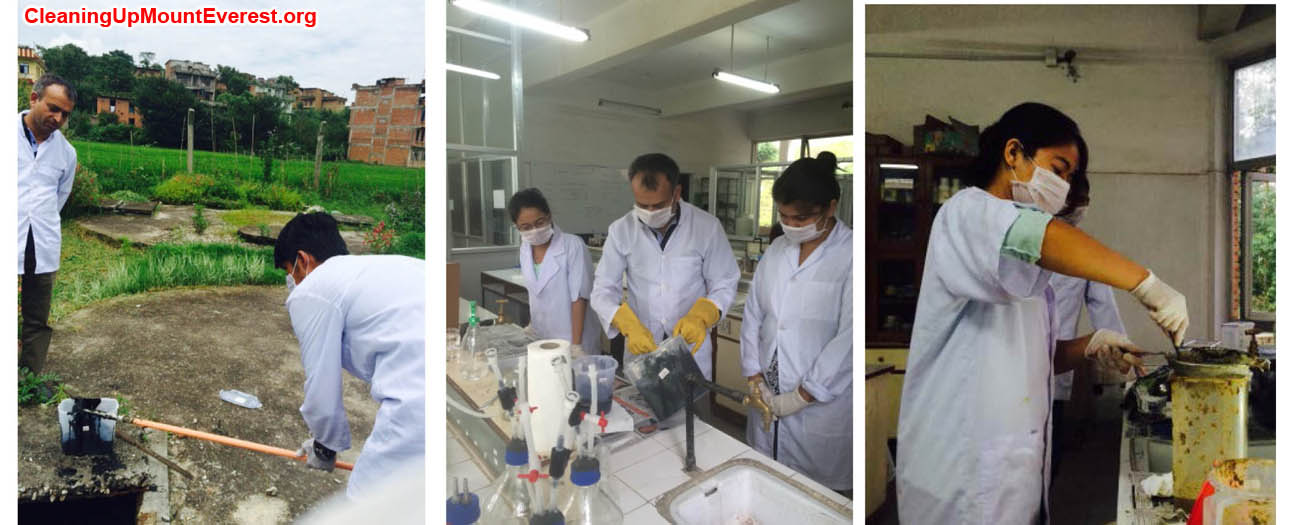
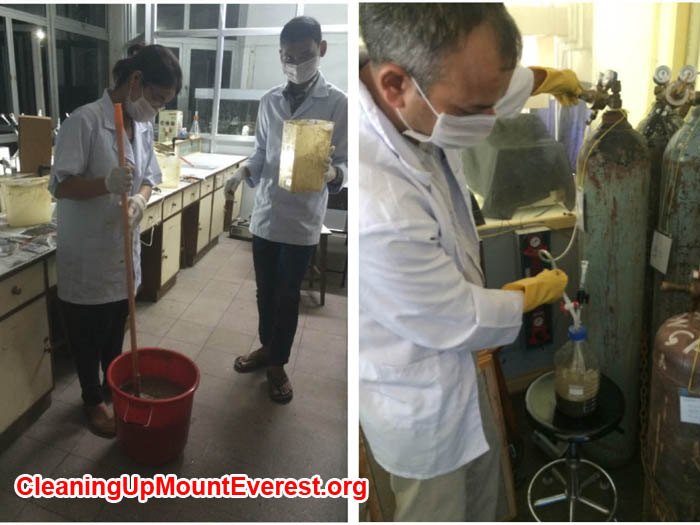
Phase 1:- Fig. 1. Sample collection, 2. Weighing, 3. Grinding, 4. Mixing, 5. Refluxing with Nitrogen gas
August 9th :
We went for seed sludge collection in four different sites;
a) Bansghari, Dhulikhel
b) Khadpu (municipal waste)
c) Bhaisipati- 2 sites
- To collect the seed sludge, a spoon was attached to a long stick. The sludge was collected in 5 liters container.
- 250g of seed sludge from 3 sites and 1 kg of municipal sludge were blended along with 5 kg of water.
- 2.5 kg blue barrel waste (BBW) was blended with5 kg water.
- 30-40 gm of blue barrel waste and 20 gm of seed sludge (starting inoculum) were separately taken in blue cap tube for DNA test.
- We then separately sieved the BBW and seed sludgewith 1 mm mesh for easy extraction via syringe.
- The sieved BBW and seed sludge were mixed together.
- 10-20 ml of the mixture was taken in pink cap test tube for DNA test.
- 800 gm of the mixture was weighted and filled in each reactor.
- The reactors were flushed with Nitrogen gas on 10th August, in order to maintain anaerobic condition.
- The temperature of the incubators were set at 10oC, 20oC, 30oC and 37oC using temperature regulating sensors.
- The reactors after coding were placed in the respective incubators.
Gas Check:
- After all the setup, there incubators were left in their running condition.
- The gas production was checked using water displacement method. For this, 20gm NaOH was dissolved in 500 ml distilled water to make NaOH solution.
- First gas check was conducted on 11th August which showed no result.
- Gas check was conducted at regular intervals from August to October. There were no signs of gas production from any reactors.
Problems:
- In spite of maintaining the required conditions, there was no sign of gas production.The speculations for failure of our experiment are:
- Use of inactive seed sludge. The digesters at the sample site were dysfunctional due to earthquake.
- Over dilution (1:3) and sedimentation of sludge.
- Air tight condition might not have existed (though gas leak test didn’t show leakage).
- The new set up was delayed due to blockade and internal political conflicts, which caused fuel crisis. University was closed due to the crises and the situation resulted on lab access resulting on continuation of the experiment.
- The incubators were shut on 15th October .
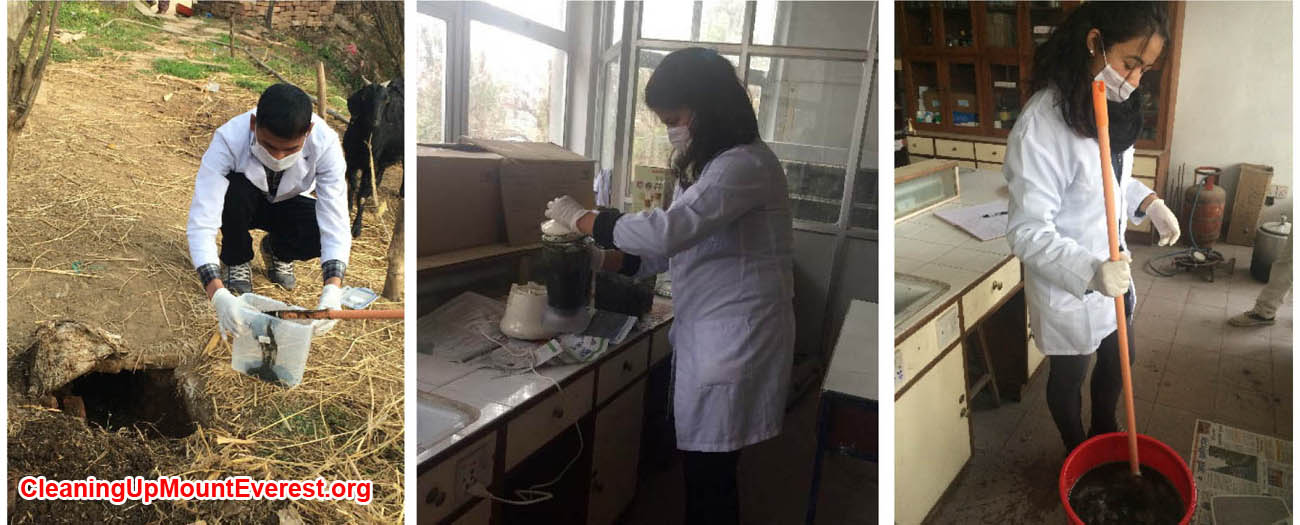
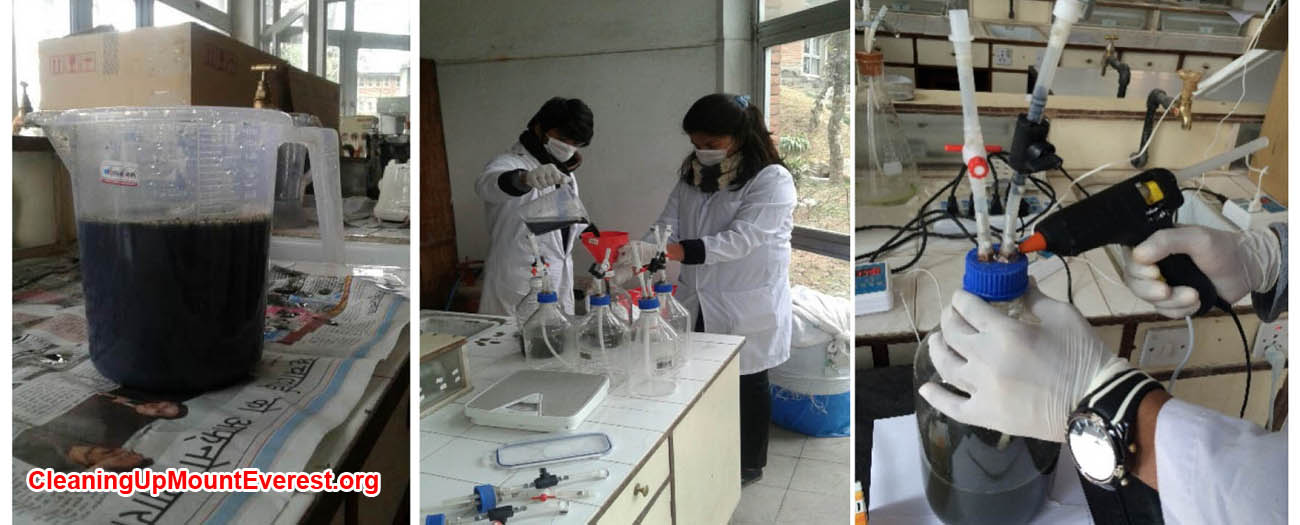
Phase2:- Fig. 1. Sample collection, 2. Grinding, 3. Mixing, 4. Measuring, Filling, 5. Sealing New Set Up :
January 27th,
Seed Sludge Collection: The seed sludge was collected from two functional biogas digesters at Taukhal, Panauti.
Starting Inoculum Preparation:
- 25% seed sludge and 75% water was prepared per reactor.
- For this, we took:
- Seed sludge: 250X18= 4500g
- Water: 750X18= 13500g
- Note (consideration):
- 1kg=1L (about)
- Inoculum for 18 reactors were prepared to prevent handling error.
- Seed sludge was finely ground for 2-3 minutes.
- Seed sludge and water was mixed in 20L bucket and stirred well.
- All 16 reactors were filled with 1L of the starting inoculum.
- Reactors were flushed with Nitrogen on 29th January, to maintain anaerobic condition.
1st February,
- Fresh NaOH was prepared as done before.
- The temperature of the incubators were set at 10oC, 20oC, 30oC and 37oC using temperature regulating sensors.
7th February, : Though water was not displaced, there was few bubbles production from 20oC and 37oC reactors which is a good sign.
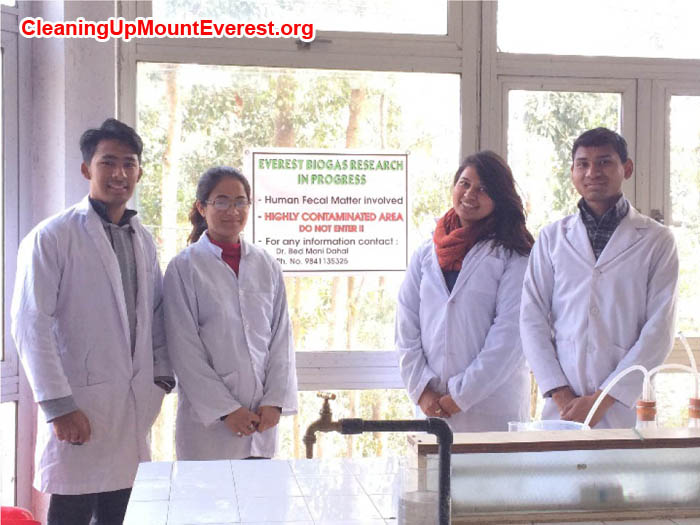
Group photo
------------------------------------------------------------------------------------------------------------------------
Biogas Shelter Design by Joseph Swain: December,
Building Section with long-term Storage
Building section looking North
Floor Plan
South Elevation
------------------------------------------------------------------------------------------------------------------------
------------------------------------------------------------------------------------------------------------------------
------------------------------------------------------------------------------------------------------------------------
------------------------------------------------------------------------------------------------------------------------
------------------------------------------------------------------------------------------------------------------------
Engineers Attack Mt. Everest's 12-Ton Poop Problem
A new waste-to-energy system could help power a nearby Nepalese village
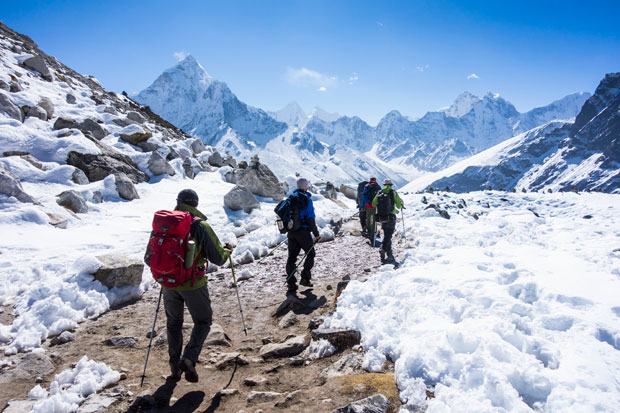
Photo: John Harper/Corbis
For many amateur climbers, summiting Mount Everest represents one of life’s greatest challenges and achievements. But for the Nepalese and foreign professionals who work there, the larger challenge is figuring out how to keep the place clean.
Efforts to beautify what’s frequently called “the world’s highest garbage dump” have been under way for more than a decade, with mixed results. Spent oxygen canisters, empty beer bottles, and tattered tents recovered from the mountain can often be reused or recycled, but human waste is a messier problem. Each year, porters haul down some 12,000 kilograms of poop from base camps at Everest and the nearby Pumori, Lhotse, and Nuptse mountains. Getting the material off the mountain is one thing; however, properly disposing of it is another. back to top
The waste is currently delivered on foot to Gorak Shep, the nearest village to Everest, sitting at 5,164 meters (3.2 miles) above sea level. The porters drop the poop into unlined pits, leaving the raw excrement to slowly dehydrate and break down in the open air, which, at such high altitudes, can take years. In the meantime, the waste mars the landscape and potentially contaminates the town’s water supply. Both the Nepalese government and the climbing community recognize that this method of disposal is a hazard to environmental as well as human health, but given the remoteness of the site and the magnitude of the problem, solutions have remained elusive.
“In places like Alaska they have an expensive solution—they helicopter the waste out—but that’s not available in a lot of developing countries where there aren’t even treatment plants they can helicopter it to”—Garry Porter, Mt. Everest Biogas Project
A team of volunteer engineers might be just what Nepal needs, however. Members of the Mt. Everest Biogas Project, as it’s called, say they have a potential fix: a specially designed biogas reactor that can transform Gorak Shep’s fetid trenches into energy. Not only would it eliminate the need for the poop pits, it would also provide the village with a bountiful, free source of methane, which could be used as fuel for cooking and heating homes.
Garry Porter, a retired Boeing engineer based in Seattle, and his buddy Dan Mazur, a professional mountaineer, hatched the idea back in 2010. Mazur lives in Nepal and Tibet for half the year and regularly leads climbs up Everest, so he was well aware of the poop predicament. Porter became intimate with it in 2003, when he attempted to scale Everest. “The Nepalese consider this their sacred mountain, and we’re defecating on it,” he says.
Thousands of biogas reactors already operate at lower altitudes throughout Nepal, but temperatures at Gorak Shep prevent the needed waste-devouring bacteria from thriving. Recognizing this, Mazur asked Porter if he thought it would be possible to create a biogas digester that could function in the cold. Porter did, and the project was born.
After recruiting about a dozen other engineer volunteers, Porter and his team began brainstorming a solution, keeping in mind that they could use only materials that are readily available in Kathmandu, Nepal’s capital. Rather than build something from scratch, they decided to figure out a way to insulate the preexisting design, a 6-cubic-meter model that, if kept warm enough, could process all the climber waste currently dumped in Gorak Shep. back to top
Having worked through several iterations, the team settled on a relatively straightforward solution. The digester itself will be swaddled in R-50 (heavy) insulation, and a 200-watt resistor coil—similar to those found in water heaters—will deliver heat. The contents of the digester, which is buried in the ground, must remain at 30 °C or higher. Given the ground and air temperature, the engineers calculated that doing this would require an average of 100 W, a figure that they doubled to be safe.
There was another problem, of course: Gorak Shep has no access to electricity. (A few telecom companies serving climbers have photovoltaic installations for their own needs.) Consulting meteorological databases, the team determined that—given the maximum summer and minimum winter temperatures, plus days of cloud cover and snow—an array of 16 photovoltaic solar panels would be able to produce the needed 200 W. A bank of Exide LMXT 2-volt batteries, which are designed for use with solar arrays, is also needed to keep the digester running at night and on overcast days. The whole thing will be topped off with a shelter, which the volunteer group Architects Without Borders has offered to design.
Porter and the other engineers recently submitted a 27-page “Basis of Design” for peer review to engineers not involved in the project. In February, it was returned with the reviewers’ stamp of approval. The Nepalese government, residents of Gorak Shep, and the climbing community have all responded enthusiastically as well. Now the biogas team is working on estimating the price—certainly in the thousands of dollars, the engineers say—of building and installing the digester, which will be funded entirely by donations. Construction is tentatively slated for 2016. “Our intent is to build one, get it up and running, train local operators—and then the horses leave town,” Porter says. “But we will have people in Seattle and Kathmandu who can provide technical support for the life of the system.”
If successful, the project could be replicated in other locations that are too cold for traditional digesters. “In places like Alaska they have an expensive solution—they helicopter the waste out—but that’s not available in a lot of developing countries where there aren’t even treatment plants they can helicopter it to,” Porter says. “If we can bring this technical solution to bear on a universal problem, then hey, that’s great.”
This article originally appeared in print as “Waste-to-Energy at the Roof of the World.”
About the Author
Rachel Nuwer is a Brooklyn, N.Y.-based journalist who writes for the New York Times, Smithsonian, Scientific American, and New Scientist among other publications. A globe trotter, she's been in 51 countries and lived in six.
--------------------------------------------------------------------------------------------------------
-----------------------------------------------
Update on Mount Everest Biogas Research Project: Things are progressing well here, we're heading back to Kathmandu University tomorrow to finalize the experimental procedure, extract DNA, and go through sample analysis. Its been a great trip, things have gone well for the project, more time for training would always be beneficial but that being excepted I don't know if it could have worked any better. This doesn't mean the experiments will work the way we want, only time will tell, but I think its valuable that we're undertaking them. -Dr. Mike Marsolek, Professor of Environmental Engineering, Seattle University.
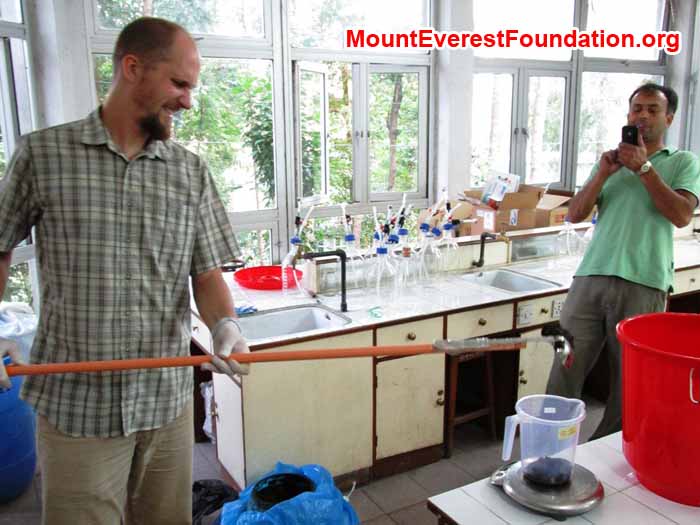
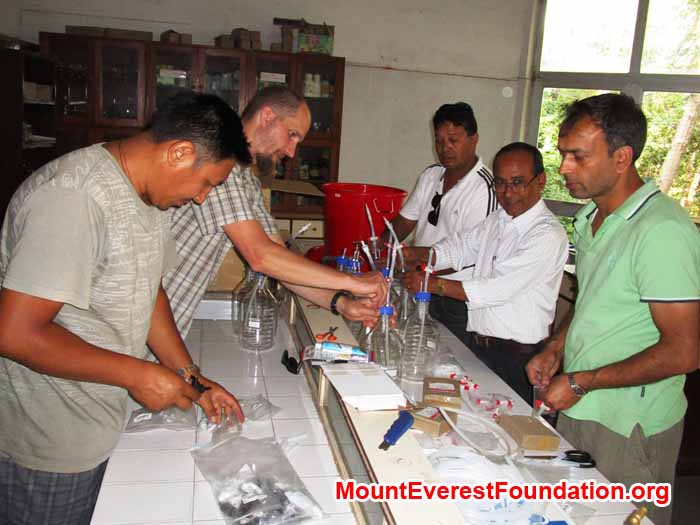
Mike mixes a waste sample while Bed Mani photographs at KU biology lab. Mingma, Mike, Murari, Dibya and Bed Mani building lab scale biogas reactors at Kathmandu University.
Reactor Gas Leak Testing
- Materials
- Soapy water
- Nitrogen gas with regulator
- Reactor bottle with valves attached
- Silicon caulking
- Procedure
- Attach nitrogen gas tank to bottle through gas line
- Adjust regulator to 4 atm = 15 psi
- Open bottle valve, open regulator, fill bottle to 4 atm, close bottle valve and regulator
- Apply soapy water around lid/seals/gaskets
- If leaking apply silicon caulking back to top
Reactor Startup Procedure
1. Prepare starting inoculum
Prepare enough inoculum for 20 reactors + 4 extra = 24.
Start with 500 mL inoculum (250 g digester sludges + 250 mL water) + 500 mL slurry (250 g BBW + 250 mL water) per reactor
Require 20 L starting inoculum for 20 reactors.
Make with mixture of Gobar sludge, high altitude, and fresh sludge from Municipal Digester (Photo Right: Professor Bed Mani tests biogas reactor methane output in th KU lab)
Prepare ‘inoculum mixture’:
Require approximately 6 kg
Use 3 kg ‘high altitude’ gobar sludge
Use 1.5 kg fresh digester sludge from local municipal plant
Use 0.5 kg gobar sludge from three local digesters )total 1.5 kg)
Mix well in small (5 gallon) bucket
Into large bucket add (roughly):
6 kg BBW
Also collect five samples of 30-40 g BBW into 50 mL centrifuge tubes, label clearly, use these for TS, VS, Helminth egg, and VFA analysis.
6 kg inoculum mixture
12 kg (or 12 L) water
Mix very well
This is the ‘starting inoculum’
Collect five 40-50 mL samples of this starting inoculum into 50 mL centrifuge tubes. Label clearly.
We will use these samples for DNA extraction.
2. Add 1-L of this prepared starting inoculum per reactor and flush headspace with nitrogen.
3. Assemble reactor lids, seal tightly, label, place in incubators.
4. Analyze TS, VS, Helminth Egg, and VFA of BBW samples.
5. Extract DNA from ‘starting inoculum’ samples. back to top
Materials
One 5 gallon bucket, one 10 gallon (approximately) bucket (if possible)
Mixing tool with long handle
Wide mouth funnel
50 mL centrifuge tubes
Mixing rod/device
12 L Water
Soap and water for washing, paper towels, garbage receptacle, ethanol for rinsing.
Boxes of gloves. Photo Right: Bed Mani showing the biogas reactors inside the 37 degree incubation chamber at KU
*Sampling Procedure:
Remove reactor from incubator
Mark all activity on checksheet
Mix reactor sludge vigorously
Attach biogas effluent tubing to biogas measuring tool via quick-connect connectors
Verify NaOH solution is still viable.
Per 500 mL NaOH solution, add 20 g solid NaOH per 500 mL water. Add phenolphthalein.
Verify at least 500 mL water in water displacement vessel.
Open valve allowing biogas to pass through NaOH solution and displace water
Measure mass of displaced water
Mark on checksheet
Close valve and disconnect reactor
Using 50-mL syringe and corresponding tubing attach to sampling tube of bioreactor
Ensure attachments are tight.
Mark with scissors and tare aluminum dishes for TS/VS analysis
Remove the desired volume of sludge sample, place in aluminum dish for TS and VS analysis or in temporary dish for partitioning between different sample assays.
Separate some sample for Helminth Egg, VFA, or DNA extraction if applicable.
Pull a volume of blue-barrel waste equal to sample volume into 50-mL syringe.
Add these solids into reactor, disconnect syringe, mix solids, and replace reactor. Photo Right: Mike Marsolek and Bala Ram Shrestha BSP-Nepal
For 37°C Reactor: HRT = 20 days, sample/feed 100 mL every 2 days
For 30°C Reactor: HRT = 30 days, sample/feed 70 mL every 2 days
For 20°C Reactor: HRT = 60 days, sample/feed 50 mL every 3 days
For 10°C Reactor: HRT = 120 days, sample feed 25 mL every 3 days
*Sample Analysis
TS/VS on biosolids removed (see checksheet)
Methane production via water displacement (fill in checksheet)
Helminth egg every X samples? (every other sample in last two residence times?)
Once experiment is nearing completion, collect some of extracted solids for DNA extraction.
Repeat this, one sample for one DNA sample, on three different sampling dates near end of experiment.
Similarly save necessary mass of solids from three time points near end of experiment for VFA analysis (and other?) to send to lab.
Reactor Trial Startup Procedure
First gas test all bottles.
Then prepare enough slurry to operate two reactors.
Need 1-L per reactor, prepare 2 L total slurry
0.5 kg BBW + 0.5 L water
1 L or kg sludge
Also add acetate to ‘kick start’ bugs
Final goal is 50 mM acetate
Prepare stock solution of 1 M acetate (20.4 g per 150 mL water)
Add 50 mL of stock solution per 1-L sludge (per reactor) for 50 mM final concentration.
Purge headspace with nitrogen.
Swirl to mix well. Photo Right: Students at Kathmandu University build reactors in the biology lab
Carry out sampling/feeding/sample analysis procedure for multiple points (can sample every other day) until students are consistent.
**I recommend first walking through sampling/feeding procedure with water in reactors, then using actual sludge
We all know of the terrible, devastating earthquakes that have hit Nepal and many of us are already giving donations to help with that crisis. Even though our efforts may seem small compared to the rebuilding Nepal must endure, our work is still important. Thousands of pounds of human waste continues to pollute a sacred mountain as well as the homes and health of many. Your financial help is needed to make this stop. Please give what you can. Thanks, Kirk Robinson and Garry Porter
Tentative Biogas research budget:
1. transport of 75 kgs waste from bc -lukla: $252
2. transport of 75 + 12 kgs (moshe gobar gas sample) = 87 kgs waste from lukla-ktm: $83.
3. transport of 87 kgs from ktm airport to halchowk: $20.
4. generator repair $50.
5. two refrigerators: $245.
6. labaratory supplier (kupandole) (20 bottles (2l) with fittings): $600
7. gobar gas sampling in kavre (transport): $100
8. gobar gas sampling supplies: $65.
9. 21 days in shakti hotel: $630.00
10. advance cash to mike: $200.
11. ncell recharge cards for mike: $20.
12. Mike's plane ticket: $1360.
13. Mike's travel insurance: $90.
14. Reactor supplies bought by Mike in Seattle: $750.
15. Dna extraction supplies bought by Mike in Seattle: $550.
16. Temperature controllers bought by Mike in Seattle: $160.
17. 2 Heaters for hot boxes: $60.
18. Electrical stabilizers: $20
19. Additional laboratory supplies $300.
20. Electrical cords and power strips, etc: $50
21. Daily expenses for meals, etc: $30 / day. (Mike will pay himself).
22. labor cost from grad student/ faculty at KU. TBD
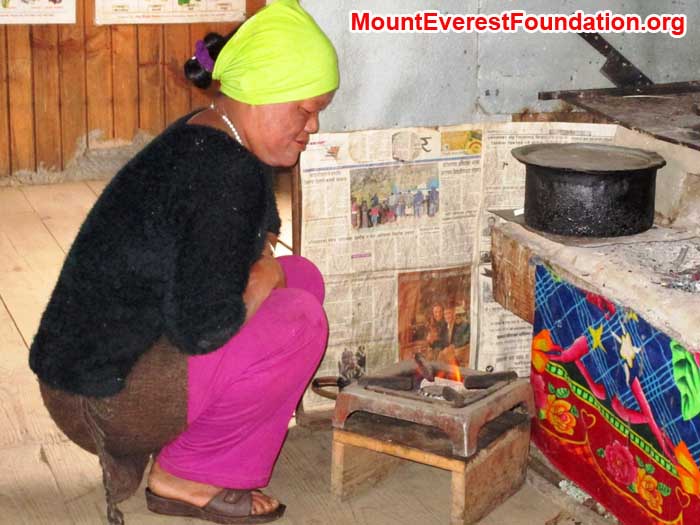
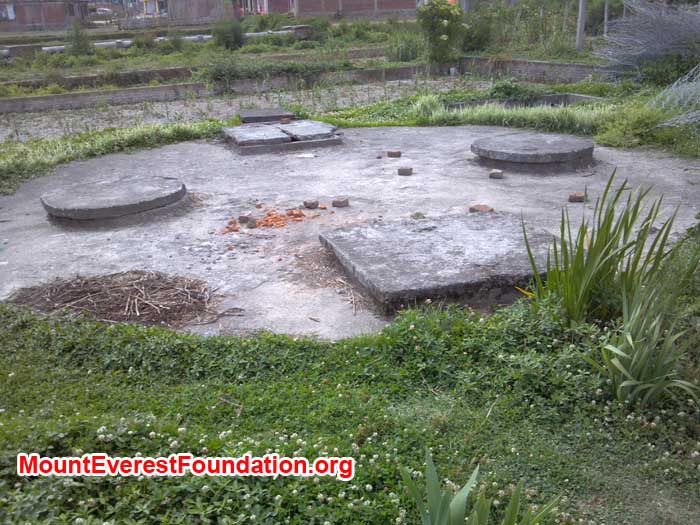
Puti Sherpa prepares tea for us over a biogas flame in her home in Lukla. Large scale anaerobic digester and biogas unit in Kathmandu, powered by human waste. Mike Marsolek photo back to top
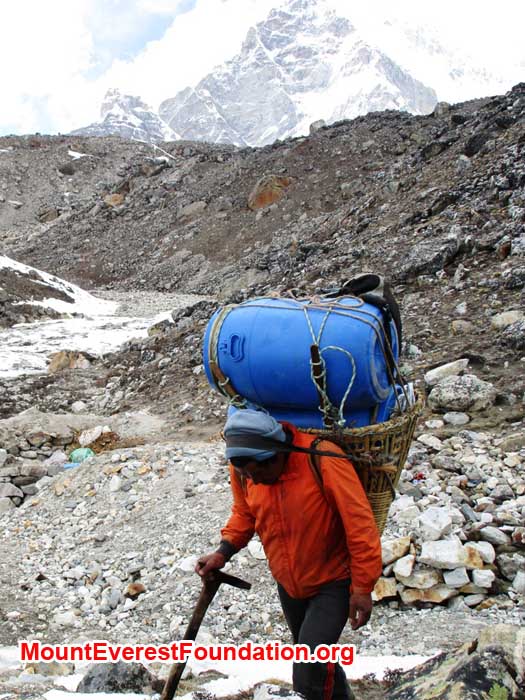
.jpg)
Porter carrying human waste down from Mount Everest base camp. Biogas unit at private home in Kathmandu. Mike Marsolek photo.
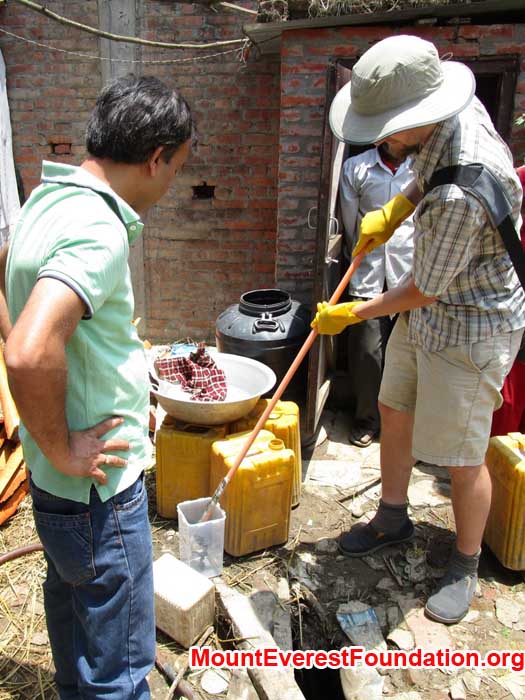
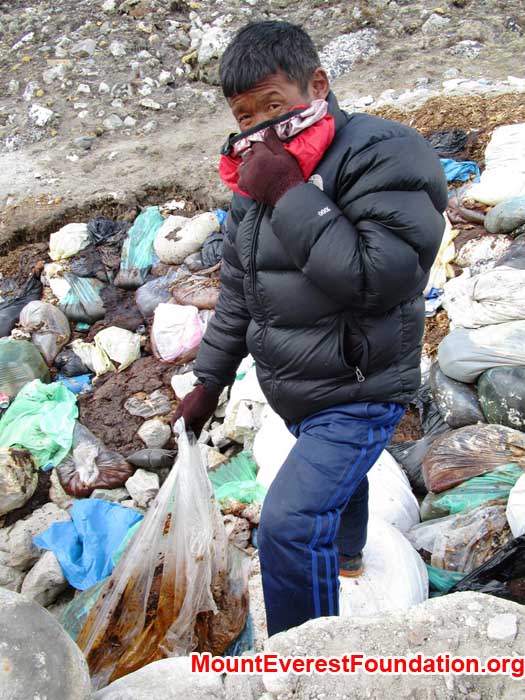
Mike Marsolek samples biogas reactor effluent while Bed Mani Dahal from Kathmandu University looks on. Mingma Sherpa collect human waste sample from Everest base camp.
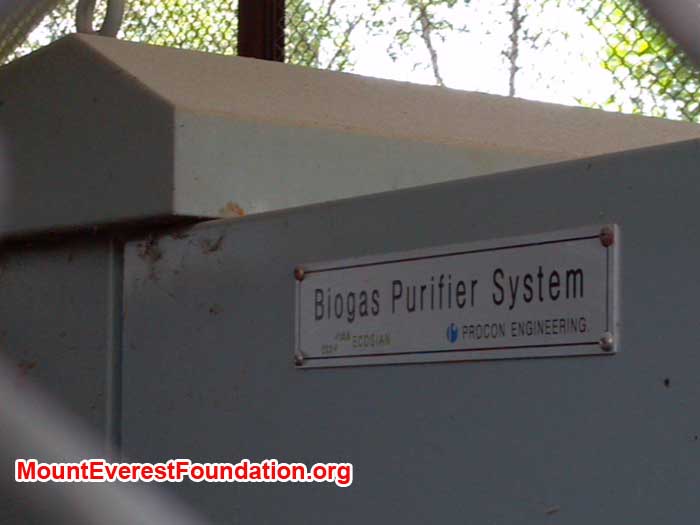
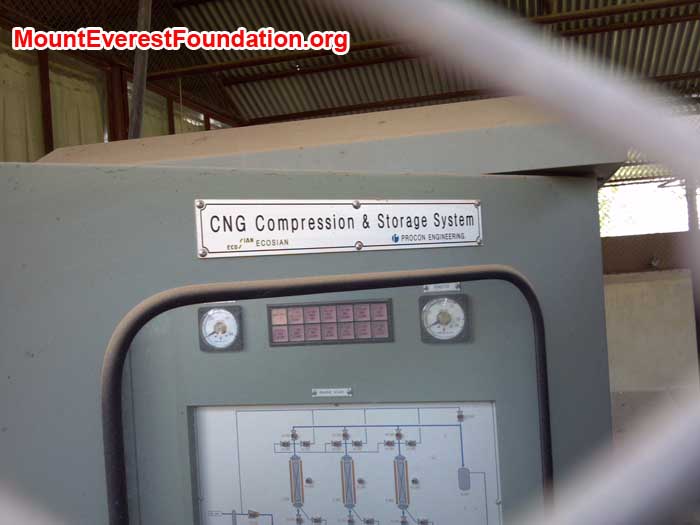
Large scale biogas purification system lies idle at Kathmandu University. Mike Marsolek photo. Large scale biogas tank filling system lays idle at Kathmandu University. Mike Marsolek photo. back to top
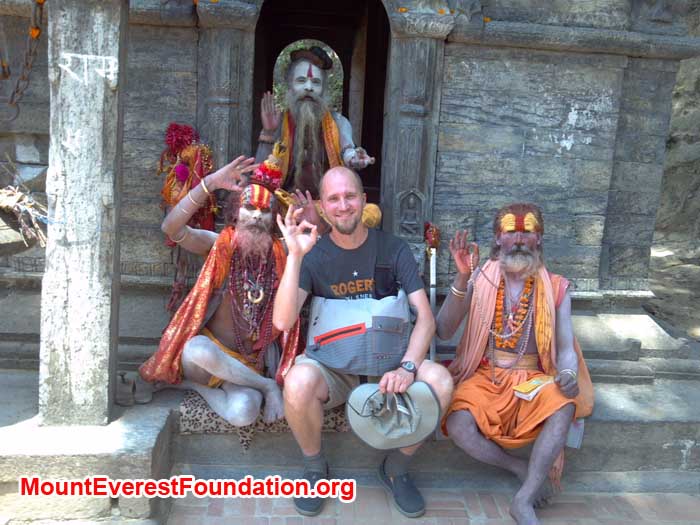
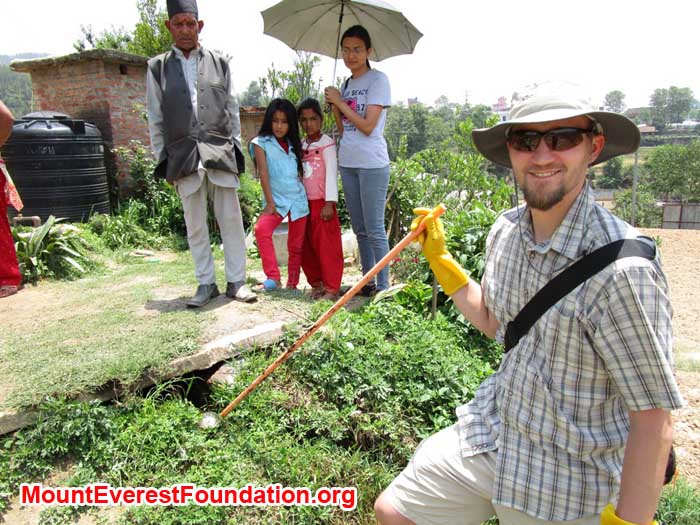
Mike Marsolek poses with holy men at Pashupatinath Temple in Kathmandu. Photo by Nepali Guide. Nepali family watch while Mike Marsolek from Seattle Uinversity checks the outlet from their biogas reactor
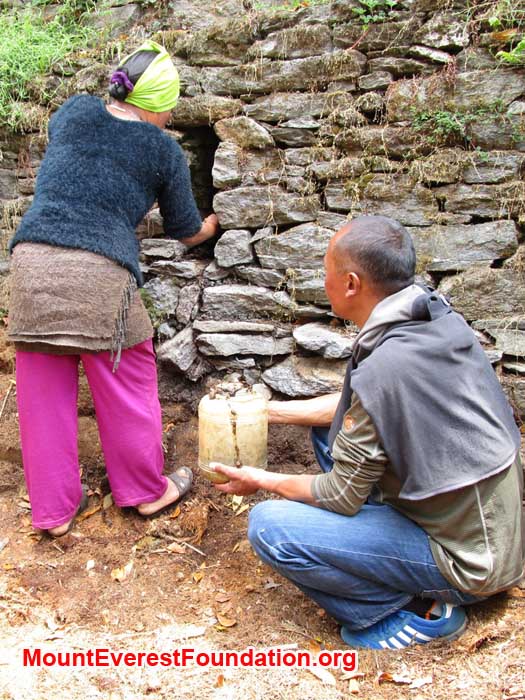
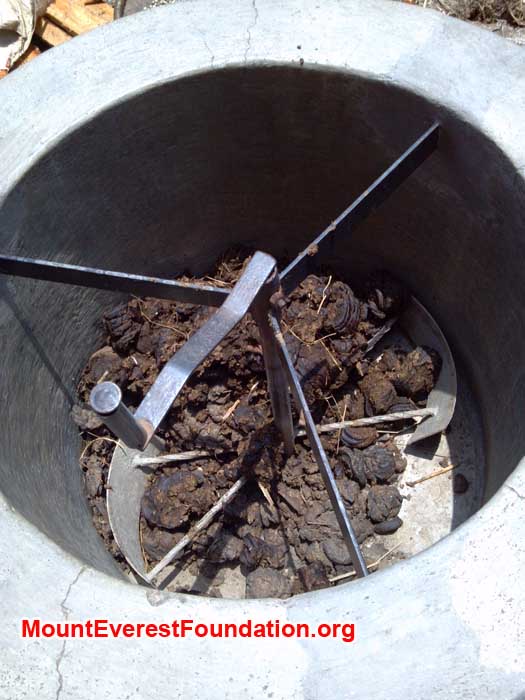
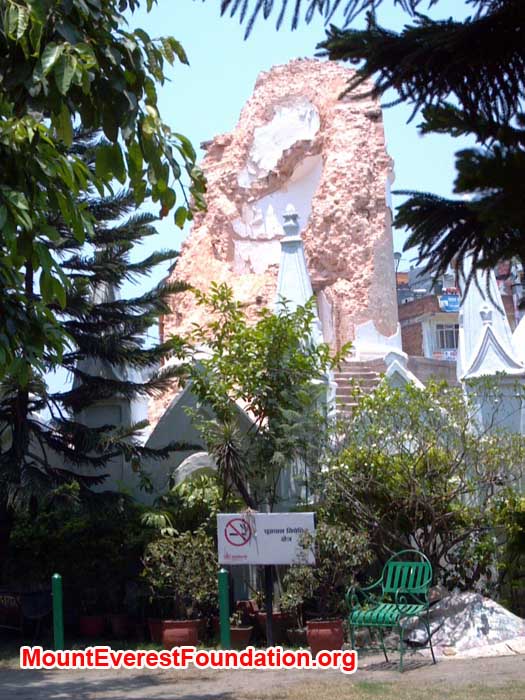
Photo number 1 - Puti Sherpa and Thile Nuru Sherpa gather a biogas sample in Lukla. Normal biogas feed stock is cow dung. Mike Marsolek Photo. Earthquake damage at Bhimsen Tower in Kathmandu. Photo by Mike Marsolek. back to top
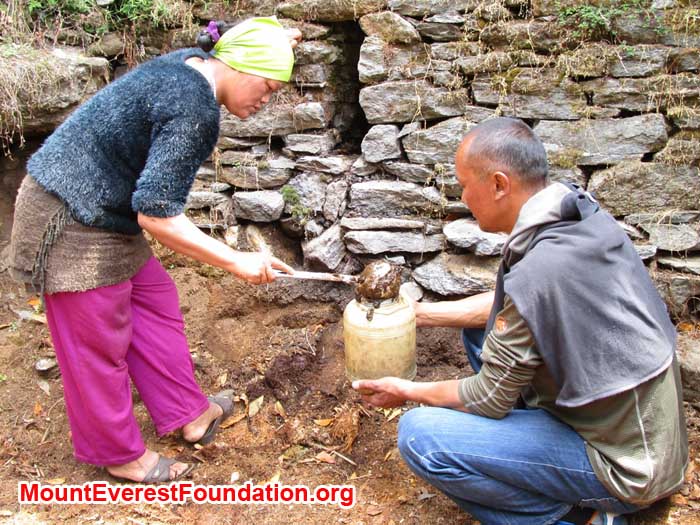
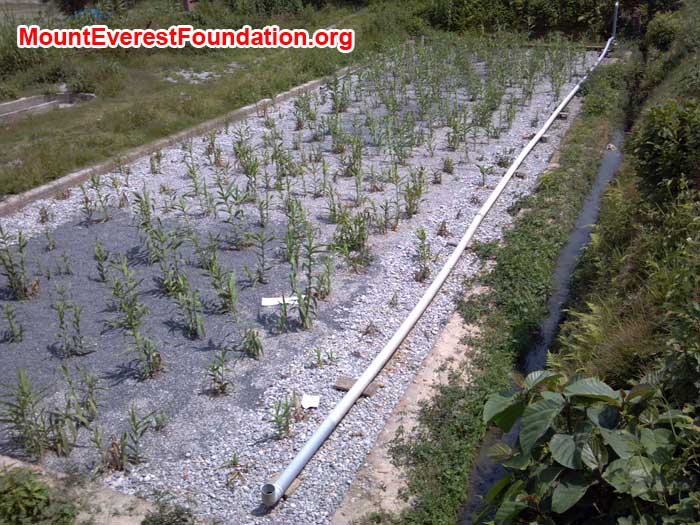
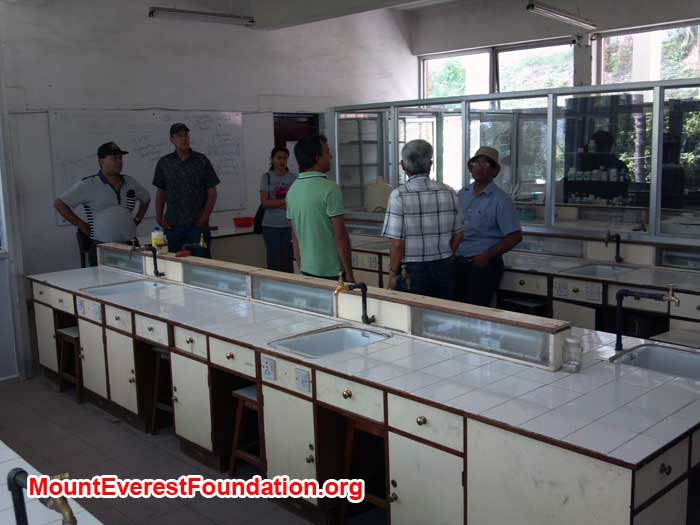
Puti Sherpa and Thile Nuru Sherpa gather a biogas sample in Lukla. Reed bed for researching alternative waste treatment at Kathmandu University. Mike Marsolek photo. Visiting laboratory and professors at Kaathmandu University. Mike Marsolek photo
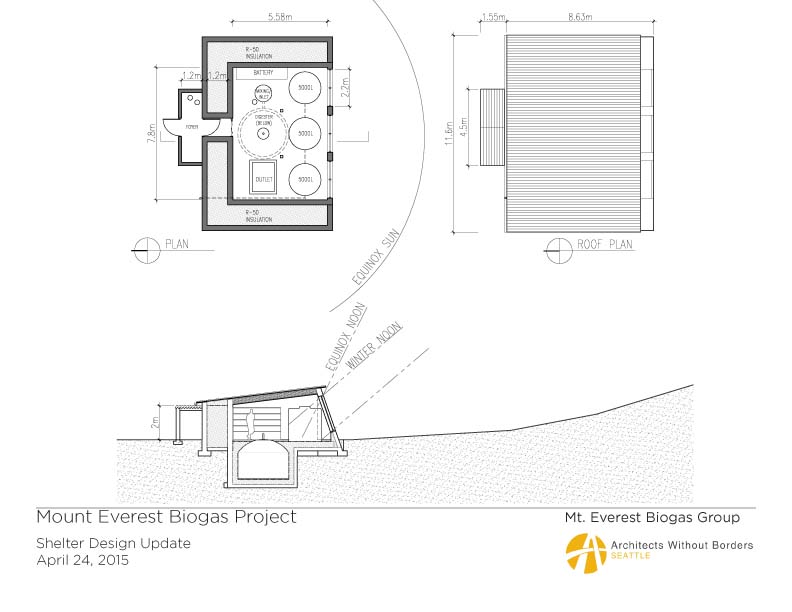
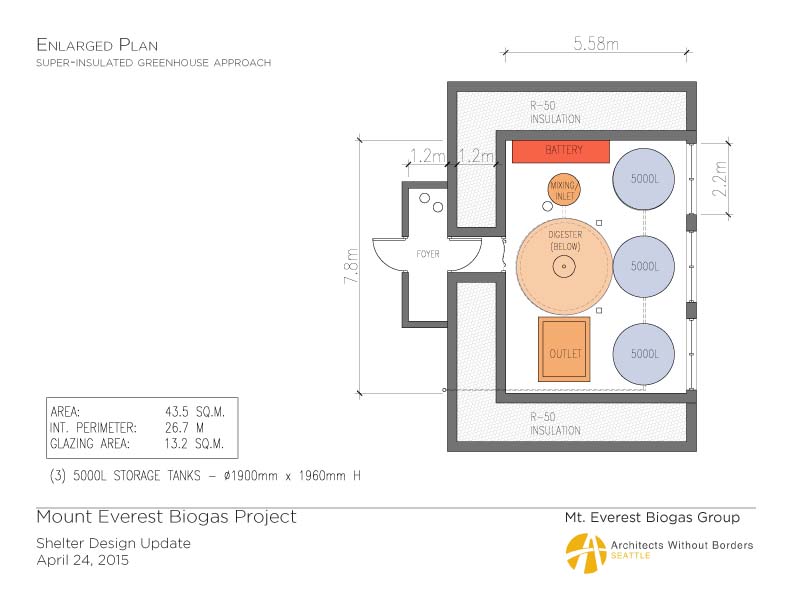
Mount Everest Is Covered In Human Poop. This Plan Could Turn It Into Energy. Article by Emily Atkin - Climate Progress . www.CleaningUpMountEverest.com .
Garry Porter remembers being at Mount Everest’s south base camp in 2003, watching Sherpa porters haul down blue barrels filled to the brim with human feces.
“What they do is, they have a poop barrel, and they haul it to a teahouse village,” Porter said, explaining how Sherpas in Nepal deal with the waste left behind by the estimated 700 climbers and guides who spend two months on Everest every climbing season. “When they get it off the mountain, they dig a hole, and dump it.”
There’s been a lot of talk lately about Mount Everest’s poop problem. In March, the chief of Nepal’s mountaineering association said so much waste had accumulated that it’s threatening to spread disease. Right now, it’s estimated that climbers leave behind up to 26,500 pounds of human feces every year.
It’s a huge issue for the Sherpa guides, and others who live and work around the mountain. “It has a serious effect to our environment,” said Kami Diki Sherpa, who runs a shelter for the Everest porters, in a 2013 interview. “It has polluted our water source.”
But with all this talk about the problem, there hasn’t been much mention of proposed solutions. And that’s because as of now, there really aren’t any — except for one. To build an anaerobic digester in a small village near Everest’s base, and convert all that human poop to biogas, which can then be used by the Sherpas as an energy source. back to top
If and when the digester becomes fully operational, it would prevent the nearly 14 tons of solid waste dumped in pits every year, with some additional growth capability for the waste already on the mountain. It would not address the excrement from the current tea houses, where thousands of trekkers arrive annually — but if it’s successful, a secondary digester could be built.
“It is kind of crazy,” said Porter. “But we’re doing it.”
Before he retired, Porter was a lead engineer at Boeing, where he managed a fleet of aircraft for NATO. But he was and is also a climber — he scaled Mount Everest back in 2003, making it all the way to the South Summit (that’s less than a mile away from the true summit, but he says he was forced down due to high winds).
When he returned to base camp, he noticed the porters carrying down the blue barrels of human excrement. He didn’t like it — it was “unceremonious,” he said. And when he talked to the Sherpas down in the small village of Gorak Shep at the base of the mountain, where the waste was dumped, he felt even worse.
“This mountain is sacred to them,” Porter said. “Us Westerners leave our crap on their mountain, and it just didn’t seem right.”
Kami Diki Sherpa, who works in Gorak Shep and was interviewed by Porter’s team about the biogas project, agreed. “We Sherpa people believe this entire mountain as abode for our deities,” she said. “We worship our mountains. We don’t even go to climb just by ourselves for fun as respect to our deity. Such pollutions are very offensive for our deities.”
After that experience, Porter said he wanted to spend his time giving back to the Nepalese people. Lucky for him, he was retired. “I was looking for something that really challenged me,” he said. “And this was it.”
"Us Westerners leave our crap on their mountain, and it just didn’t seem right.
So he contacted his friend Dan Mazur, an urban planner and Everest guide who’s lived half his life in Nepal, and they agreed: they’d build an anaerobic digester, a big metal vat full of water and microorganisms that break down waste and produce biogas.
These systems are pretty widely used. In Washington D.C., for example, the Water and Sewer Authority has an on-site digester that processes 1,600 tons of excrement into biogas every day. The gas produced there provides enough energy to keep parts of the city’s water treatment plant running if extreme weather knocks out power to the area.
Digesters are arguably even better, though, when they’re in poor or developing countries. According to the Center for Climate and Energy Solutions, small-scale anaerobic digesters like the one Porter and Mazur want to build on Everest are commonly used in rural communities to meet heating and cooking needs. China, for example, has an estimated 8 million anaerobic digesters. Nepal — where the one in question would be built — already has 50,000.
But building a digester on Mount Everest would be uniquely difficult. To do it, Porter and Mazur would have to figure out how to keep it running without access to power lines. They’d have to figure out how to keep it warm and functional in Everest’s frigid, harsh environment. They’d need to find a way to use local materials to build it, and local workers to monitor and operate it. And they’d do it all via volunteer work, without being paid a dime.
It’s been 12 years since that decision, which began what is now called the Mount Everest Biogas Project. But, Porter says, the end result is finally on the horizon.
After more than a decade, partnering with a 12-person all-volunteer staff mostly based in Seattle, Washington, Porter says he’s finally figured out the solution to his biggest problem — how do you keep a digester running at a warm temperature at the base of one of the coldest, windiest places in the world?
To understand that, it’s good to know the basics of how digesters work. With a digester, instead of dumping collected waste it in a pit, it would be put in a big tank. In this case, the tank would be about the size of a small car. There, microbacteria would feed on mixture of organic waste and water, producing biogas. But in order to keep the microorganisms processing the waste, the digester must maintain a temperature of between 68 and 86 degrees Fahrenheit. It cannot dip under that temperature, because if it does, “it will shut down,” Porter said. “Then you’ve either got to clean it out and start over, or get it warm again.” Not a very pleasant process for a vat of liquid feces.
Fortunately, there is a power source already established at Gorak Shep that Porter says can keep the digester running: solar power.
According to Porter, a solar array will charge up a bank of batteries; the batteries will drive a resistance coil — the same type of inductor that powers home water — and the coil will heat up the digester.
“It’s not a high-tech solution,” Porter said.
It really can’t be high-tech if it’s going to work on or around Mount Everest. Gorak Shep, a village consisting of only six or so teahouses (where climbers rest and get food), is extremely remote. Any material that the digester needs must be able to be sourced from there, or must be brought up by humans, or by yaks.
"… there’s a good chance you get a touch of altitude sickness …
“It’s a five to six day hike, 17,000 feet,” Porter said. “You’re gonna feel it, and there’s a good chance you get a touch of altitude sickness doing it.”
But Porter says he’s figured it out. He and his team have run their data by consulting firms EcoTope and OutBack Power Technologies to confirm their calculations — that a digester can, in fact, run consistently in such a high altitude and harsh weather. And now, they’re teaming up with Architects Without Borders to find the best way to build a shelter around the digester, to keep it from being directly exposed to the elements. back to top
When that’s done — sometime this year, Porter says — the Mount Everest Biogas Project will begin fundraising. They’ll start construction of the digester at Gorak Shep. For a year, they’ll run it solely with water, to prove it can stay heated, and train the Sherpas how to operate it. And if all goes well, Porter says the digester should be processing human poop into energy .
For what it’s worth, Sherpas interviewed enthusiastically welcomed the possibility of a digester on the mountain. But Pasang Chhering Sherpa, owner of the Himalayan Lodge, was skeptical it could be done.
“I liked the concept very much but it has been few years that you have been doing the survey but we did not see any results, I hope it won’t disappear,” he said. “There are so many researchers come here with different subject but they never come back with the result.”
One of the managers of D.C.’s anaerobic digester system, however, said the idea should work if Porter’s heating system is consistent, and if there is enough waste to keep the system running at all times.
“Digesters are very fickle, and they crave consistency … You have to have enough mass to keep the heat,” said Chris Peot, the director of resource recovery at D.C. Water. “But in theory, it certainly should work.”
Aside from keeping the system heated, another potential obstacle is that human feces is not a great fuel for a digester — compared to animal excrement, it does not produce a ton of methane. “It will work,” Porter said, “it just won’t produce as much gas for a given volume of waste.” In other words, a lot of poop will be needed to make a little bit of fuel.
Fortunately, Mount Everest has no shortage. If the digester processes all the waste it can, it would produce approximately 35,000 cubic feet of biogas every year. That’s not enough to totally power Gorak Shep, but Porter says it could much-needed nearly sustainable fuel.
Whether the digester works or doesn’t, though, it’s clear something has to be done soon. As tourism only stands to increase on the mountain, so does the waste problem — and the waste problem only stands to get worse with climate change, which is expected to cause thawing that unearths waste that’s been frozen for decades.
“Yes, climate change makes the shit problem much worse,” John All, director of the American Climber Science Program, told ThinkProgress. “Throughout history, we have dumped waste into crevasses and it disappeared. Now the glaciers are what is disappearing, and there is nowhere for the waste to go.”
“Additionally, because it is far warmer then it used to be, the waste doesn’t stay frozen and the smell becomes quite potent in the heat of the day,” he added. back to top
One thing that’s clear is who should pay for cleaning it up: the climbers. Though Porter estimates the digester could be costly — anywhere up to $100,000, he said — an extra charge within the now-$25,000 climbing fee is small price to pay for getting to scale the highest mountain in the world.
“It’s climbers’ poop, so guess who’s going to pay to keep this thing going,” he said. ” You! It’s your poop.”
Mount Everest Bio Gas Community Survey 27th May
Village Name – Gorokshape
Altitude – 5128 mts. asl
Number of Tea houses - 6 including a porter Shelter.
1) Pemba Nima Sherpa (Tea house owner – Snow Land Highest Inn)
What do you think about the human wastes coming from Everest Base camp?
-Ohh… awful... Pollution everywhere. Our main water source has been polluted. The dumping site is along the main trail to EBC, sometimes our local animals (yaks) fall into the pit. Even though it has been moved to different location now, I think it takes so many years to disintegrate because of the cold climate the pollution will remain there for many years.
- What do you think about the bio gas plant project?
Good solution, but I have not seen anybody using Bio Gas above 2600 mts. would be very challenging but now you guys came up with Engineer so we are positive.
- How will the local benefit from the project?
The most importantly we will get rid of every year growing human waste pollution problem, secondly if the plant works fine then we will benefit as fuel or electricity, at least the Porter shelter will be benefited.
2) Phura Sonam Sherpa (owner, Buddha lodge and Kalapathar Lodge)
- What do you think about the human waste coming from the EBC?
Somehow we benefited from mountaineers and expeditions but the human waste from EBC….. That’s has been a big issue for many years. In the beginning the quantity of human waste was manageable but over years the number of expeditions grew up and now it is big problem and there is not any solutions..
The dumping sites are everywhere, porters wash the barrels in the lake, and also it has been big problem for the animals, it has ruined the scenery and the environment. Now no open space left for more dumping sites so it has been moved near the Changri Glacier but same problem will continue. I don’t see any solution. Also the new site is
Just above the main trail.
- What do you think about the Bio gas plant project?
It is very good news for us but since it is cold place, it won’t be easy. We are thankful to you guys for kept trying and positive about the success of the project.
- How you will benefit from this Bio gas project?
First of all, not only this particular community but whole valley will have a less polluted glacier, the most popular destination, the Everest base camp and its surroundings will have better environment with beauty.
If enough gas produced from the plant then we will have option for light and fuel. We will use less kerosene for cooking and heating.
Porters will benefit, since cheaper fuel will reduce their food expenses.
3) Pasang Chhering Sherpa (owner, Himalayan Lodge)
- What you think about the human waste problem here?
It is very big problem for us; our small community here has been directly affected. But I think the whole trekking route will face this problem, on the main route to the most popular destination EBC, in about 5 – 10 meters distance you will see those human waste dumping pit and all those blue barrels they use to carry the human waste from the base camp.
Both Khumbu and Chhangrinup glaciers are very important glaciers which feed the major river, like Dudh koshi. We are sad but we cannot do much with its fast melting problem but at least if could get some solution to stop polluting these glacier would be great help.
- What do you think about this concept of bio gas plant?
As I told you, any solution that could help to reduce pollution would be great help. I liked the concept very much but it has been few years that you have been doing the survey but we did not see any results, I hope it won’t disappear. There are so many researchers come here with different subject but they never come back with the result.
We hope this Bio gas project won’t disappoint us but it won’t be that easy because it is a cold place.
- How you will benefit from the project?
Most importantly we will have better environment here. The people who love Mt. Everest. And dream to step on top and all the helpers who help them to fulfill their dreams will feel less guilty if they see this plant which will convert their waste into something useful instead of polluting the glacier and this beautiful land.
We get cheaper fuel which means all the trekkers and porters will also be benefited.
4) Kami Diki Sherpa (owner, Yeti resort and also runs the porter shelter)
What you think about the human waste problem around here?
It has been a big problem and growing more and more every year. It has a serious affect to our environment.
We Sherpa people believe this entire mountain as abode for our deities. We worship our mountains. We don’t even go to climb just by ourselves for fun as respect to our deity. Such pollutions are very offensive for our deities.
It has polluted our water source. Now there is not any open place left for more dumping site. Because of the cold climate this waste inside the pit remains for many years. They (porters) wash those blue barrels in this lake. Now it has been moved behind this glacier (chhangrinup glacier), even that is just above the main trail. How further down it would go in future? I don’t see the solution..
- What do you think about the Bio gas plant project?
Nothing impossible! I am excited to see that here. If we could get enough gas then will be different story but even just enough for the porter shelter also will be a great help for the porters.
Everest Base Camp Drinking Water Sampling Report
27 May, . Report on Sampling conducted by Rukman Sunwar, Thile Nuru Sherpa, and Dr. Daniel Mazur, under the auspices of the Center for Urban Waters, Dr. Justin P. Miller Schulze, Dr. Andy James, in conjunction with Dr. Mike Marsolek, Seattle University, Environmental Engineering, with Garry Porter, Director of the www.MtEverestBiogasProject.org .
On 14 May, our collection team gathered 7 water samples from the following locations:
1) Mount Everest Basecamp;
2) Gorak Shep Lake;
3) Kala Pattar Spring;
4) Pipe from Pumori;
5) Gorak Shep Glacier River;
6) Kyakpa Yul Human Waste Pits;
7) Lobuche Reservoir.
These water samples were divided into three groups (A,B, and C):
A) filtered and spiked with a small amount of materials provided;
B) filtered and put into petri dishes and incubated
C) filtered and bottled. back to top
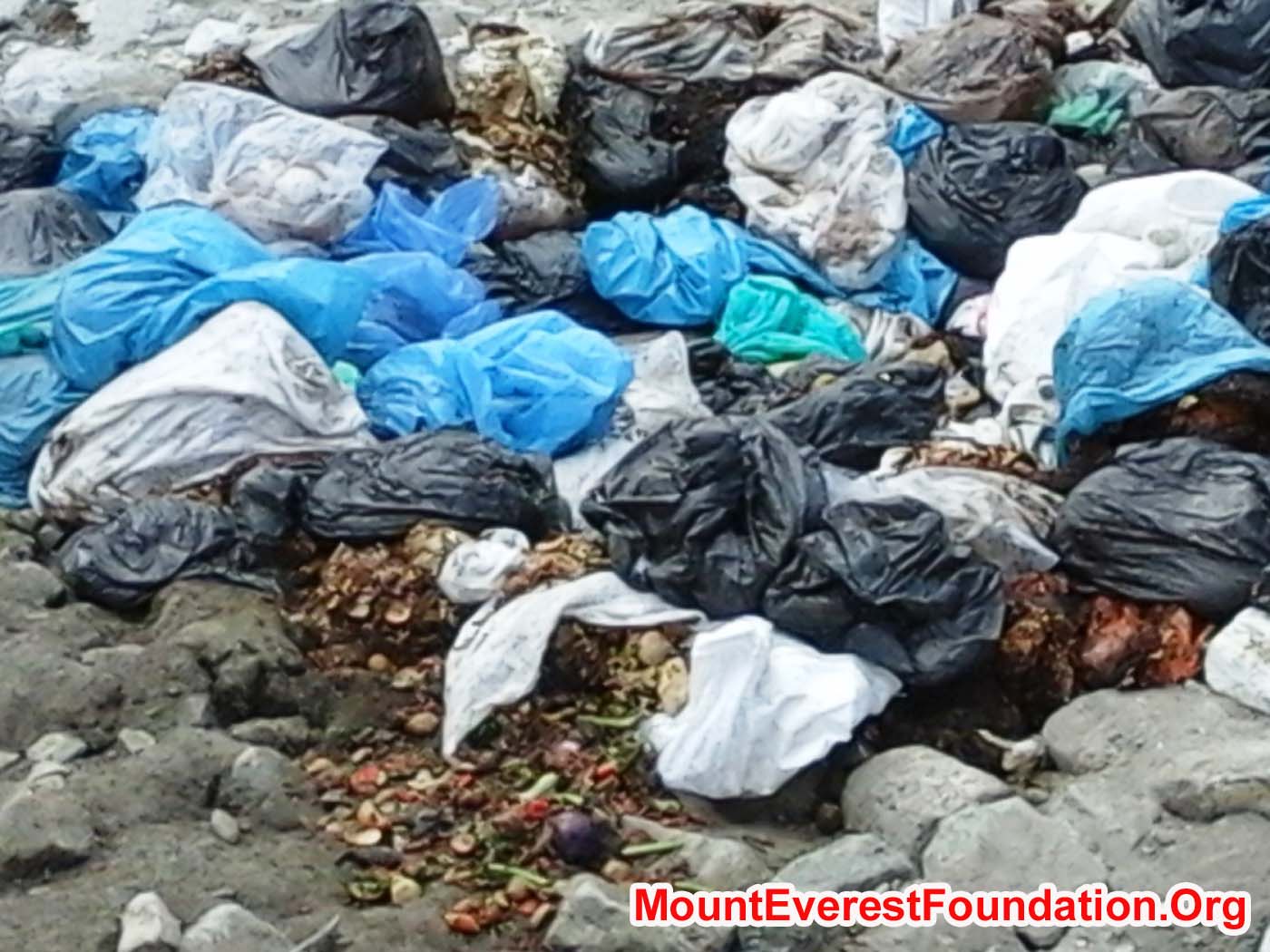
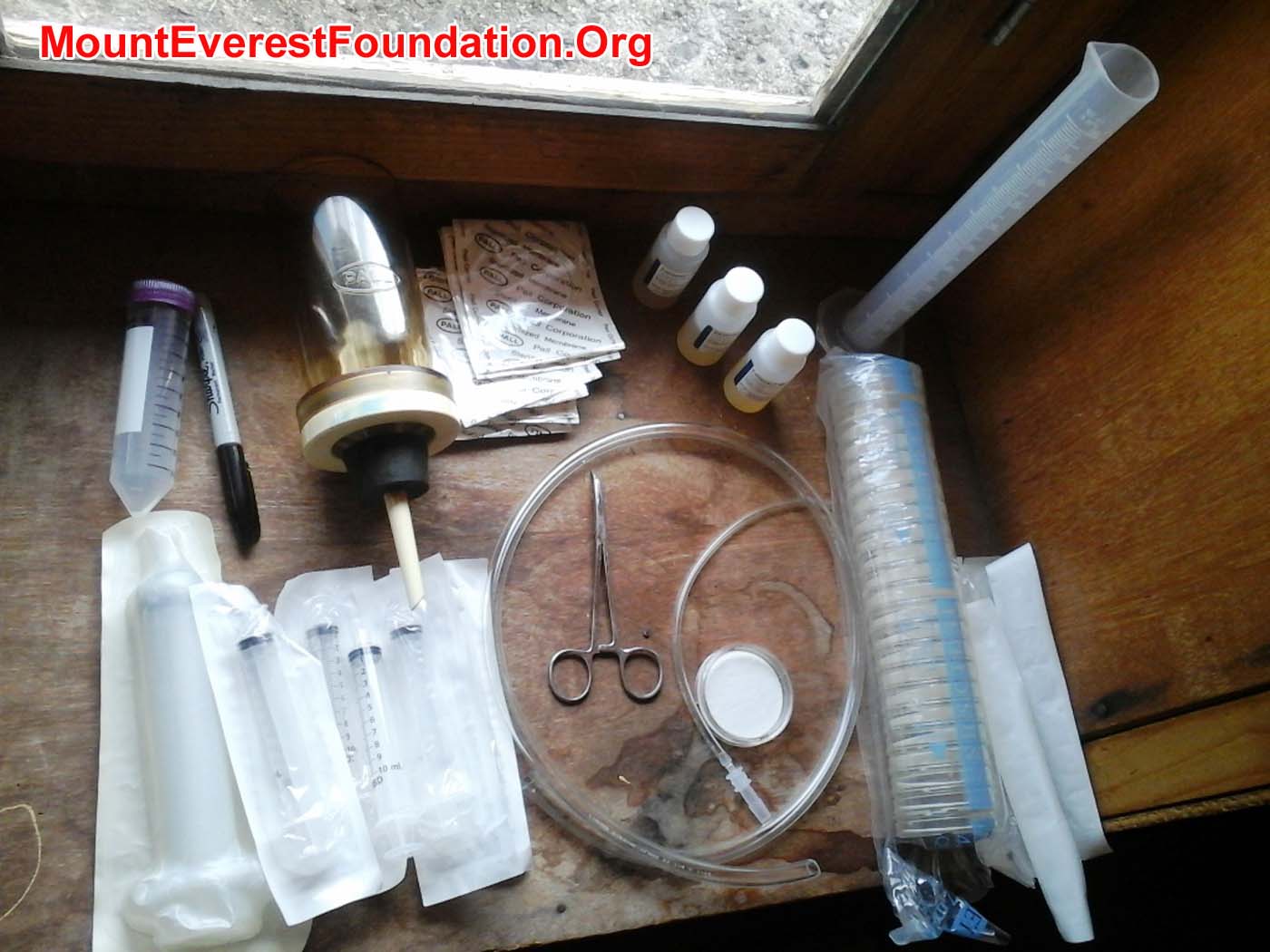
Closeup photo of waste pit contents at Kyakpa Yul Equipment used in petri dish innoculation
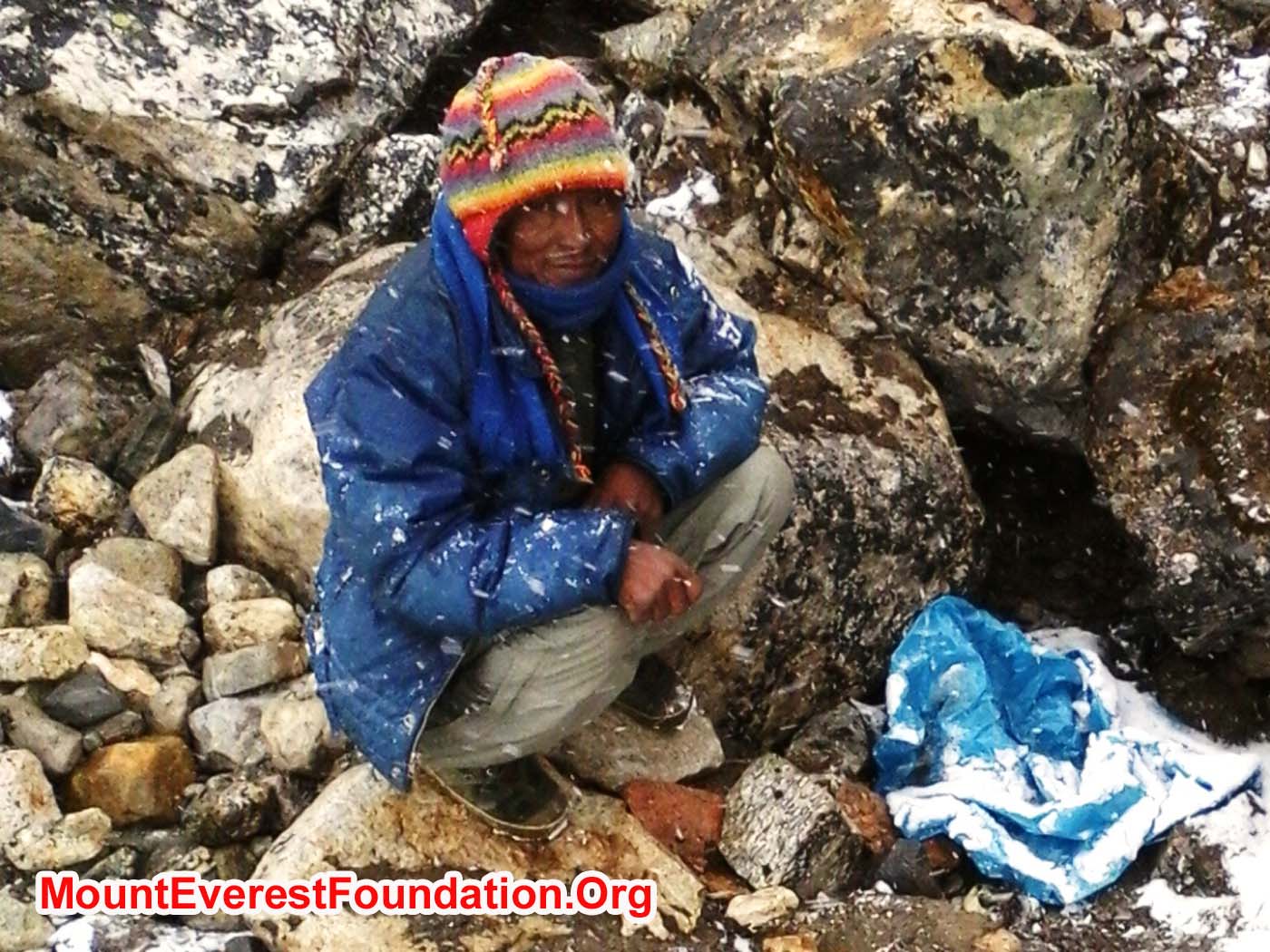
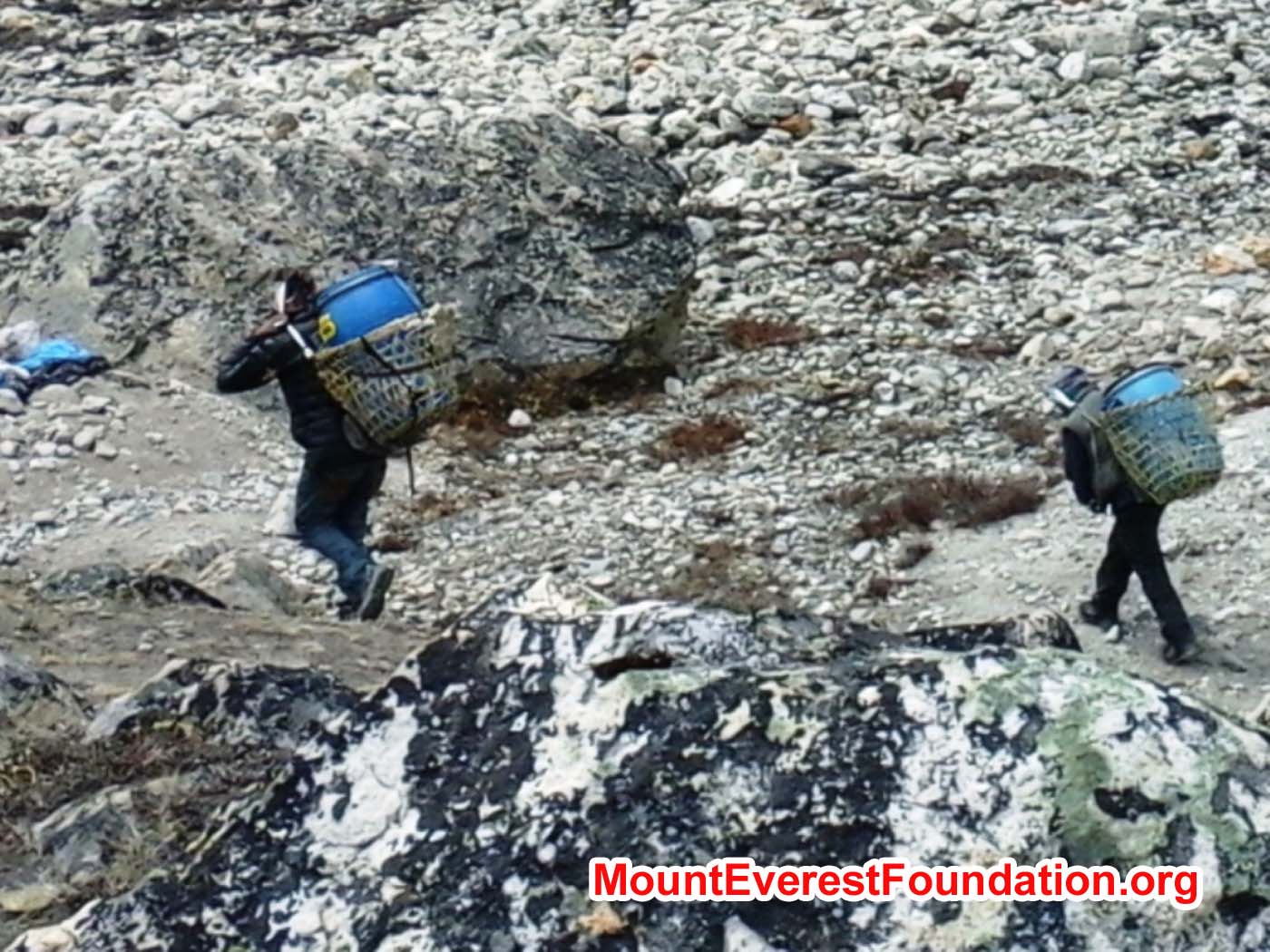
Mr. Rukman Sunwar collects a water sample at Kyakpa Yul > Porters carrying human waste drums from Mount Everest base camp to be dumped into the pits at Kyakpa Yul
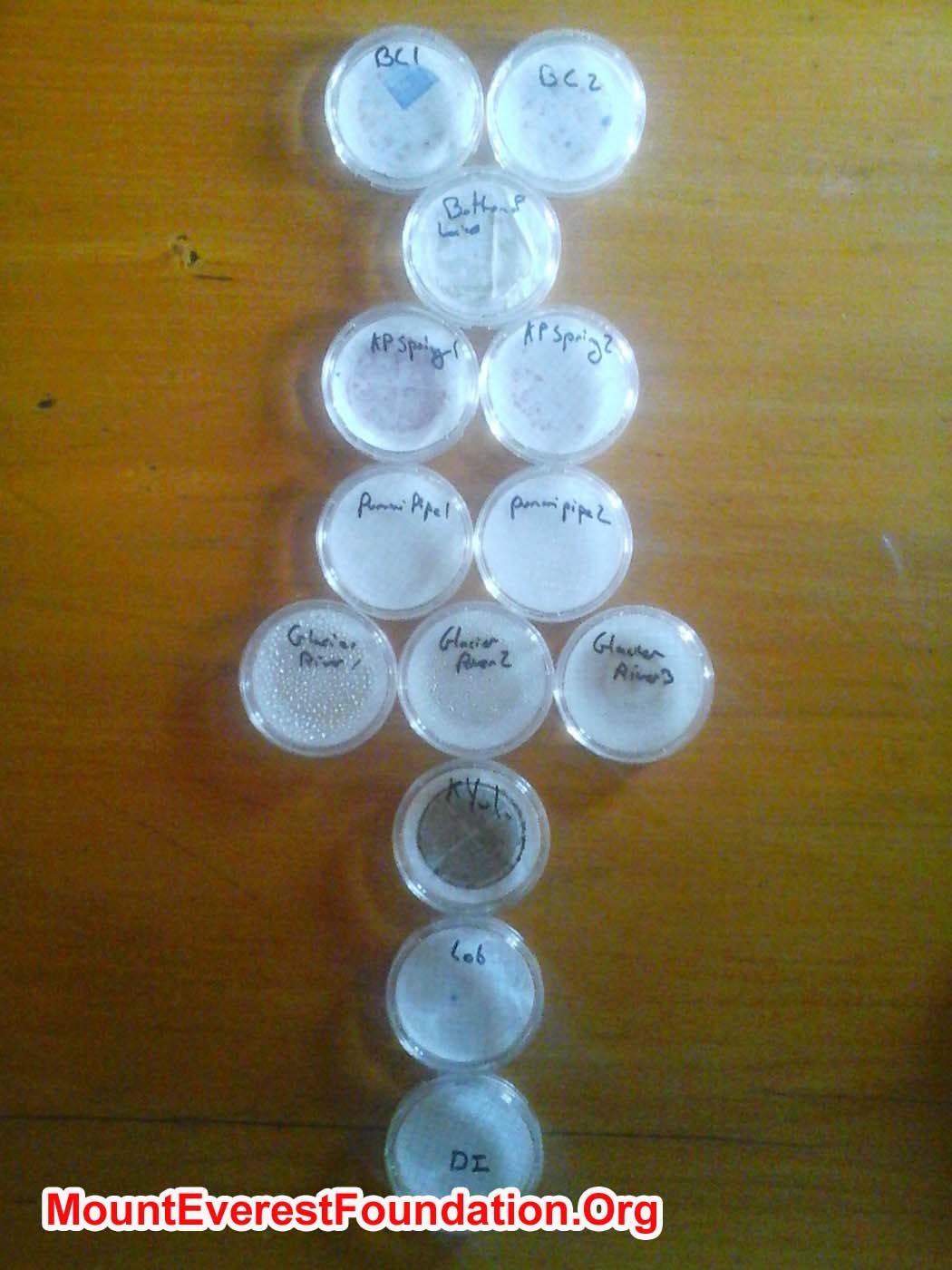
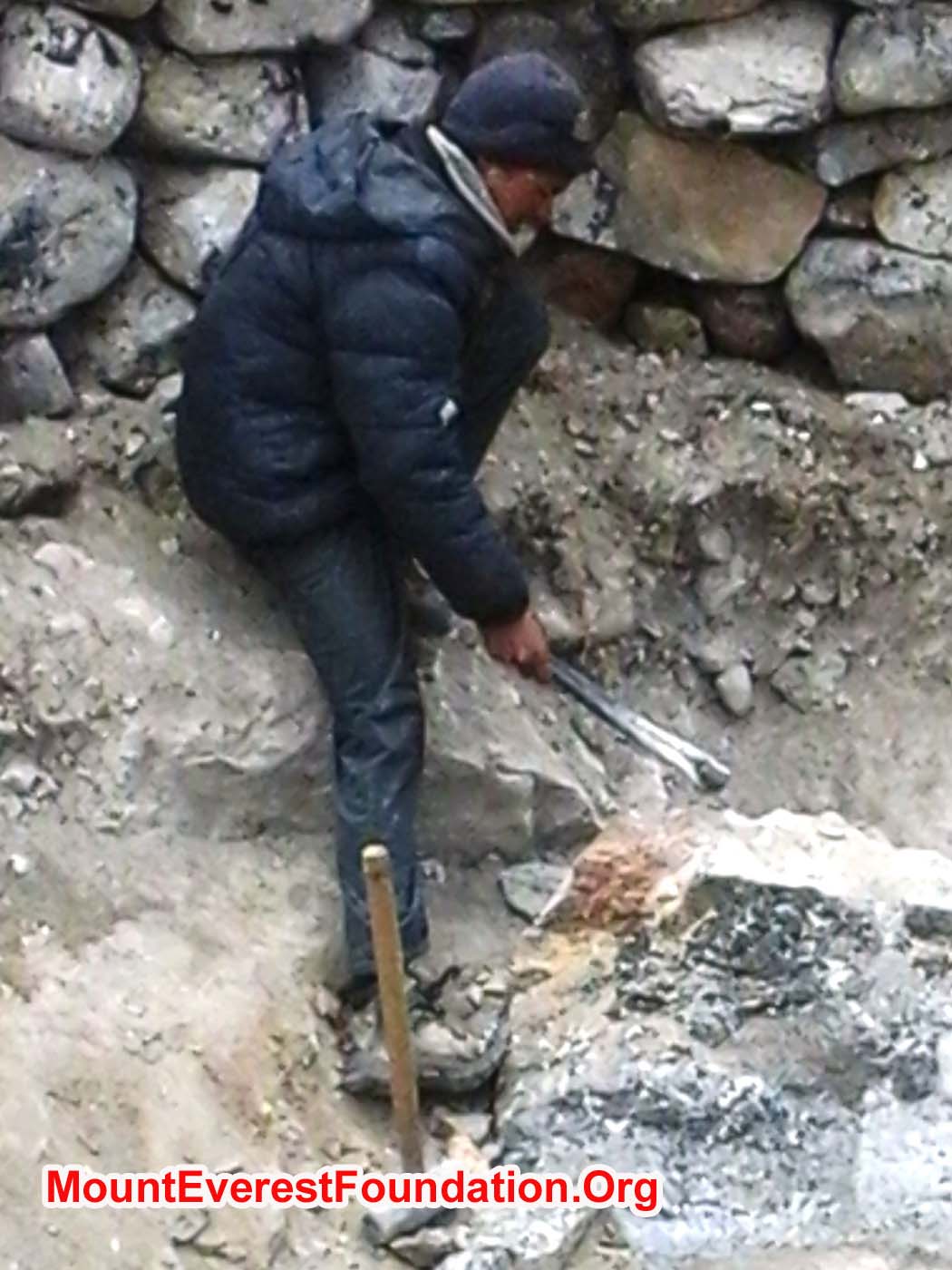
Petri dishes after incubation. Porter chops stone inside a new human waste pit at Kyapa Yul.
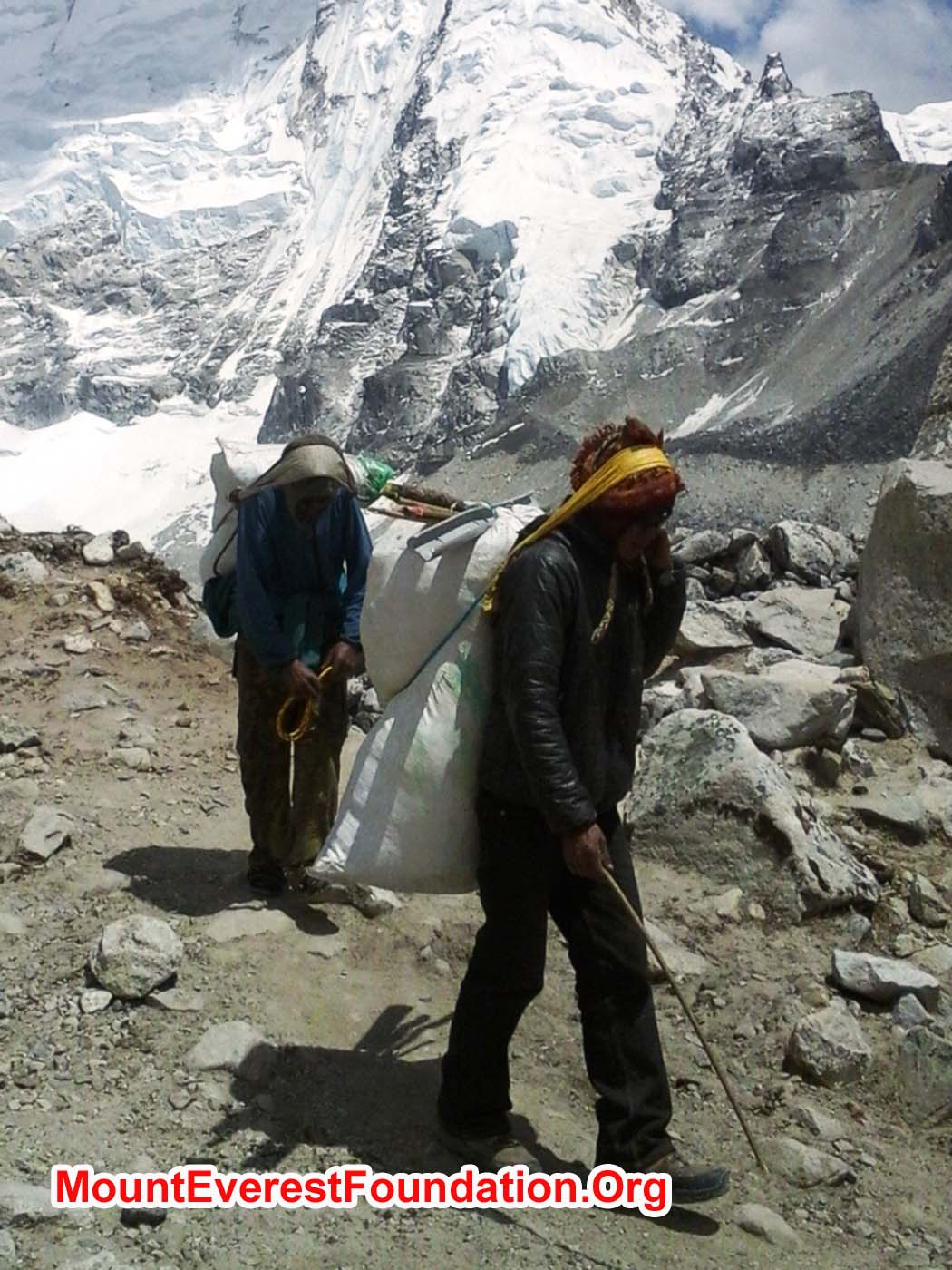
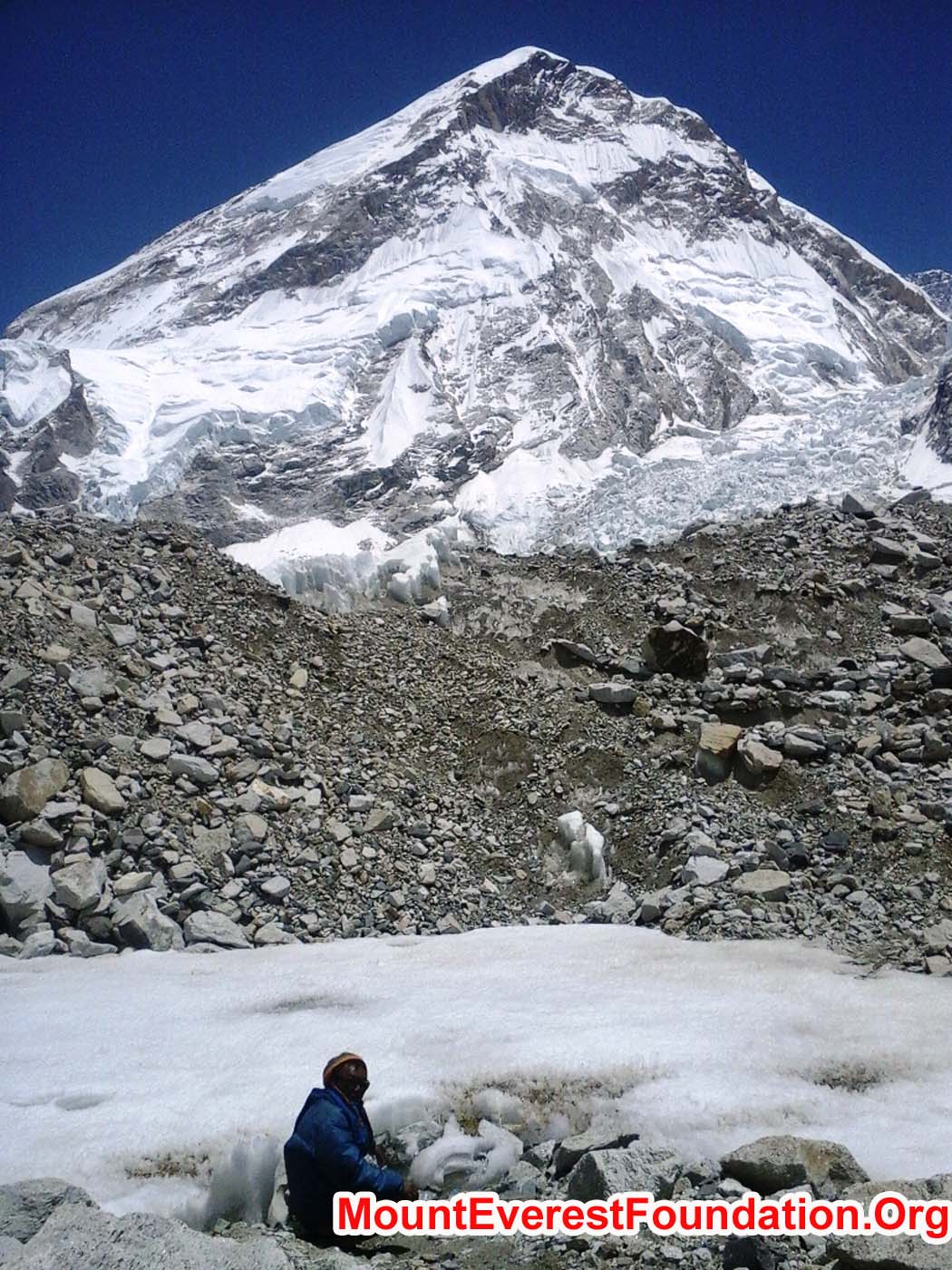
Porters carrying out tins, bottles, paper, and plastic from Mount Everest basecamp. Rukman Sunwar collecting a water sample from Mount Everest base camp.
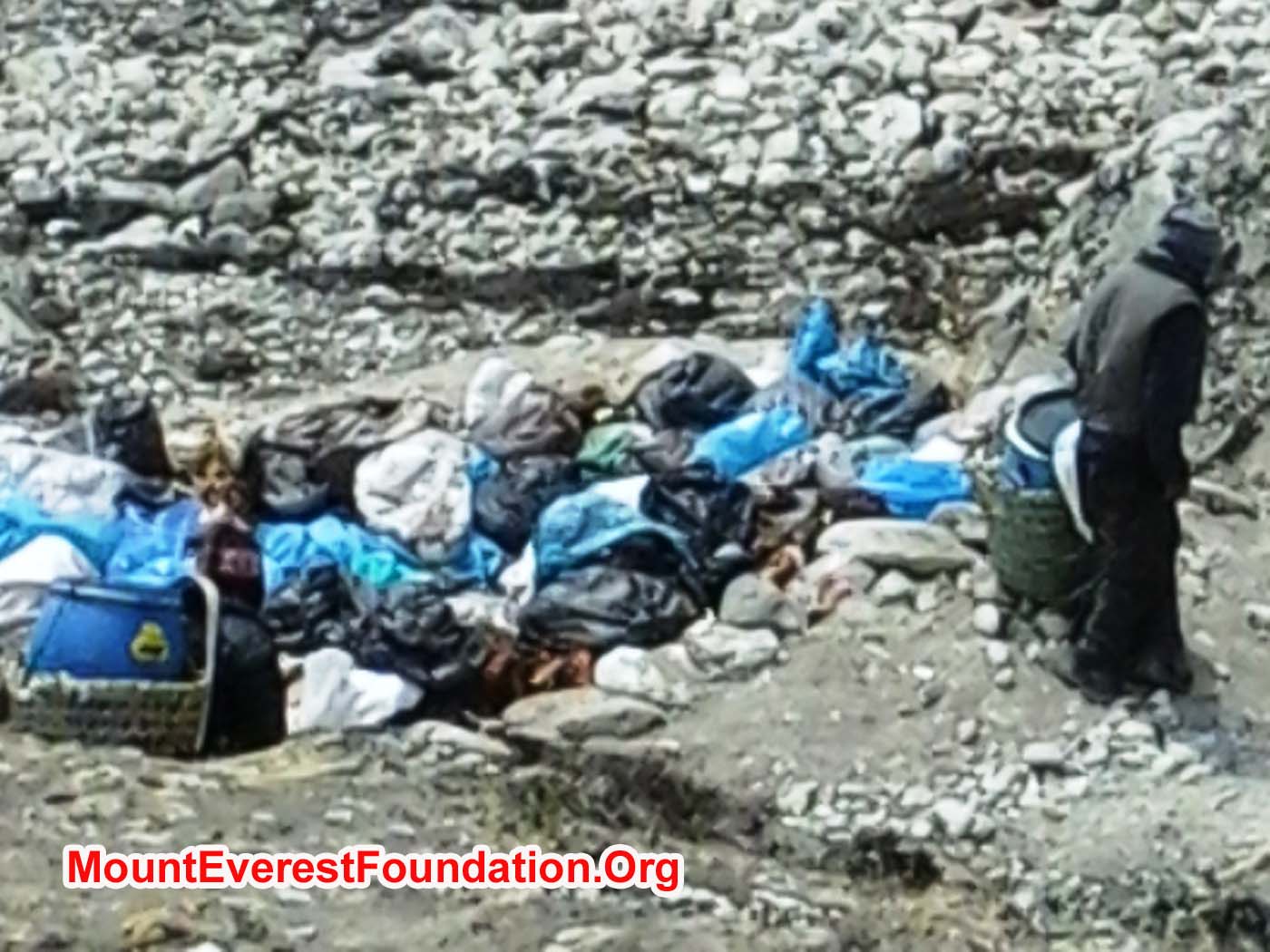
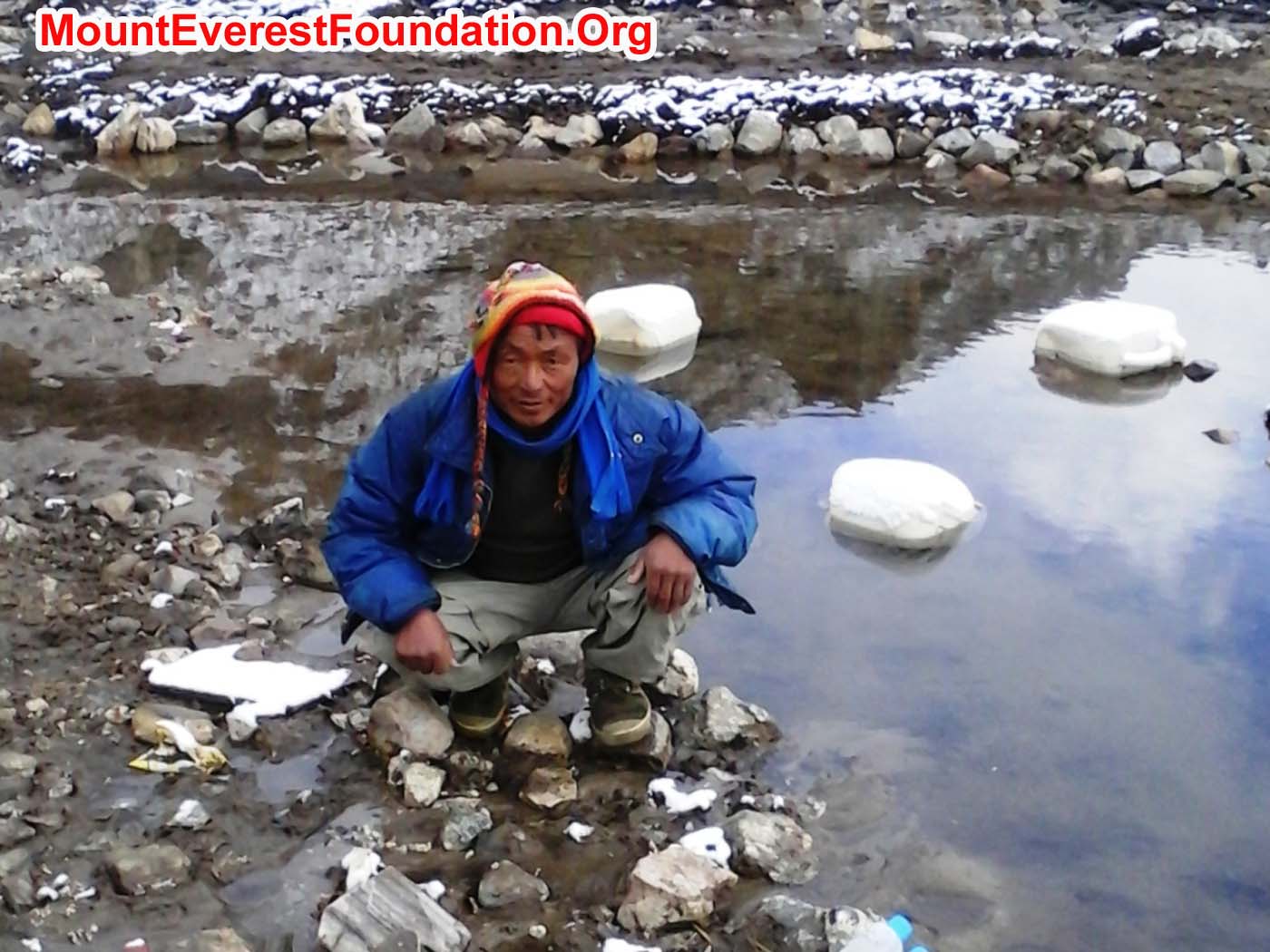
Porters preparing to empty their human waste drums from Everest basecamp into the pits at Kyakpa Yul. Rukman Sunwar collects a water sample from the Lobuche reservoir, surrounded by rubbish on all sides
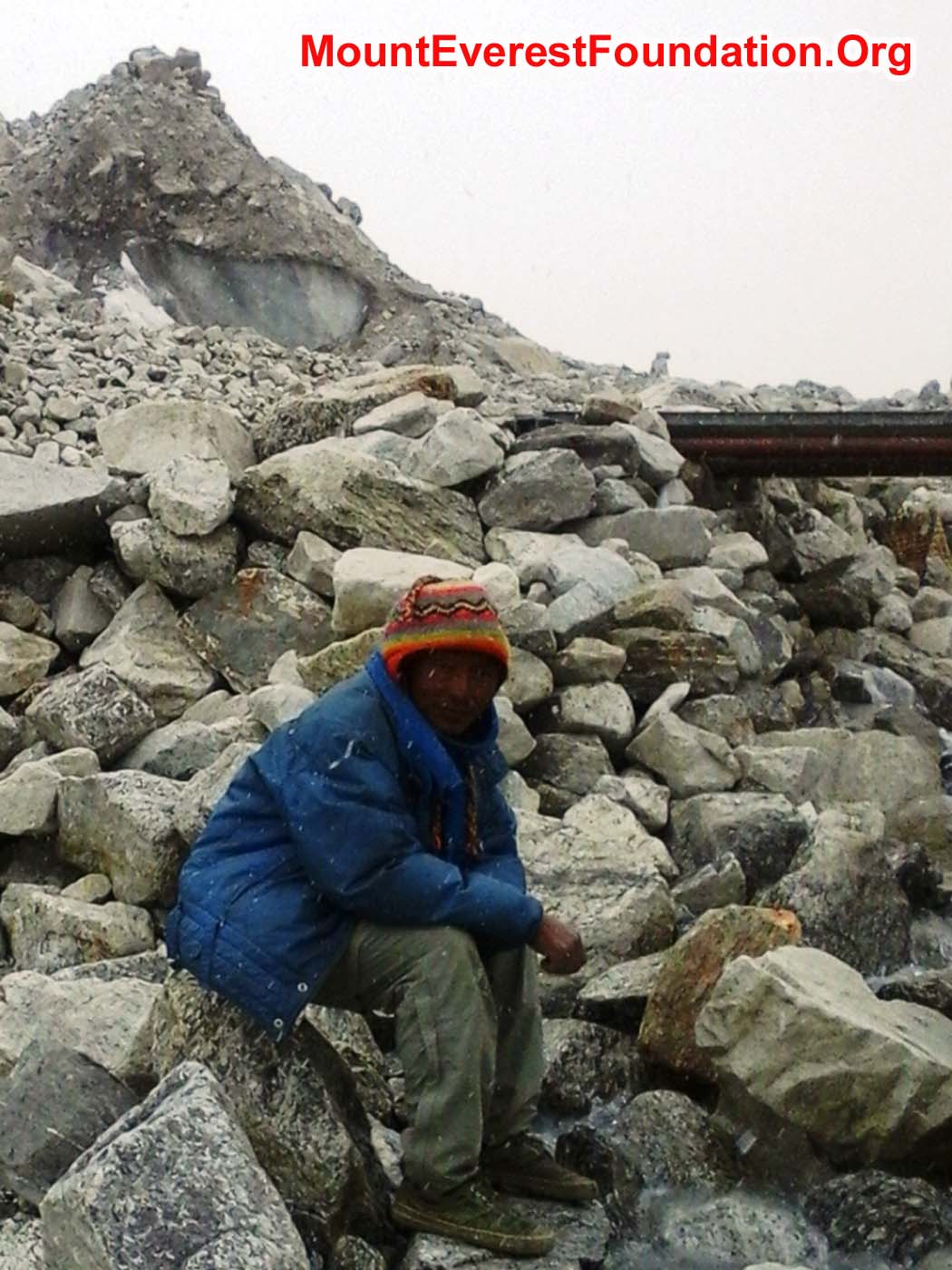
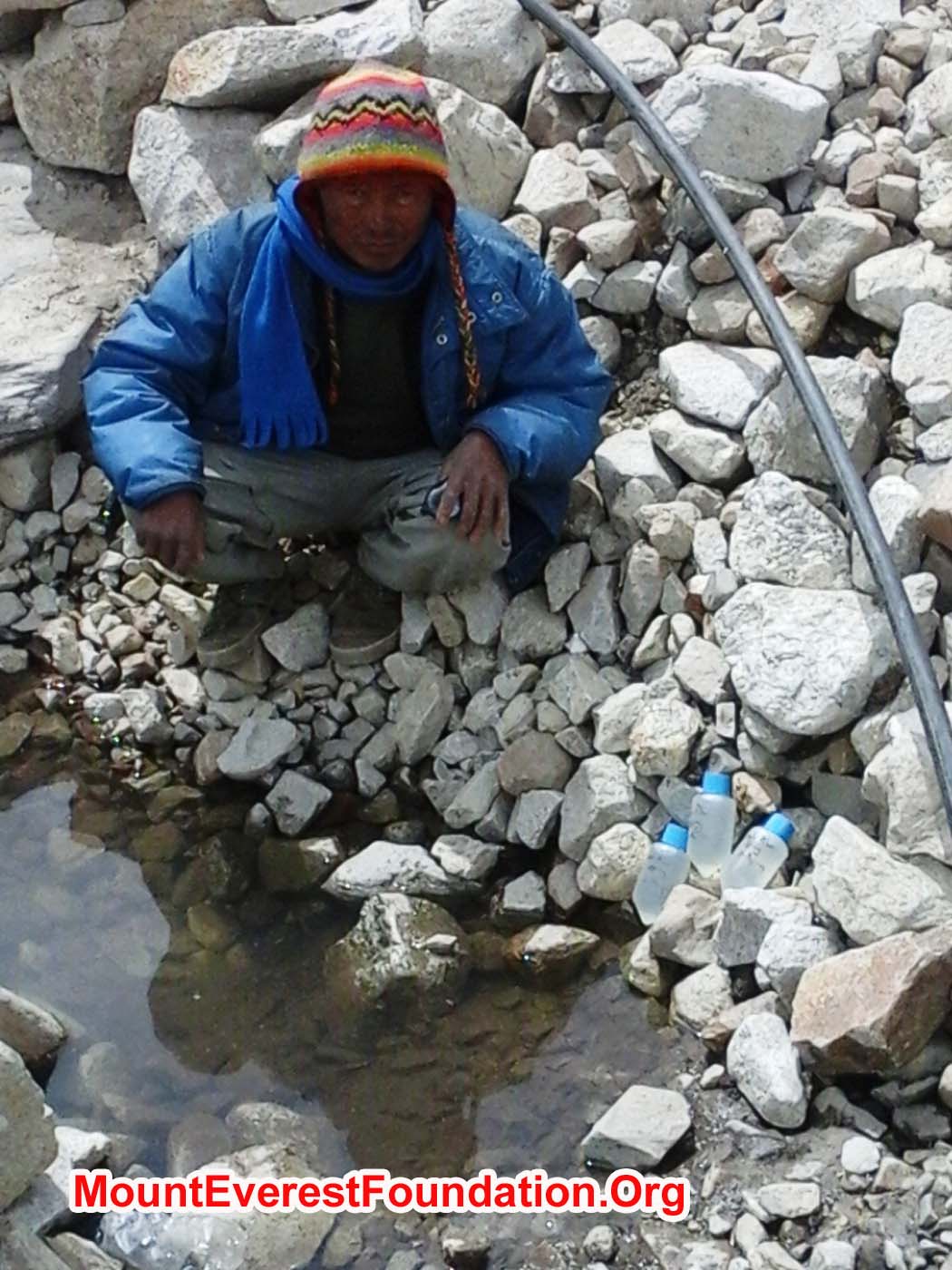
Rukman Sunwar collects a water sample during a snowstorm at the Gorak Shep Glacier. In the background one can see an ice tower and a bridge over the stream. Rukman Sunwar collects a water sample from a dirty looking pool at the Kala Pattar spring in Gorak Shep.
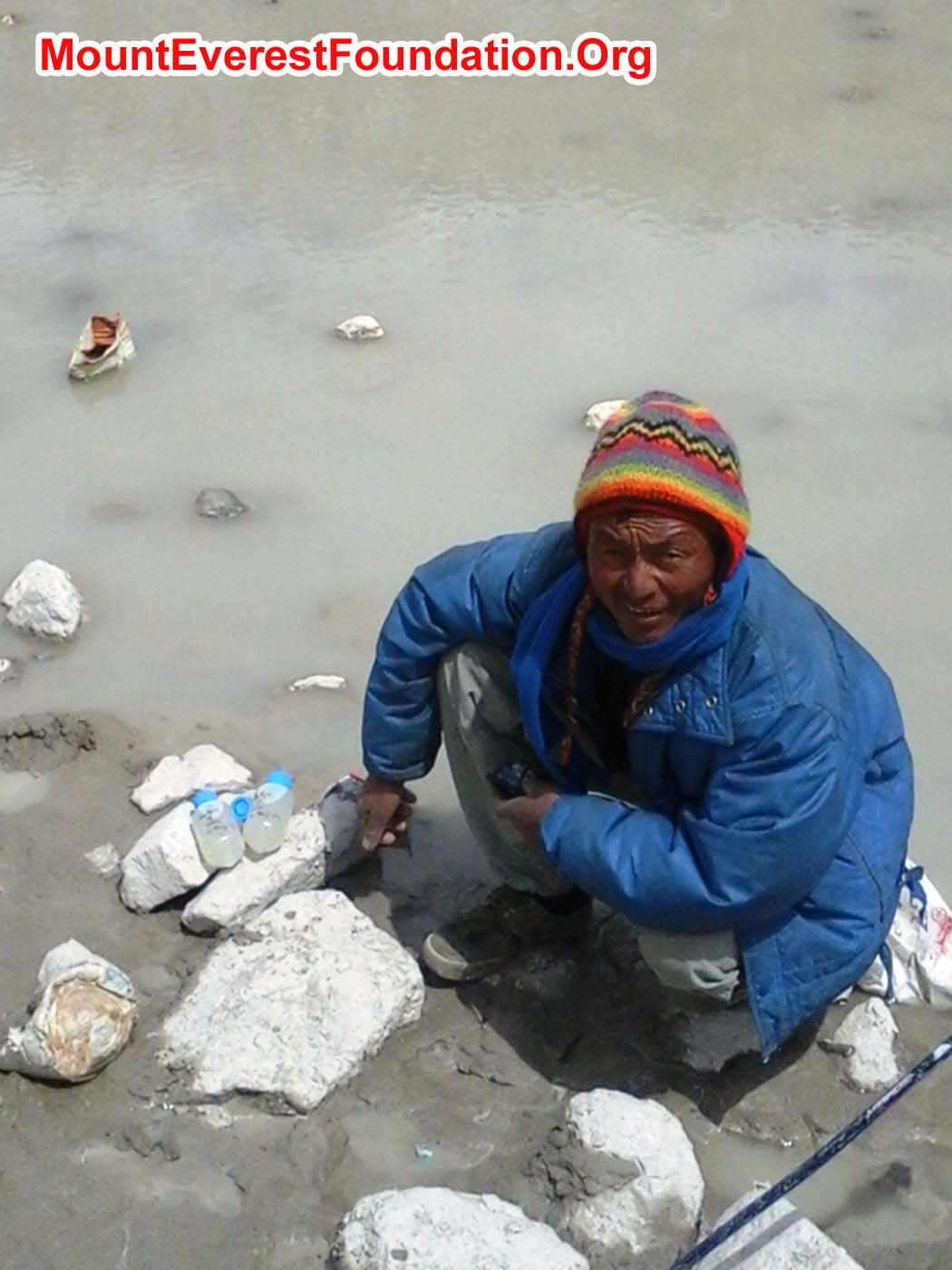
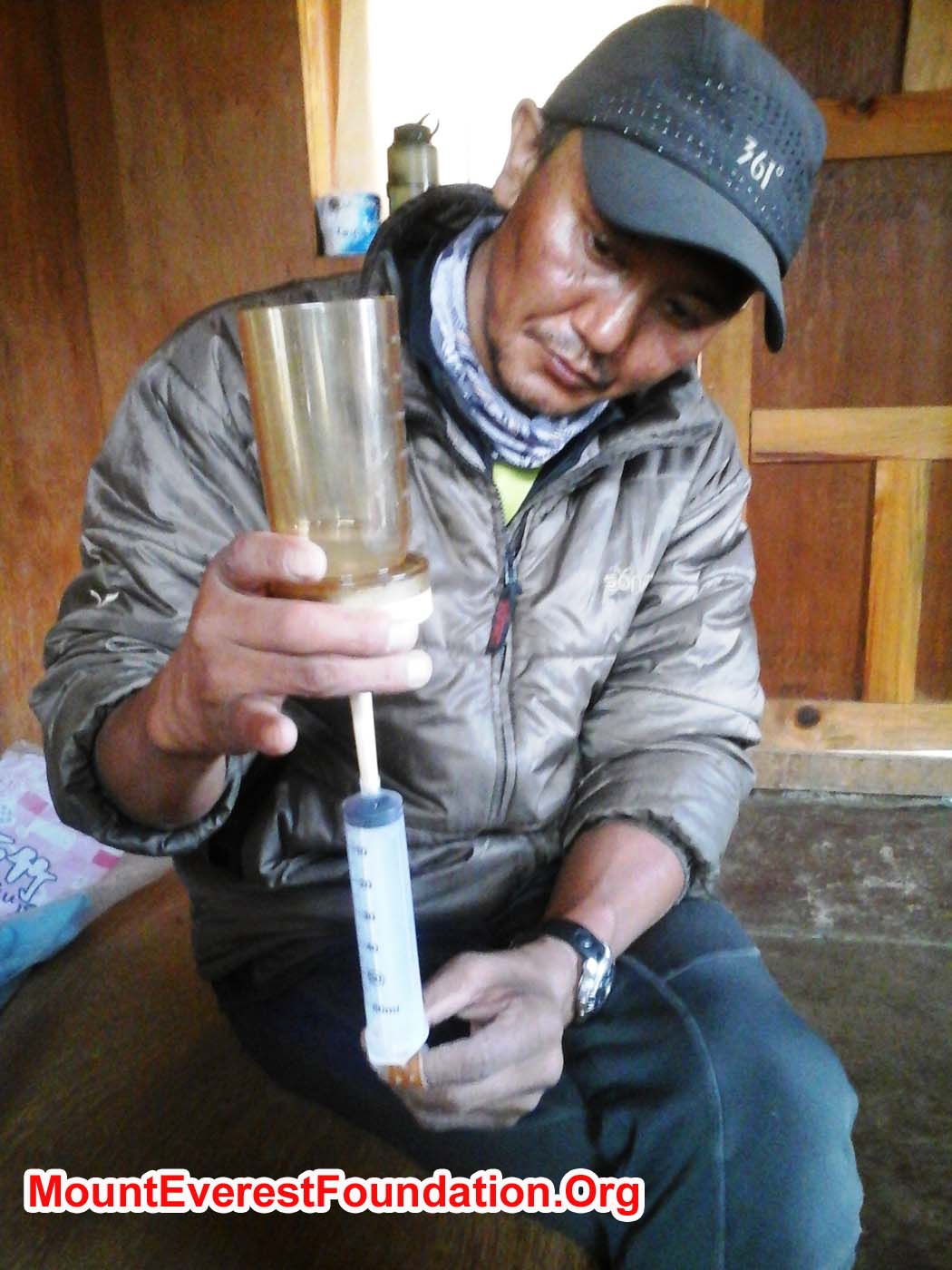
Rukman Sunwar collects a water sample from Gorak Shep Lake. Rubbish floats in the pool behind him.Thile Nuru Sherpa filters a water sample through a petri dish innoculation grid.
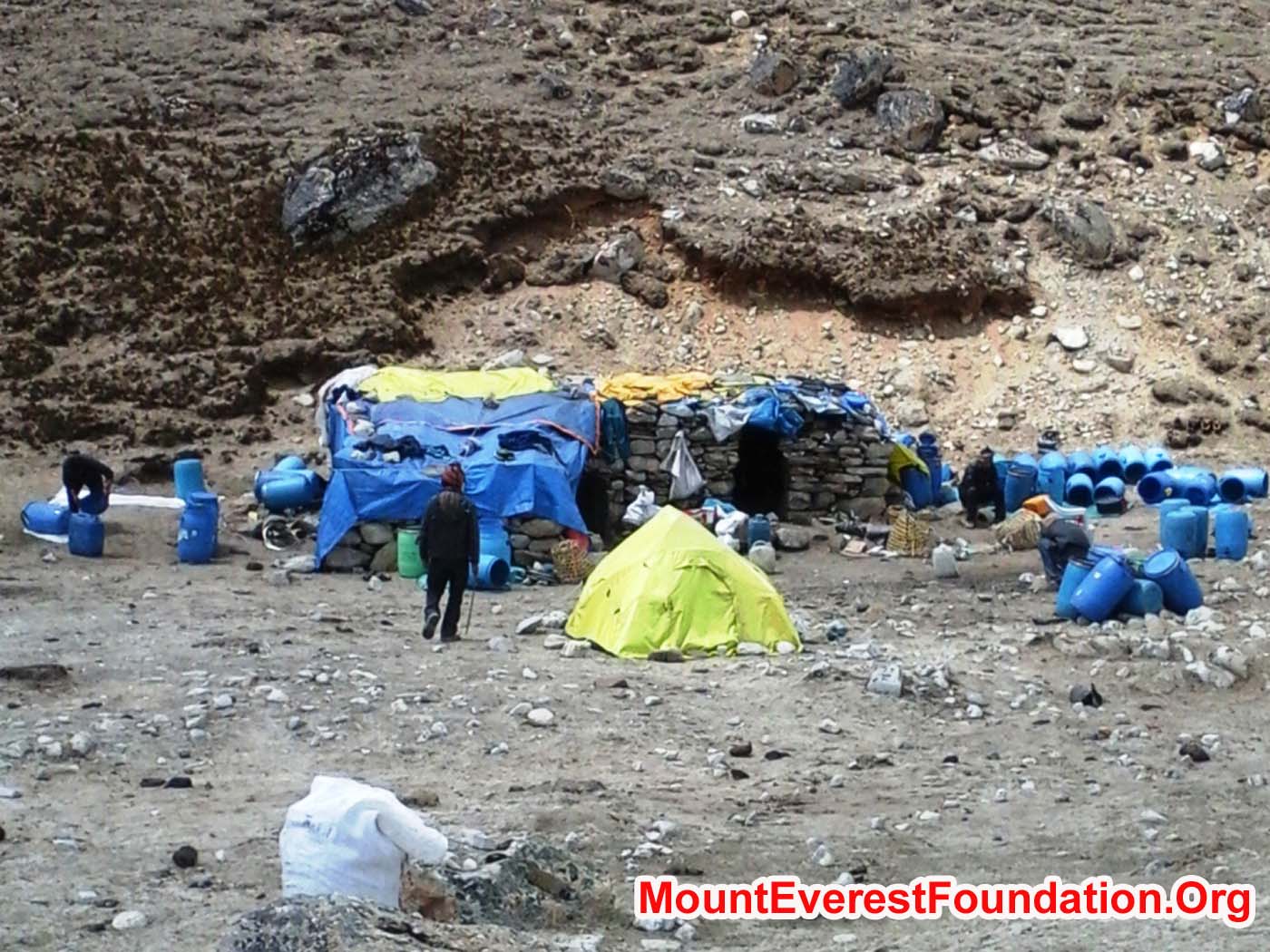
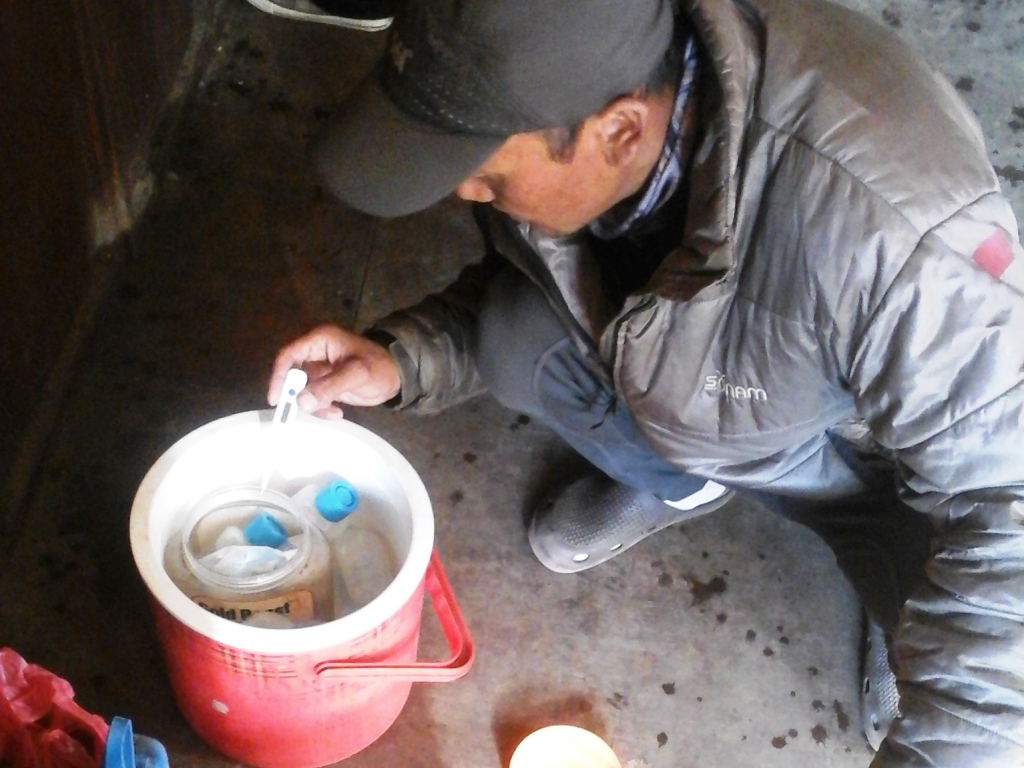
Team of workers at Gorak Shep washes out the Everest basecamp human waste drums so they can be reused. Thile Nuru Sherpa prepares the petri dishes for incubation.
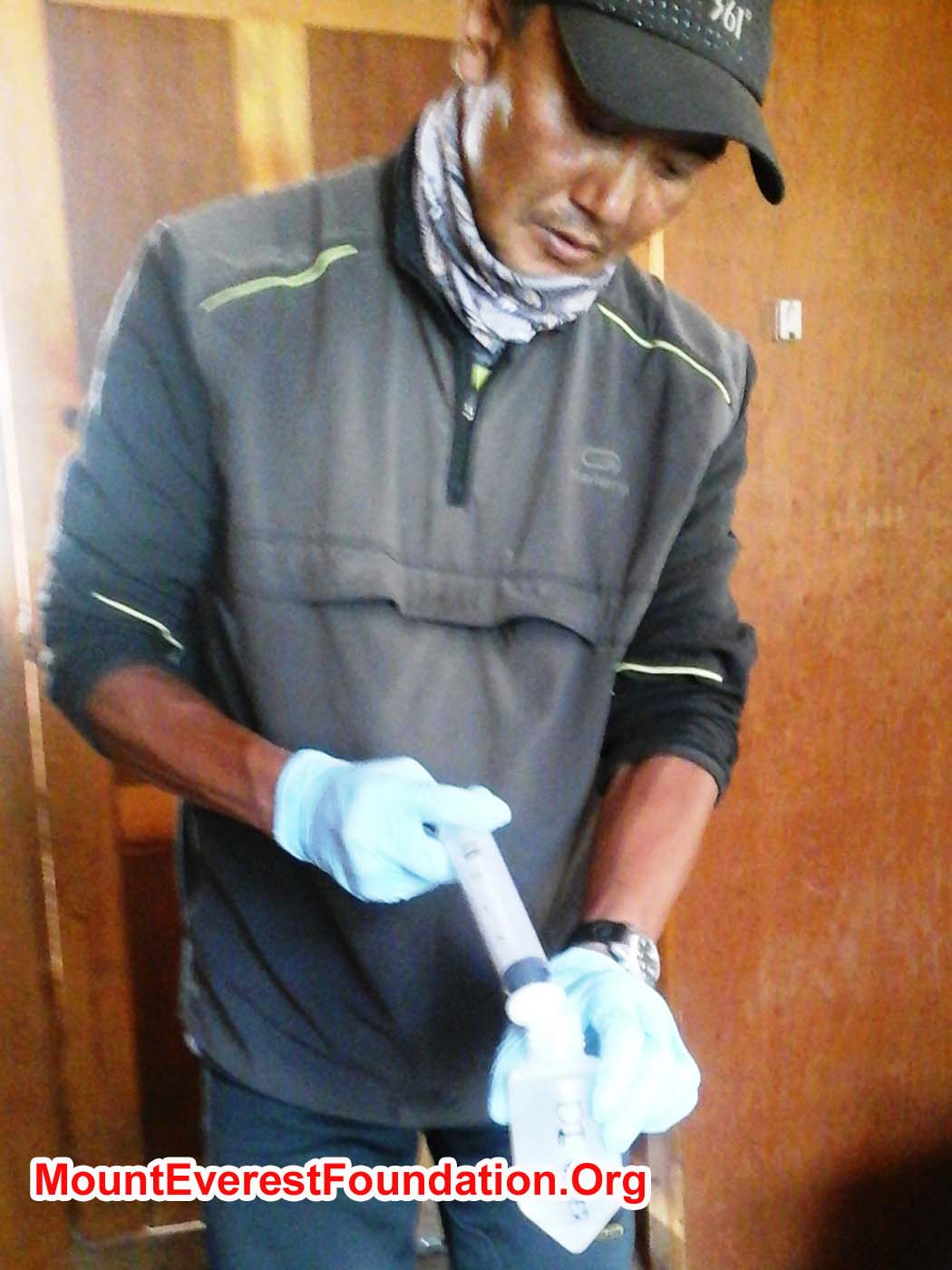
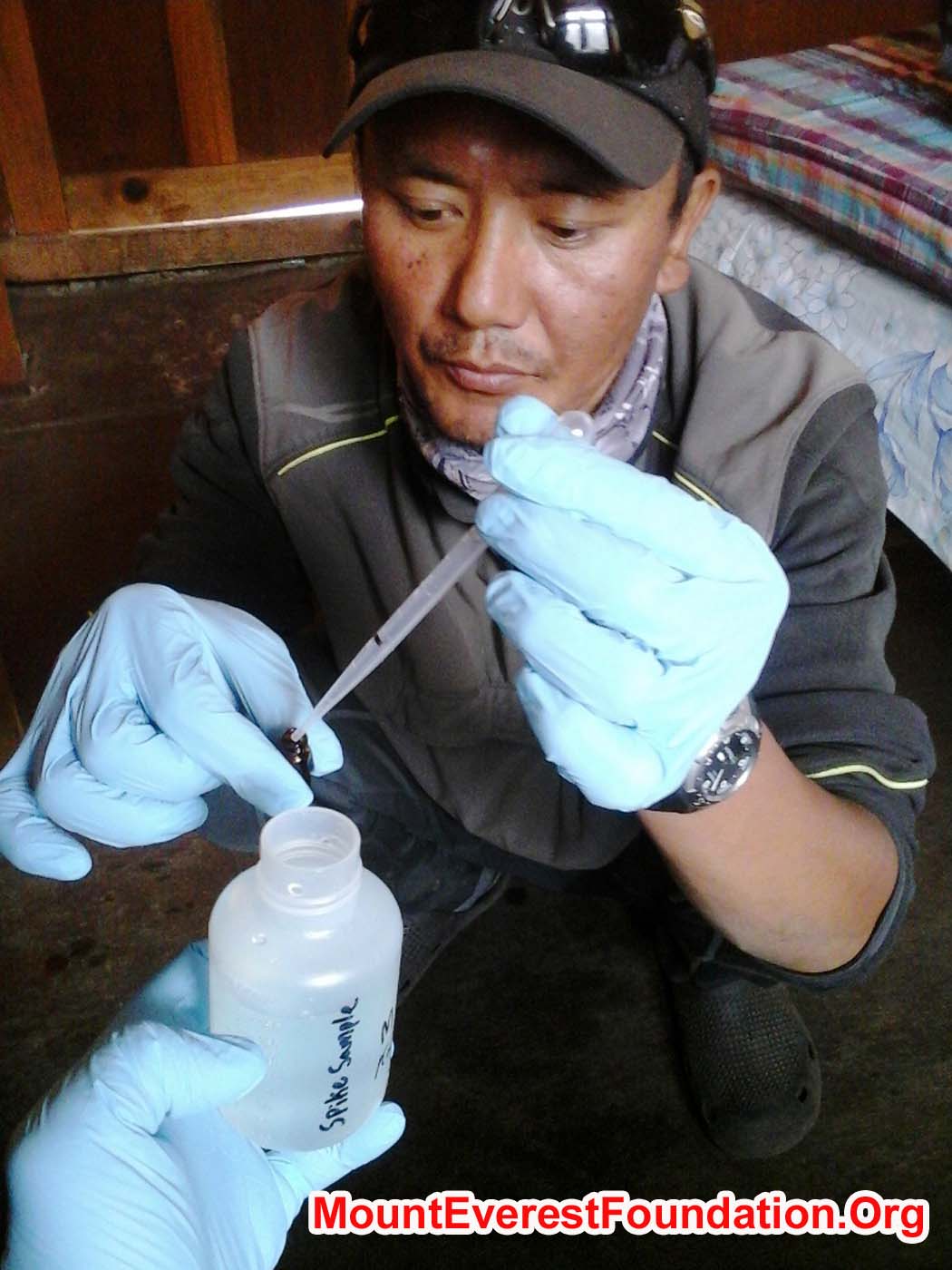
Thile Nuru Sherpa filters water into a sample bottle. Thile Nuru Sherpa spikes a water sample.
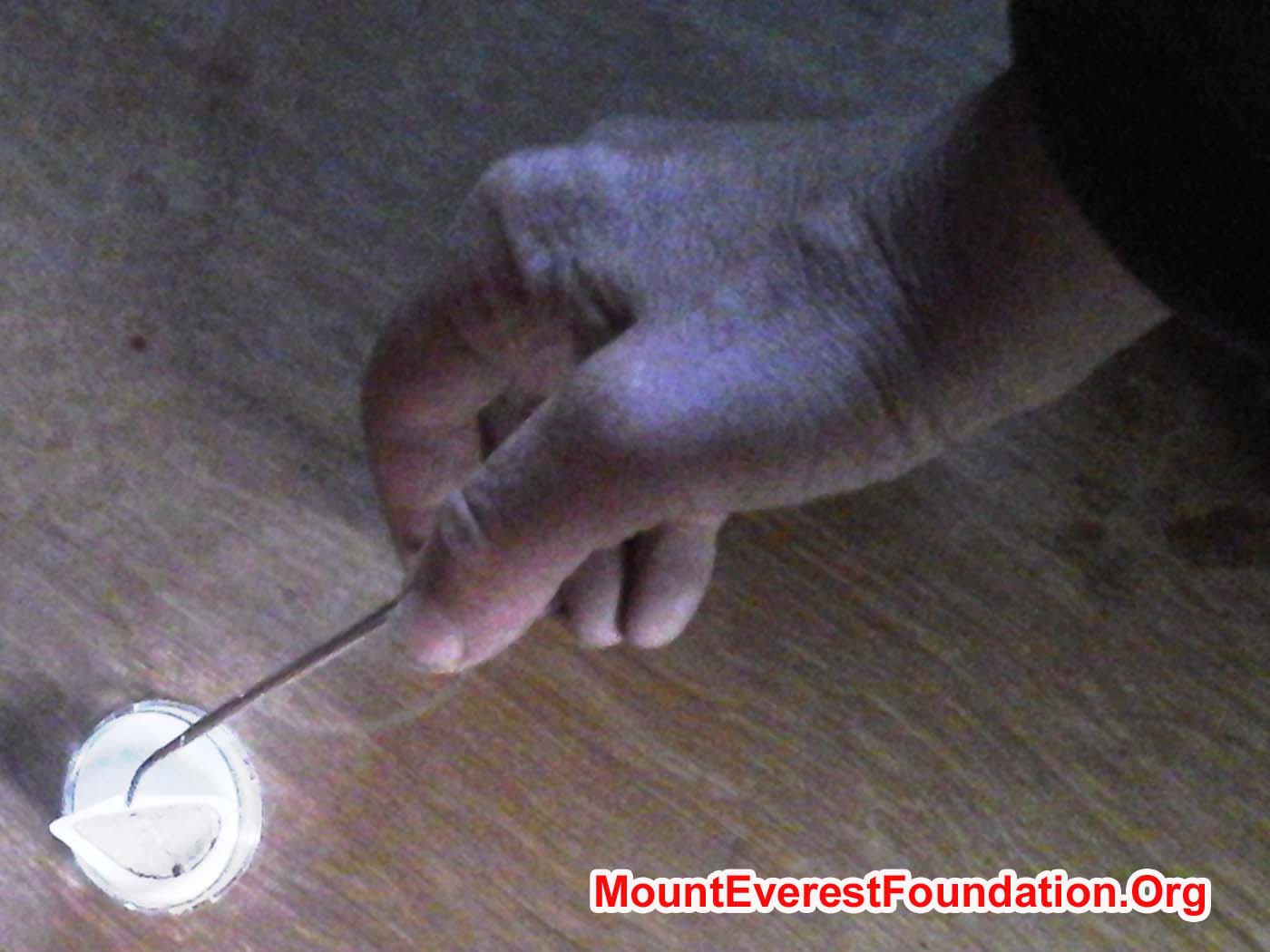
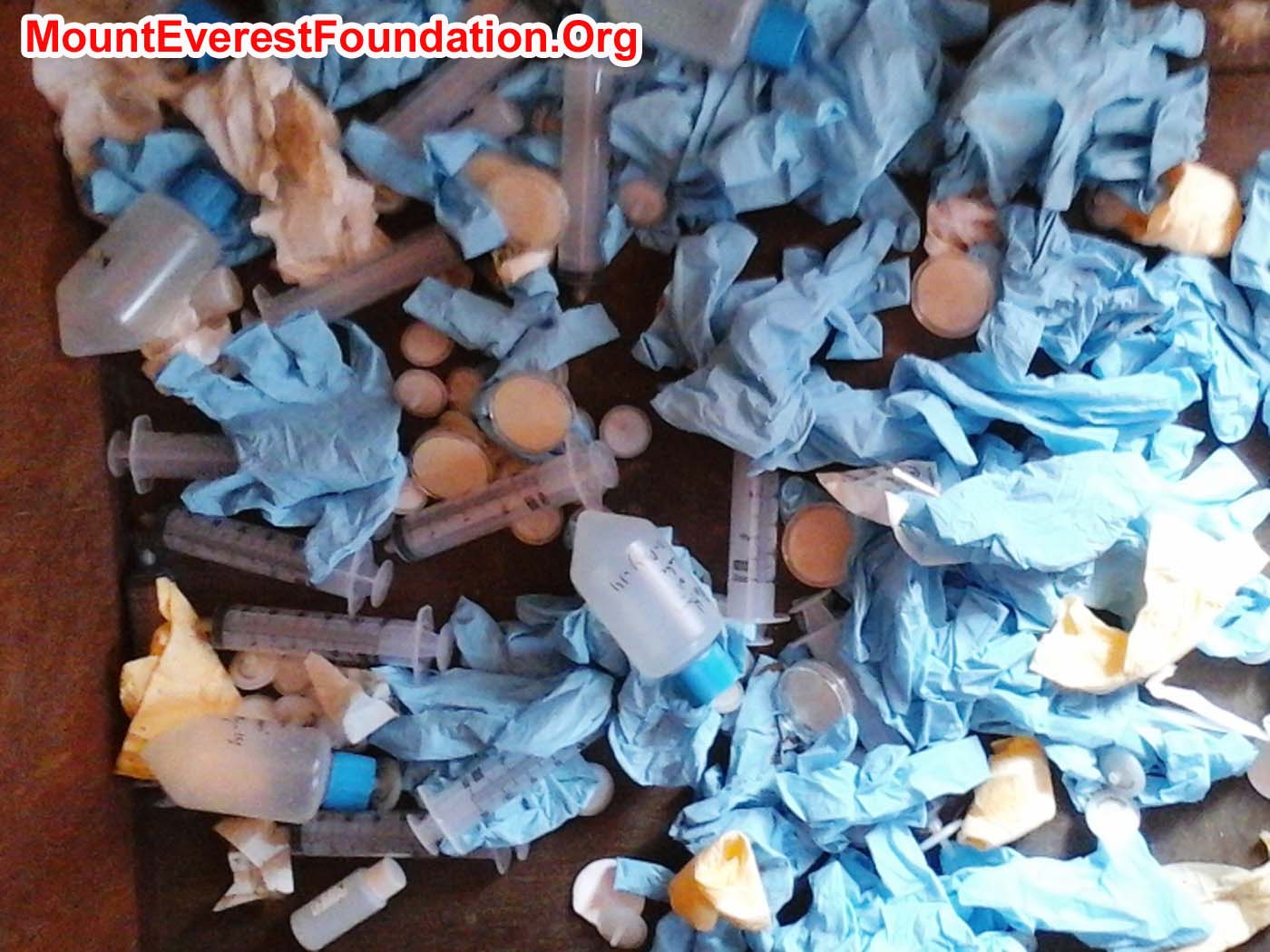
Tweezing the innoculation grid into the petri dish. Waste created by the water sampling project.
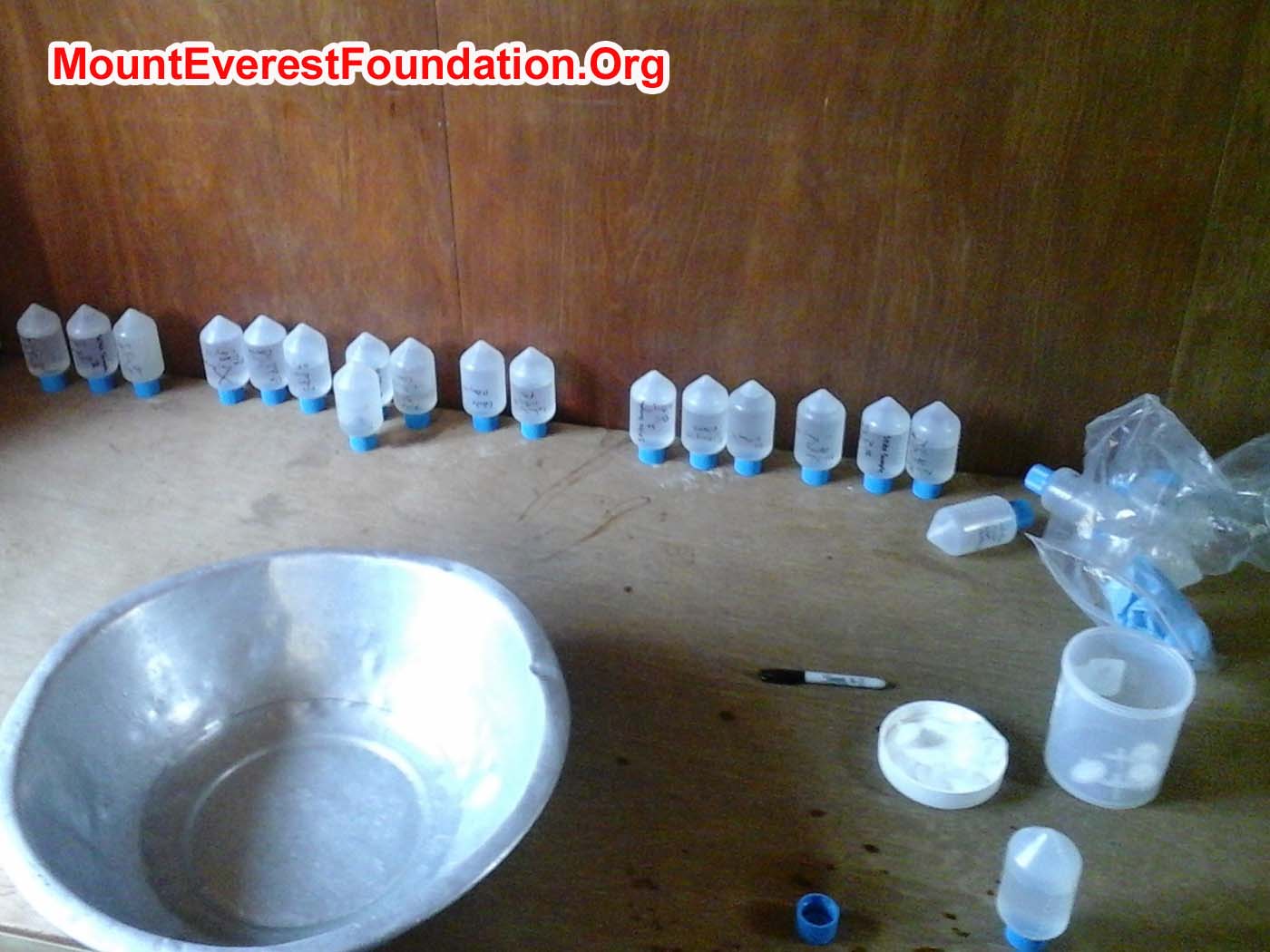
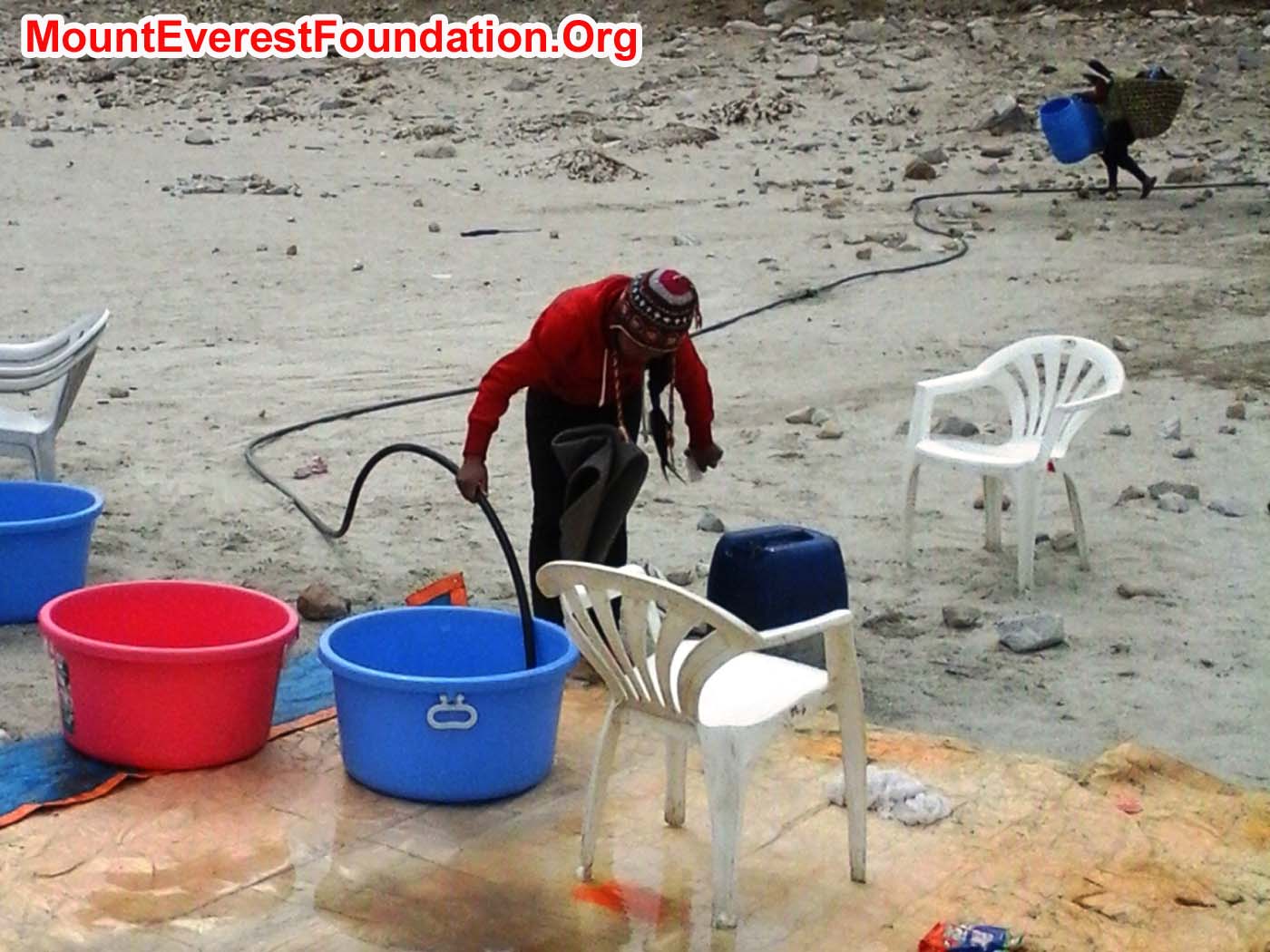
Water sampling workbench. Worker fills jugs at the carpet washing station in Gorak Shep using the pipeline from Pumori. Another worker carries a basket of laundry and a water drum in the background.
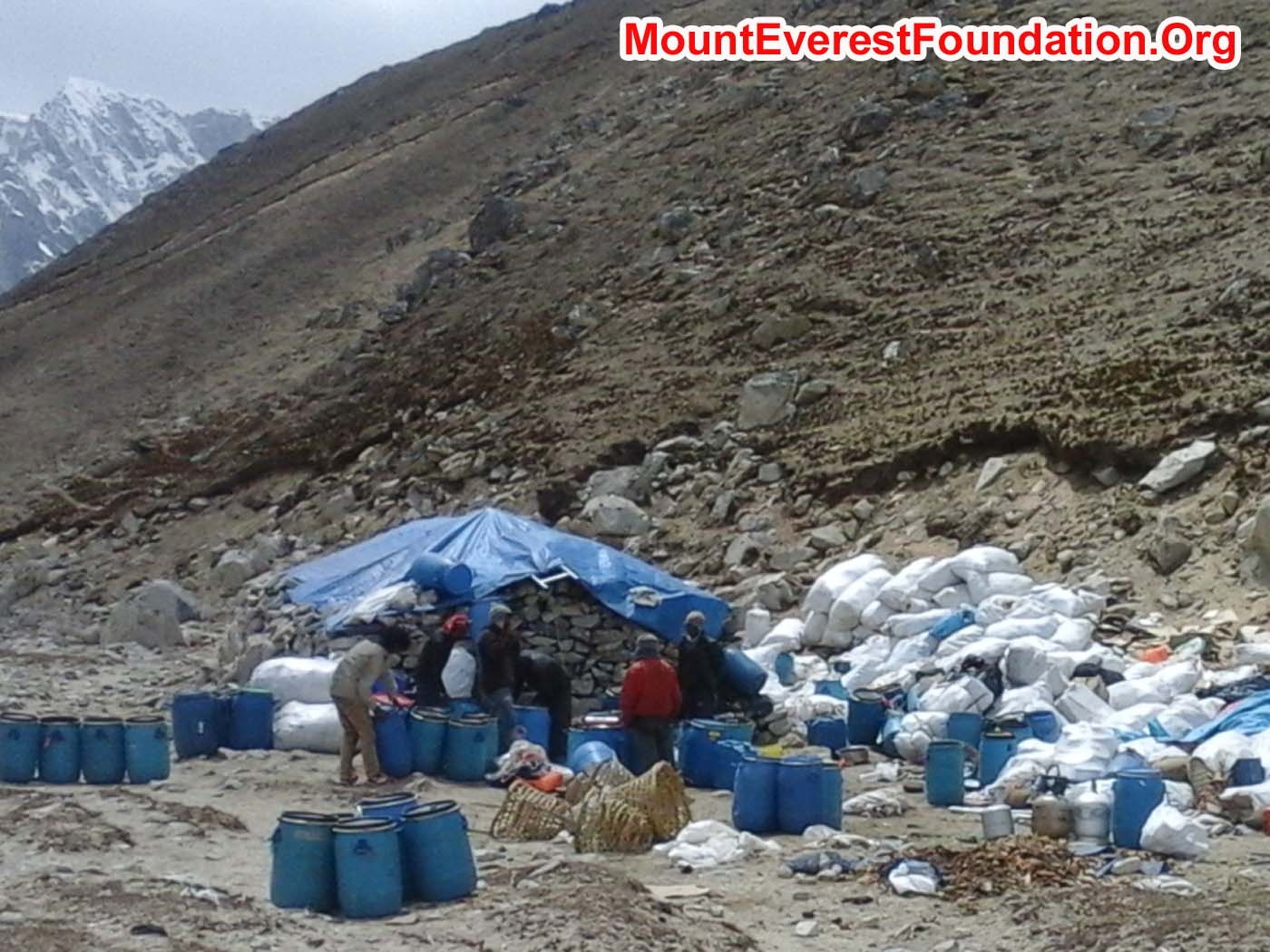
Workers at Gorak Shep sorting out tins, bottles, paper and plastic from Everest basecamp. Kala Pattar and Mount Lobuche in the background.
Justin P. Miller-Schulze, Ph.D. January
- Sample Collection
- Samples (~200 ml) were collected in early November
- Samples were syringe-filtered through 0.45 µm filters
- Samples were frozen for some (but not all) of the period between collection and analysis (~1 month)
- These sample collection and storage procedures are a departure from standard protocols
- As such, data should be viewed as qualitative
- The table to the right details the Contaminants of Emerging Concern (CECs) that we analyzed the samples that were collected at the 4 Everest Base Camp sites in late October/Early November
- These CECs are a suite of compounds that we chose to investigate impacts of human wastewater (and a few other things) on water quality. The list is not exhaustive, but our data at this stage indicates that data on these compounds can give insight on relevant sources of impacts on water quality.
CEC
Use/Application
Acetaminophen
Pain Reliever (Tylenol)
Atrazine
Herbicide
Caffeine
Stimulant
Carbamazepine
Anti-Seizure Medication
Cotinine
Nicotine Metabolite
Ethyl Paraben
Anti Microbial
Ethyl Vanillin
Articifical Flavoring
Ibuprofen
Anti-Inflammatory
Methyl Paraben
Anti Microbial
Mecoprop
Herbicide
Nicotine
Stimulant
Paraxanthine
Caffeine Metabolite
Ensulizole
UV Filter (Sunscreen Agent)
Propylparaben
Anti Microbial
Ractopamine
Feed Additive (Swine)
Sulfadimethoxine
Antibiotic (animal)
Sulfamethoxazole
Antibiotic (human)
Sulfamethazine
Antibiotic(animal)
Sucralose
Artificial Sweetener
Theobromine
Caffeine Metabolite/Chocolate Ingredient
The table to the right details what percentage of the 19 CECs were found at levels above our method Limit of Detection (LOD) in each sample. The method LOD is a measure of the contamination from our lab and the sample collection. back to top
Table 1: % of CECs detected in each sample
Site
% of CECs Above LOD
Everest Head of Lake
0
Everest Bottom of Lake
21
Everest Lobuche Reservior
47
Everest Debouche AVG
5
Sampler Notes:
Head of Lake at Gorak Shep, closer to the old human waste pits, but looked less contaminated (but it's the same lake).
Summary/Conclusions
- All data comes with the caveat of single samples (no replicates) and long transport times in possibly un-refrigerated conditions
- For obtaining preliminary data, this is fine
- If more definitive information is desired, we would want to do some more representative stability studies and obtain more replicates at each site
That said, the single field blank collected did not show excessively higher contamination as compared with our lab blanks (which is good)
Summary/Conclusions
- Seems to be clear human impacts in Bottom of Lake and Lobuche samples
- The acetaminophen, ibuprofen, caffeine, paraxanthine, and nicotine levels are the biggest indicators for these sites
- Some of the CEC concentrations at these sites approach or exceed the concentrations observed at sites in the Puget Sound Region with septic influence (acetaminophen, ibuprofen)
Interesting that ensulizole (sunscreen agent) was detected, at relatively high levels, at 3 of the 4 sites
–For example, at our dock, we haven’t seen concentrations >5 ng/L over the past year
Summary/Conclusions
- There are some interesting absences for these samples, also:
- Sucralose and caffeine are relatively ubiquitous in the Thea Foss waterway, but are not seen in the majority of the Everest samples.
- Sucralose, in particular, is quite stable as far as we know, and so degradation during transit is not anticipated back to top
Everest Base Camp Data
For all plots:
- A lack of colored bar indicates the measured concentration was below the method Limit of Detection
- The error bars represent the analytical uncertainty associated with that value
- Concentrations are in ng/L, or parts-per-trillion. For comparison, a standard cup of coffee (~250 ml) has 200 mg of caffeine in it, which would be 800 million ng/L
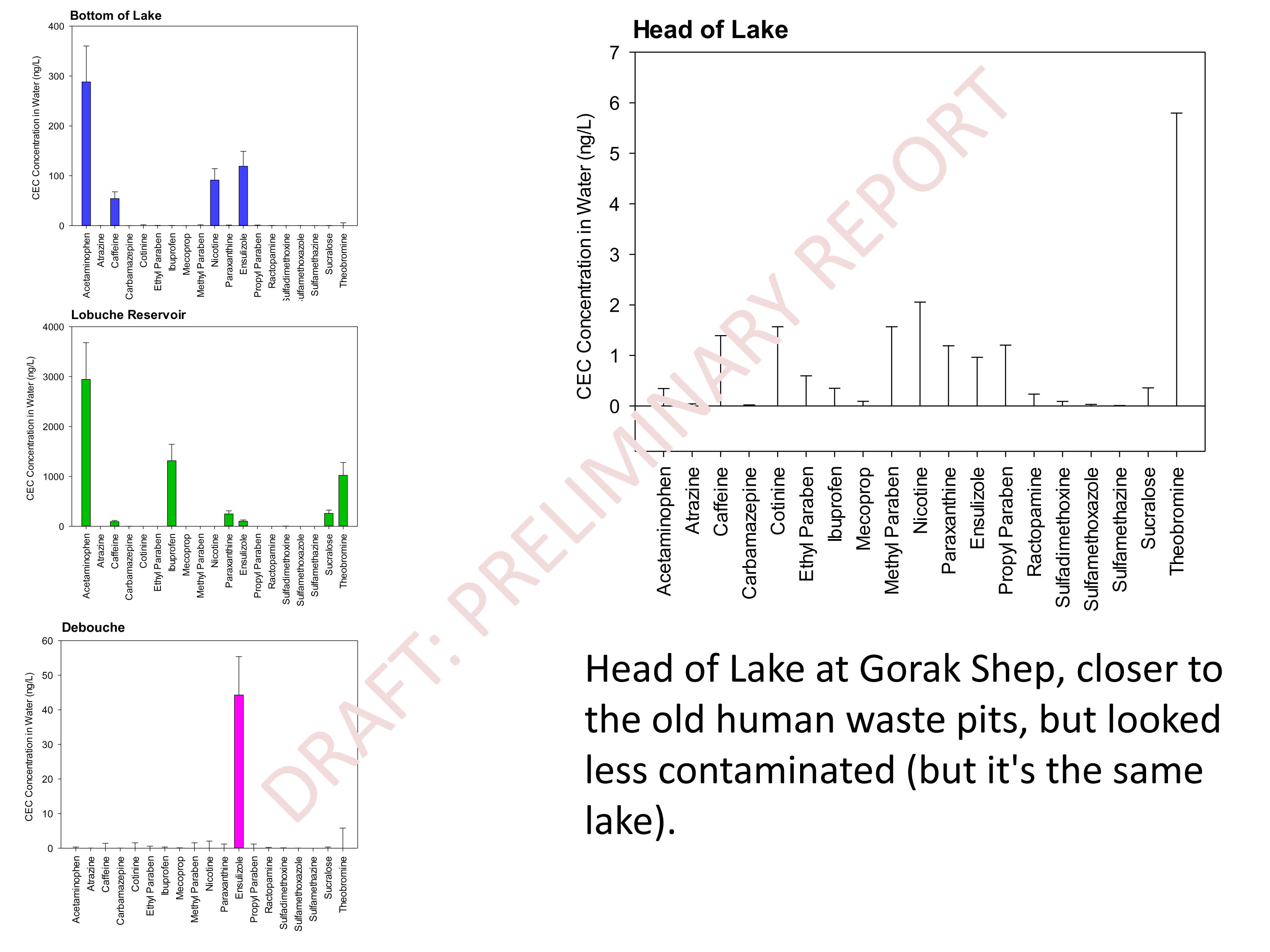
Summary/Conclusions
- All data comes with the caveat of single samples (no replicates) and long transport times in possibly un-refrigerated conditions
- –For obtaining preliminary data, this is fine
- –If more definitive information is desired, we would want to do some more representative stability studies and obtain more replicates at each site
- That said, the single field blank collected did not show excessively higher contamination as compared with our lab blanks (which is good)
Summary/Conclusions
- Seems to be clear human impacts in Bottom of Lake and Lobuche samples
- –The acetaminophen, ibuprofen, caffeine, paraxanthine, and nicotine levels are the biggest indicators for these sites
- –Some of the CEC concentrations at these sites approach or exceed the concentrations observed at sites in Kitsap County with confirmed septic influence (acetaminophen, ibuprofen)
- Interesting that ensulizole (sunscreen agent) was detected, at relatively high levels, at 3 of the 4 sites
- –For example, at our dock, we haven’t seen concentrations >5 ng/L over the past year back to top
Summary/Conclusions
- There are some interesting absences for these samples, also:
- –Sucralose and caffeine are relatively ubiquitous in the Thea Foss waterway, but are not seen in the majority of the Everest samples.
- –Sucralose, in particular, is quite stable as far as we know, and so degradation during transit is not anticipated
Mount Everest Water Sampling Project. Chemicals of Emerging Concern. 6 November,
Today Tenji Sherpa and Dan Mazur, advised by Garry Porter, all under the supervision of Dr. Justin P. Miller-Schulze, Ph.D, conducted water sampling in and around the villages of Gorak Shep and Lobuche, in the shadow of Mount Everest, in order to identify Chemicals of Emerging Concern as tracers of water quality.
The purpose of this sampling is to collect water samples at locations around the Everest Base Camp that will be analyzed for a set of Chemicals of Emerging Concern, such as caffeine, nicotine, ibuprofen, etc. These non-toxic chemicals will be used to assess human impact on drinking water sources at the Base Camp.
Because these chemicals are present in the human diet (caffeine in
coffee/tea) and everyday activities (ibuprofen for pain relief, nicotine in cigarettes, etc.) it is critical that samples are collected using methods to prevent sample contamination.
This water sampling is a joint venture between the following organisations:
1. Engineers Without Borders;
2. Centre for Urban Waters;
3. University of Washington;
4. Mount Everest Foundation for Sustainable Development;
5. SummitClimb;
6. SummitTrek.
Thank you very much. back to top
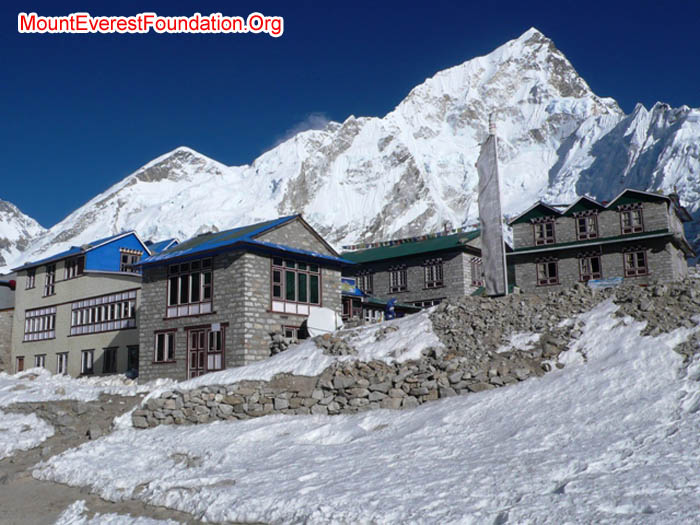
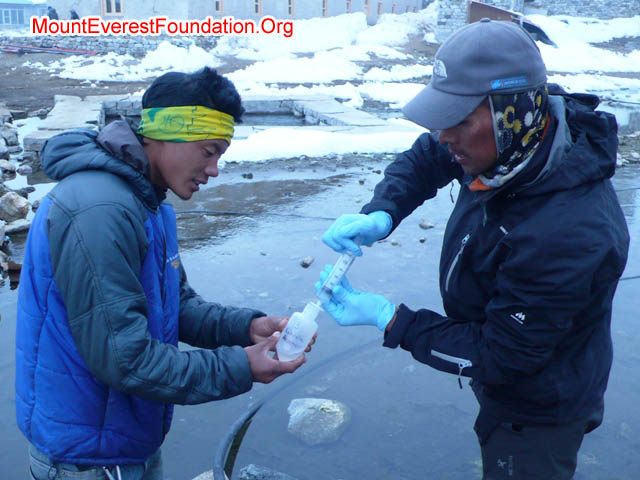
Gorak Shep on a snowy sunny day in November. In background are Cholatse, West Ridge of Everest, Everest Summit, and Nuptse. Mila Rai and Tenji Sherpa sampling water at the reservoir in Lobuche Village, below Gorak Shep.
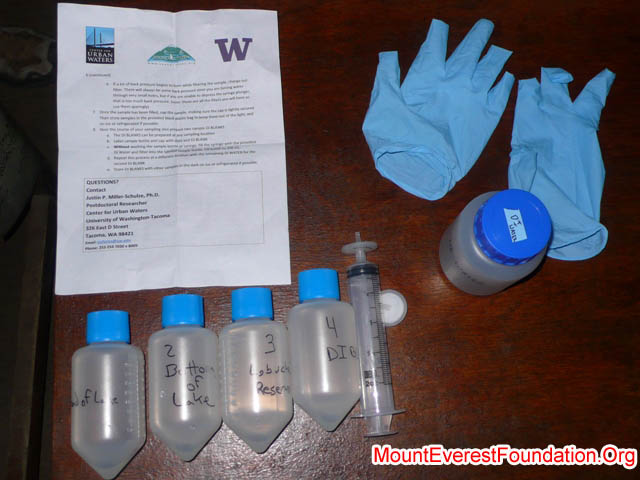
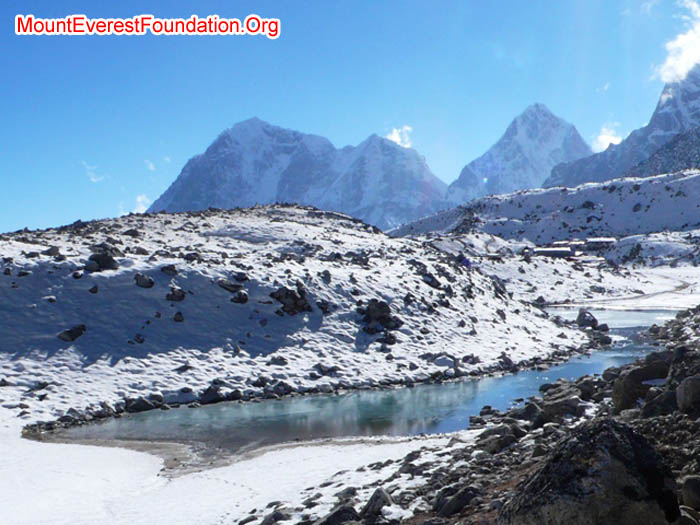
Water sampling instruction sheet, water samples, and equipment on the table at the lodge in Lobuche. Lake at Gorak Shep. This is the current water source as other sources are frozen at the moment. Buildings of Gorak Shep, Tawoche, Cholatse, and Lobuche in the background. back to top
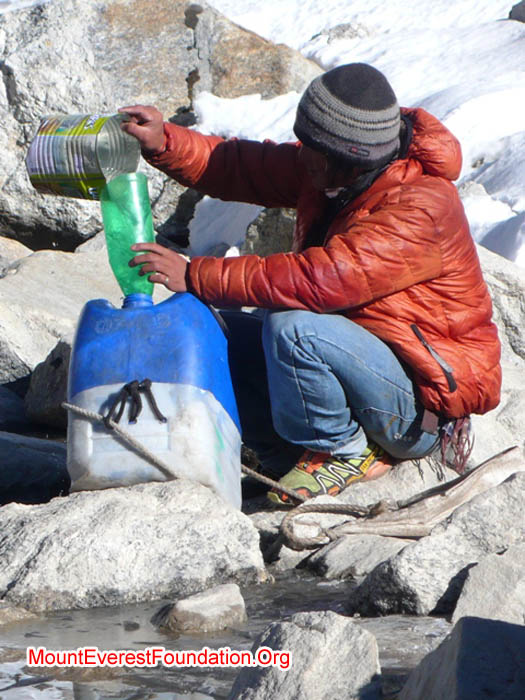
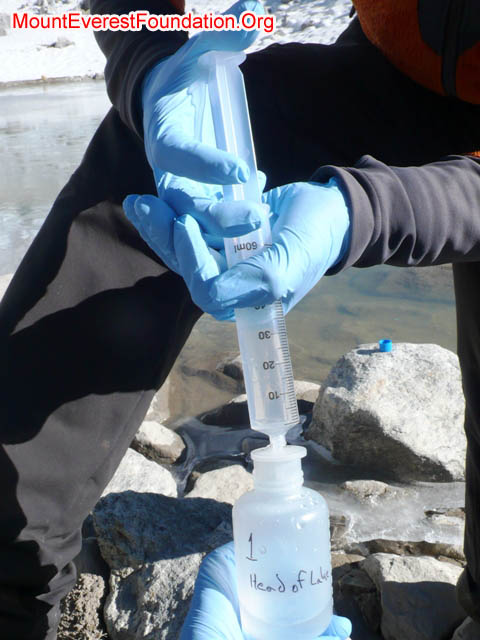
Gorak Shep worker filling water container at the lake. Cigarette butts and other rubbish litter the water and the bank here. We took a water sample from this exact spot. Close up of the water sampling gear in action - gloves, syringe, filter, bottle. back to top
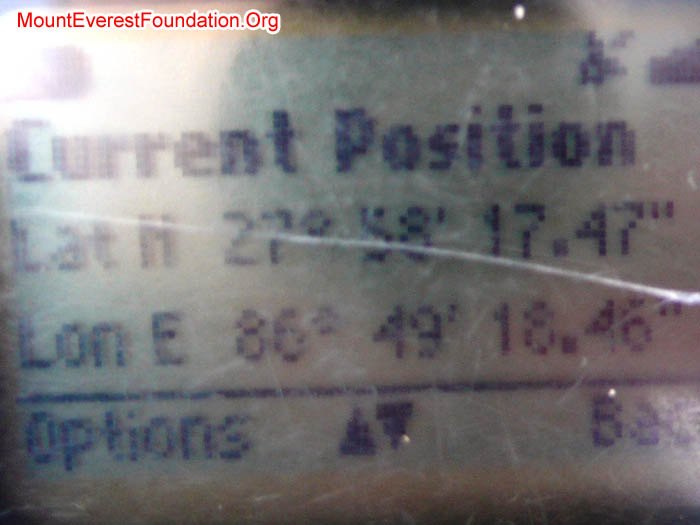
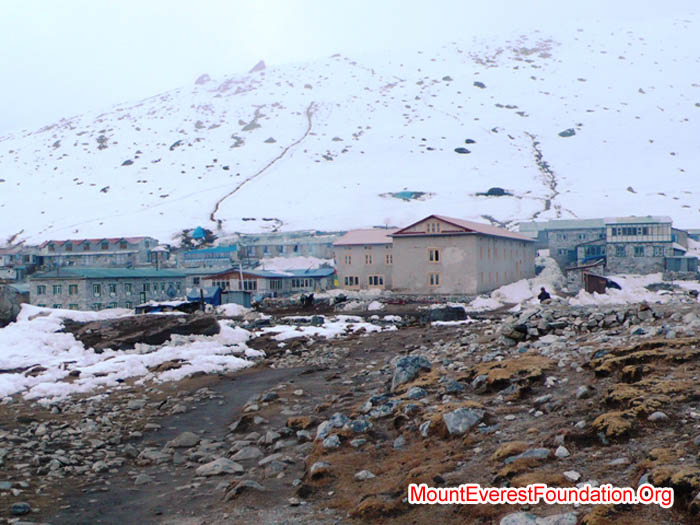
GPS position of Kyakpa Yul, where the newest waste pits are located. Lobuche Village is located below Gorak Shep. Lobuche is more busy than Gorak Shep.
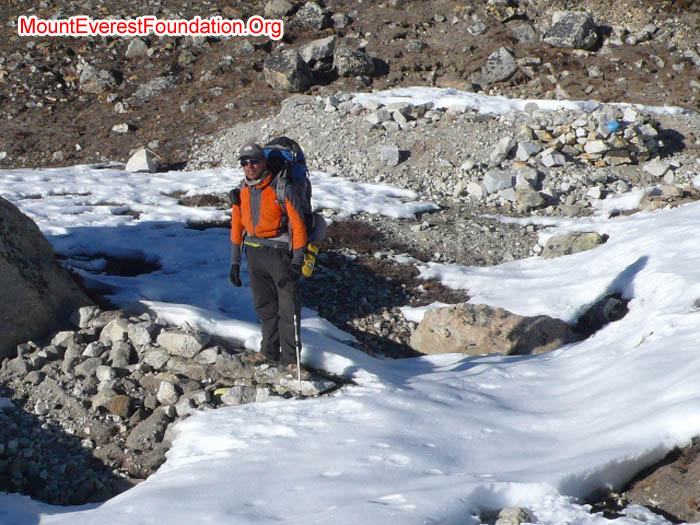
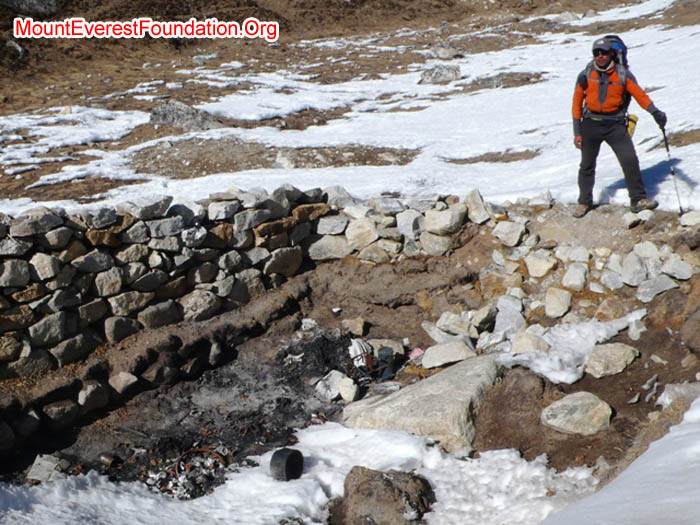
Tanji Sherpa standing in the Kyakpa Yul, surrounded by the newest waste deposit from Everest base camp. Tenji Sherpa standing in front of pit for burning rubbish in Gorak Shep. back to top
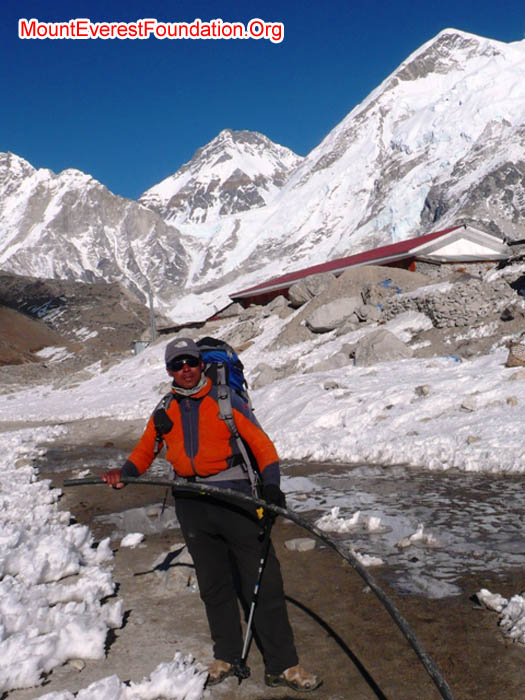
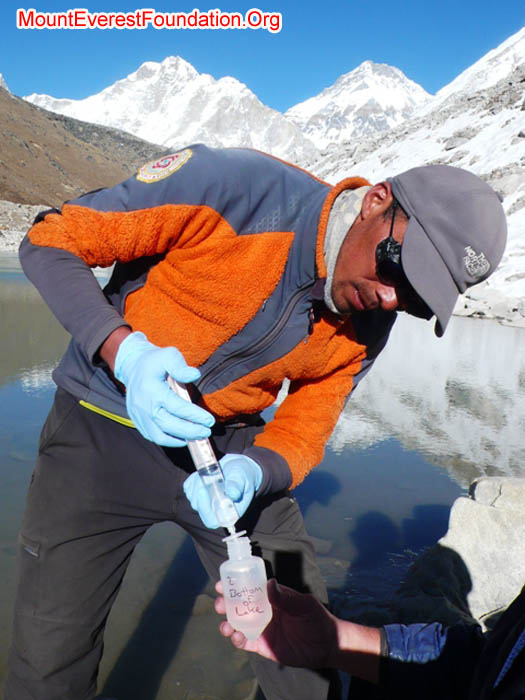
Tenji Sherpa holds frozen water pipe in Gorak Shep. In warmer temps, it would be flowing with water from a lake near Pumori. Background - Khumbutse, Cholatse & Everest West Ridge. Tenji Sherpa taking a water sample at the location where the Gorak Shep people fill their water jugs. Mounts Khumbutse and Changtse in background.
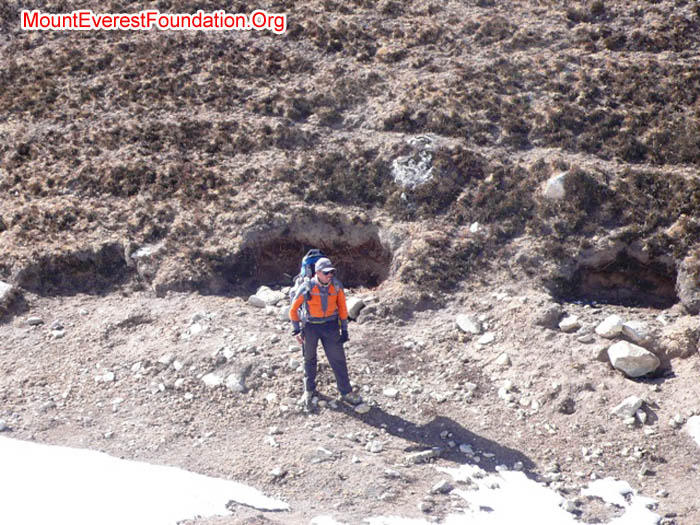
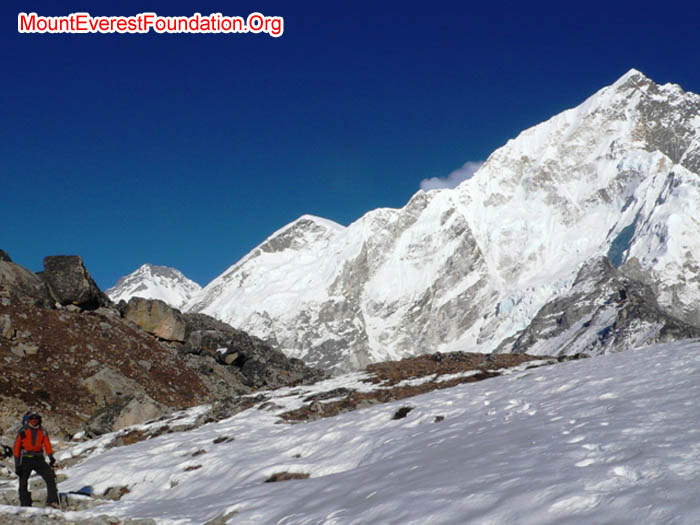
Tenji Sherpa standing in front of the old waste disposal pit at the head of the Gorak Shep Valley. Tenji Sherpa standing in Kyakpa Yul, where the newest waste pits are located. In background are Changtse, Everest, and Nuptse. back to top
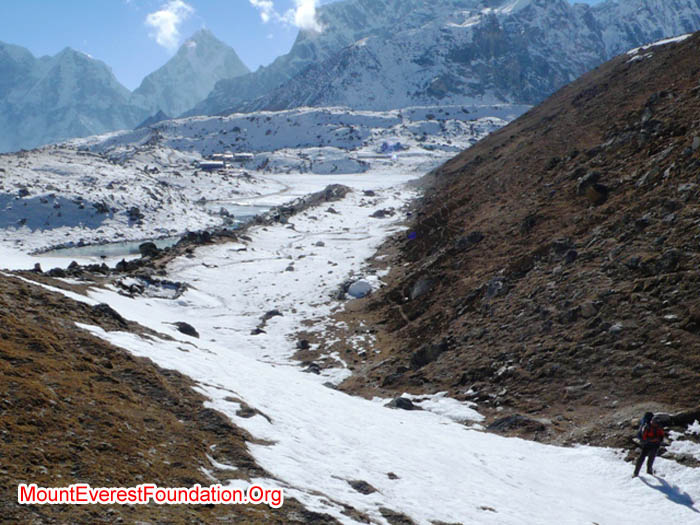
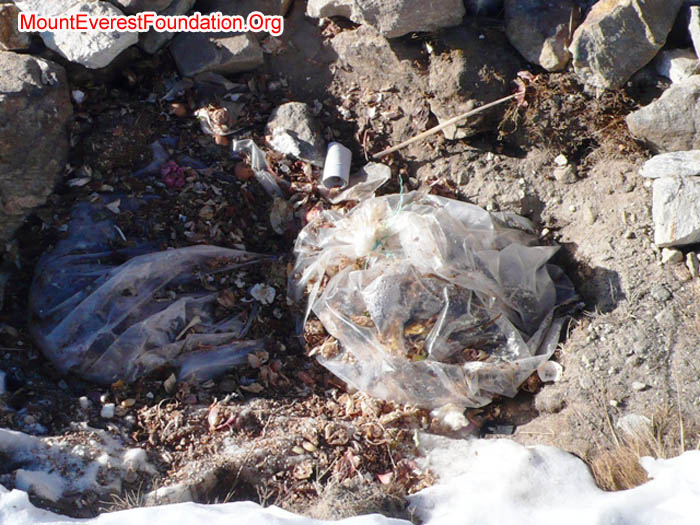
Tenji Sherpa standing in lower right. Here waste was buried in the ground and waste is still sorted and burned here. In the background - Gorak Shep, Tawoche, Cholatse and Lobuche.
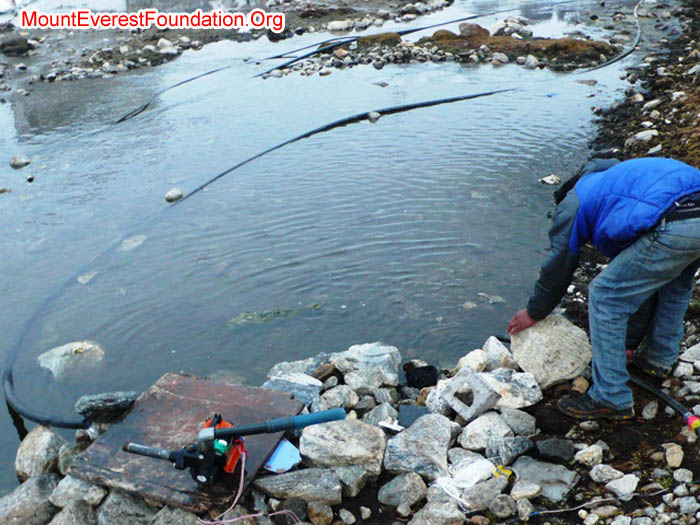

Worker seting up an electric water pump for teahouses in Lobuche Village, below Gorak Shep. back to top
National Geographic Article From 13 May: Mt. Everest Biogas
On Mount Everest, Seeking Biogas Energy in a Mountain of Waste by Will Ferguson for National Geographic News.
Nestled in the shadow of the world's tallest mountain, the tiny village of Gorak Shep has a very messy problem.
The Sherpa community literally is running out of space to put human feces from the Everest, Pomori, Lhoste, and Nupste base camps. Each year, porters haul more than 12 metric tons of excrement down the mountains and dump it into open pits at Gorak Shep. A spring National Science Foundation (NSF) survey found contamination of one of the two major sources that supply water at Gorak Shep.
A volunteer group of Seattle-based engineers is working on an innovative solution to the problem, one that also will provide a big energy benefit. Earlier this month, they completed a design for a biogas reactor to convert climbers' feces into methane gas to serve as a cooking fuel for the Sherpa villagers. Construction could begin as early as next year. If it is a success, the Mount Everest Biogas Project will be the world's highest-elevation biogas reactor and proof-of-concept for an invaluable tool to protect iconic high-mountain ecosystems.
A Better Tribute
The genesis of the idea was a realization that Seattle climber Garry Porter had shortly after his attempt to summit Everest a decade ago. Porter's small expedition made it to Everest's South Summit, only 120 meters beneath the true summit, before being forced down the mountain due to high wind conditions. back to top
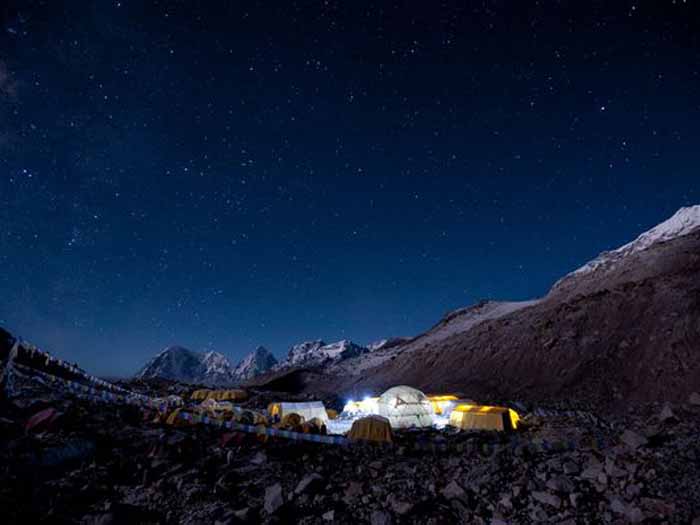
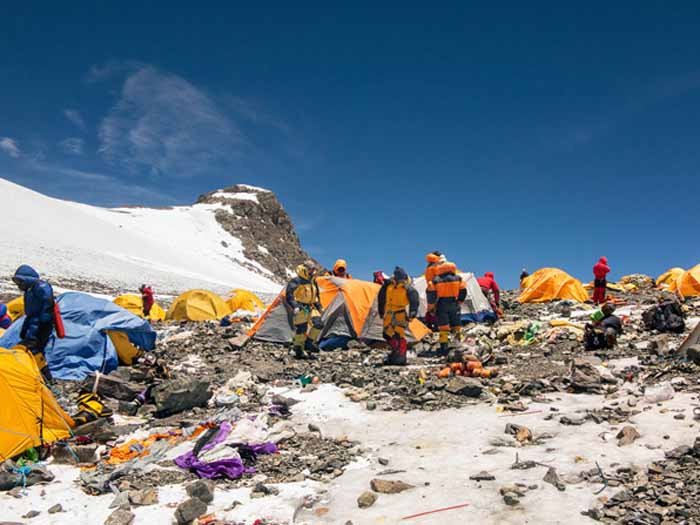
A climber from Seattle, disturbed by the amount of waste he saw being generated at Everest base camp (seen here at night), helped start the Mount Everest Biogas Project to turn that waste into energy. Below, porters carry waste away from base camp. Photograph by Alex Treadway, National Geographic. Years of garbage clutters Camp IV, left behind by the 4,000 or so climbers who’ve passed through over the past 60 years. Although efforts to control pollution and haul out refuse have seen success at Base Camp, abandoned tents, food waste, empty oxygen bottles, and other types of junk continue piling up at higher elevations. Camp IV is at 26,000 feet. Photograph by Mark Jenkins
Upon returning to Mount Everest base camp, he watched a steady procession head down the mountain to the village of Gorak Shep below. "I remember seeing a group of Sherpa men carrying these blue barrels of human feces to dump at Gorak Shep," Porter says. "I couldn't shake the feeling that my final tribute to Nepal and the people of Everest was having my waste dumped in these open pits. It just didn't seem right."
Gorak Shep serves as a launching pad and acclimatization stop for many trekkers. But there are no electrical, sanitation, or water-supply systems.
Porter, an engineer who spent 34 years at the Boeing Company before his retirement, contacted his friend and Everest guide Dan Mazur and they agreed to tackle this issue together. Mazur, an organizer for the Mount Everest Foundation for Sustainable Development in Nepal, had previously worked with lowland farmers who used biogas digesters to convert animal dung to methane gas. He suggested a similar system could work at Gorak Shep. back to top
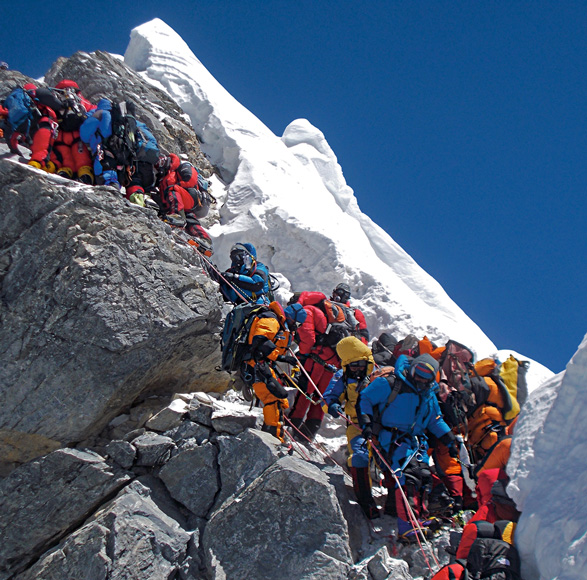
Traffic chokes the Hillary Step on May 19, Some climbers spent as long as two hours at this 40-foot rock wall below the summit, losing body heat. Even so, 234 people reached the top on this day. Photograph by Subin Thakuri
In biogas production, bacteria feed on organic waste (like feces) and produce several gases as a byproduct. One of these is methane, which is the primary component of natural gas and can be burned for heat and light, or converted to electricity. One cubic meter of biogas provides about two kilowatt-hours of useable energy. This is enough to power a 60-watt light bulb for more than a day, or an efficient 15-watt CFL bulb for nearly six days. A biogas reactor at Gorak Shep could address the fecal contamination problem while providing the perennially low-income community with a sustainable source of methane gas for energy, especially for cooking, Porter says
But the harsh conditions of Mount Everest, which have challenged so many climbers, tested the skills of the engineers. back to top
For starters, air and ground temperatures are below freezing most of the year at Gorak Shep, which sits at an altitude of 5,164 meters (16,942 feet) and briefly served as the first Everest base camp in 1952. Biogas production stops entirely when the temperature hits freezing, says Robert Spurrell, former director of research and development at the Weyerhaeuser Company, who is serving as technical manager for the Everest biogas project. Normally, recirculating water heated by methane gas inside a reactor offsets cold outside temperatures.
However, because the biogas reactor at Gorak Shep will run exclusively on human fecal matter-a poor methane—producing fuel source—this won't be possible. Spurrell explains that organic waste can be divided into two groups: carbon-rich or nitrogen-rich. Animal waste contains a lot of carbon cellulose which gives it a high carbon-to-nitrogen ratio, around 20:1. This promotes methane production. Human waste on the other hand has a low carbon to nitrogen ratio, around 6:1. This makes it a poorer quality fuel source.
"In essence, if we use the methane gas in our system to heat the recirculating water, the energy production will be too low to provide cooking fuel to the villagers," Spurrell says.
To make things even more difficult, all building materials have to make a five-day, rugged journey to the village via pack animal or strapped to a human's back. "It's not like we can go to Lowe's or Home Depot," Spurrell says. "We definitely chose the hardest place on Earth to do this."
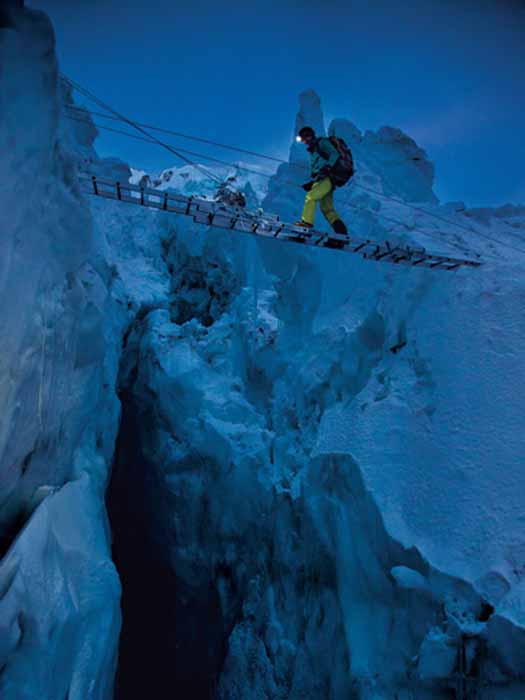
Team member Hilaree O’Neill steps across a bridge of aluminum ladders lashed together above a crevasse in the Khumbu Icefall. Considered one of the most unpredictable hazards on Everest, the icefall is an ever shifting labyrinth of loose, jagged blocks. Photograph by Andy Bardon
The engineering team arrived at a renewable energy solution to the temperature problem. Porter says they will use nine or ten off-the-shelf, 0.8-by-1.2-meter solar panels to heat a large tank of water inside a storage building, built over the underground biogas reactor. A heating coil, running from the water tank to the digester's interior, will provide enough energy to keep temperatures inside the digester around 86°F (30°C). Porter says the 8-cubic-meter digester system, including the storage building and solar panels, will cost approximately $15,000 to $20,000. It could process 16 metric tons of human waste per year, more than the current annual climber load hauled down to Gorak Shep. That amount of waste would produce more than 1,000 cubic meters (35,000 cubic feet) of biogas. That may not seem like an enormous amount of fuel; the average U.S. home that heats with natural gas uses about double that amount in a single winter. But it's an amount that can go a long way in Gorak Shep to serve as a much-needed sustainable alternative fuel for cooking. back to top
Saving Native Vegetation
Sherpa communities in Nepal and alpine conservationists think the Mount Everest Biogas Project could not only solve the fecal contamination problem but also has potential as an alternative to burning fossil fuels and Everest's native plant species. Mingma Tenjing Sherpa, a lifelong resident of Nepal's Khumbu Valley and the project's liaison with the Sherpa community, says an increasing number of foreign visitors are creating an insatiable demand for cooking fuel, campfires, and hot water. This in turn is leading to the overharvesting of Everest's natural resources.
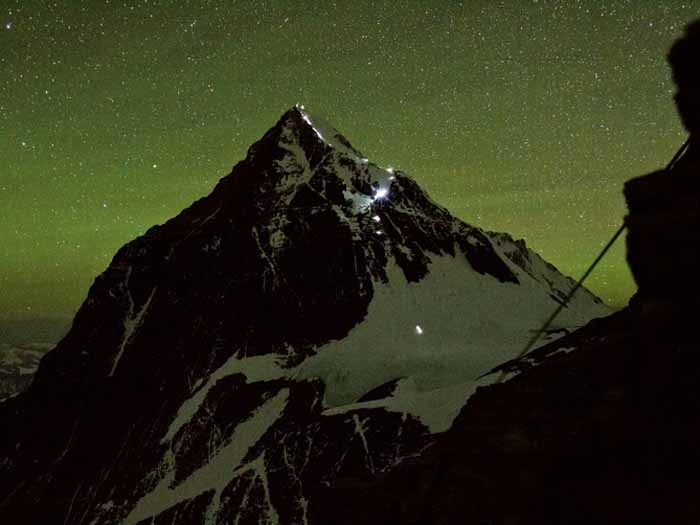
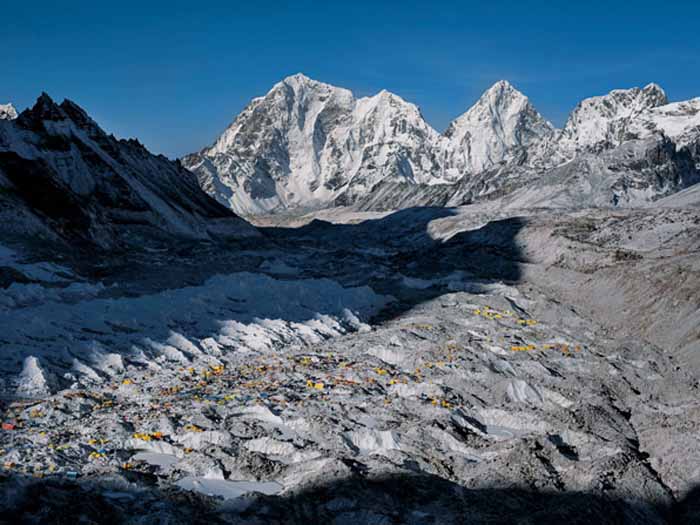
Headlamps trace a path to the summit a few hours before dawn. Without tighter safety rules, climbers will continue to face more hazards on the mountain than altitude and the elements. “The most dangerous thing about Everest,” said one guide, “is everyone else who’s trying to climb it.” Photograph by Kristoffer Erickson. Hundreds of climbers converge at Base Camp on the Nepali side of Everest. The crowded, colorful temporary village offers up hot bucket showers, Internet access, and fresh baked goods. Photograph by Anjin Herndon.
Chief among these is the endangered alpine juniper, a bedrock plant species of high-alpine ecosystems like Sagarmatha National Park where Everest is located. Alpine junipers supply habitat and food for species endemic to the region and prevent soil erosion and desertification. "They grow only a few centimeters every century," explains Thomas Culhane, a National Geographic Explorer and founder of the sustainable energy company Solar Cities. "However, they have been exhaustively harvested for fuel wood since 1962. We are inadvertently destroying local plant species and turning iconic ecosystems like Sagarmatha into high-altitude deserts." (See related story: "Rainforest Advocate Taps the Energy of the Sugar Palm.")
Two international nongovernmental organizations, the Mountain Institute and the American Alpine Club, began conservation efforts to protect and restore alpine juniper and other cushion plant species. Culhane says the conservationists promoted kerosene as an alternative to burning juniper. The push to replace native plant fuel with kerosene has since resulted in an annual preservation of some 80 tons of shrub juniper in the Everest region alone. back to top
Burning kerosene presents problems of its own, however. The expense and occasional unavailability of kerosene drives both foreigners and locals back to poaching the delicate vegetation, Culhane says. In addition, burning the fossil fuel adds to the atmospheric carbon load; the issue hits home on the mountain, where global warming has caused the retreat of Everest's glaciers.
Culhane says organic waste from the restaurants, lodges, and toilets of new development projects at Everest Base Camp, Gorak Shep, and farther down the mountain, offers an abundant feedstock for biogas. (See Culhane demonstrate an aluminum-can battery that can power an LED light in this blog post.)
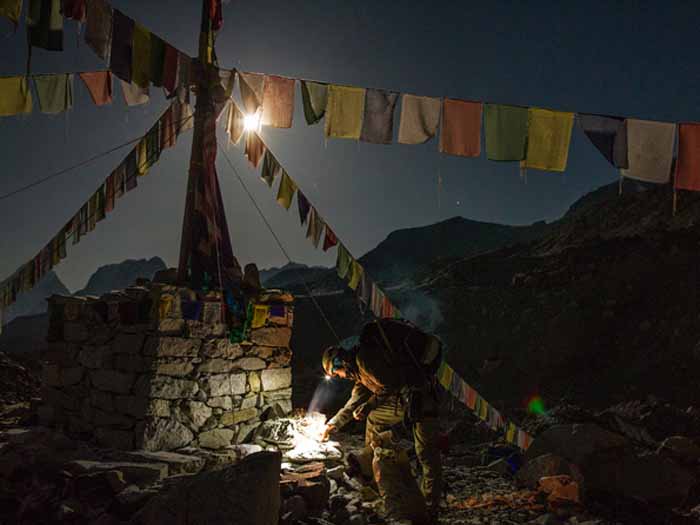
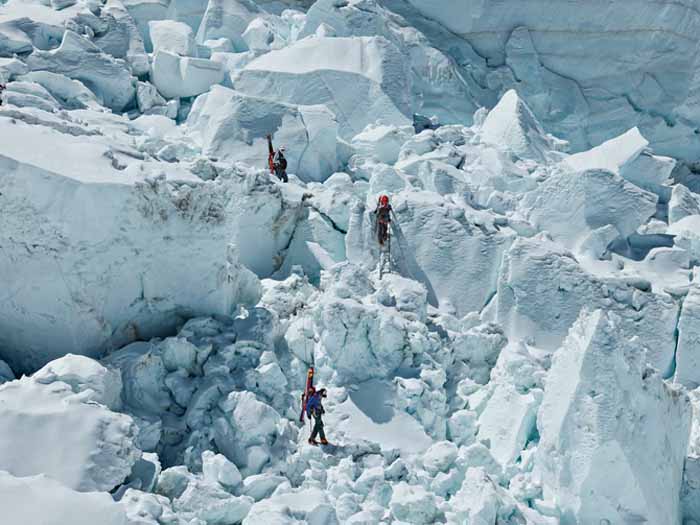
Before sunrise Danuru Sherpa burns juniper in an offering at Base Camp. A seasoned Everest hand, he first summited at age 18. Now 33, he has reached the peak at least 12 times. Why keep climbing? Danuru, who has two young daughters at school in Kathmandu, told writer Mark Jenkins: “Because I need the money. Photograph by Andy Bardon. Climbers descend through the Khumbu Icefall after spending time higher up on the mountain to acclimatize. This part of the icefall is known as the Popcorn Section, because that’s what its jumbled (and jumbo) blocks of ice resemble. Photograph by Andy Bardon.
"There is a commonly held perception that there isn't enough organic material in these mountains for a biogas program," Culhane says. "However, we found that this is simply not the case." back to top
Culhane went to Sagarmatha in spring to evaluate renewable alternatives to burning fossil fuel. He says the area is no stranger to solar power, thanks to Nepal's 55 percent alternative-energy subsidy. The government support, coupled with the desire of westerners for modern amenities, has led to solar-powered Internet cafes and lodges with hot water, warm meals, and light-up LED signs at nearly every village on the trail to Everest.
But solar alone is not enough to stop juniper harvesting and kerosene burning entirely.
"When the sun isn't shining, you are going to need another source of power," Culhane says. "Biogas could be the answer."
This story is part of a special series that explores energy issues. For more, visit The Great Energy Challenge.
For more detail please click the link: http://news.nationalgeographic.com/news/energy/2013/05/130515-mount-everest-biogas-energy/
Recent News:
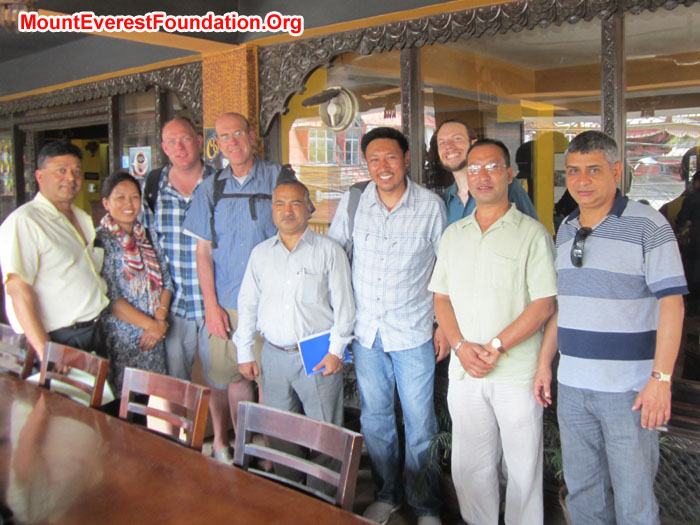
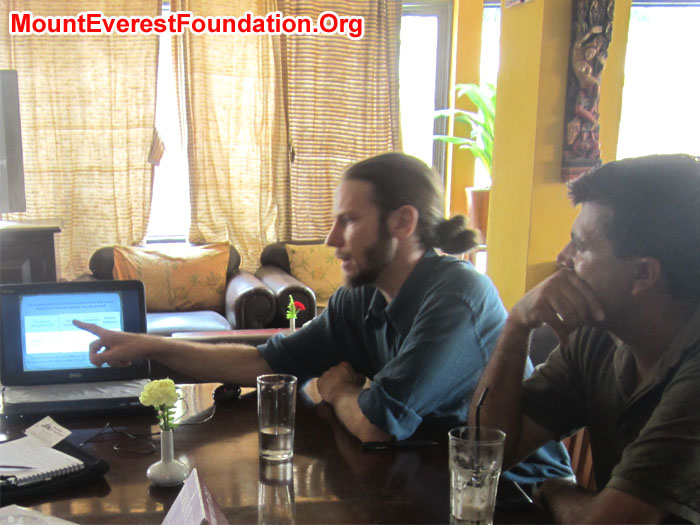
Mount Everest Foundation Team meeting with BSP-Nepal (Bio Gas Support Program). From left: Murari K. Sharma (MEF), Maya Sherpa (Nepal Mountaineering Association). Arnold Coster (Mount Everest Expedition Leader), Dan Mazur (Mount Everest Expedition Leader), Bala Ram Shrestha (Excecutive Director, BSP-Nepal), Mimgma Sherpa (Namche Buffer Zone Committee.), Nathaniel Janega – Engineer with Mt Everest Biogas Project, Subodh Shrestha, Prakash Lamichhane (Assistance Director). Photo by Deha Shrestha. Nathaniel Janega – Engineer with Mt Everest Biogas Project presenting his slide show, with him Mr. Mim Hamal (SNV Senior Advisor). Photo by Deha Shrestha.
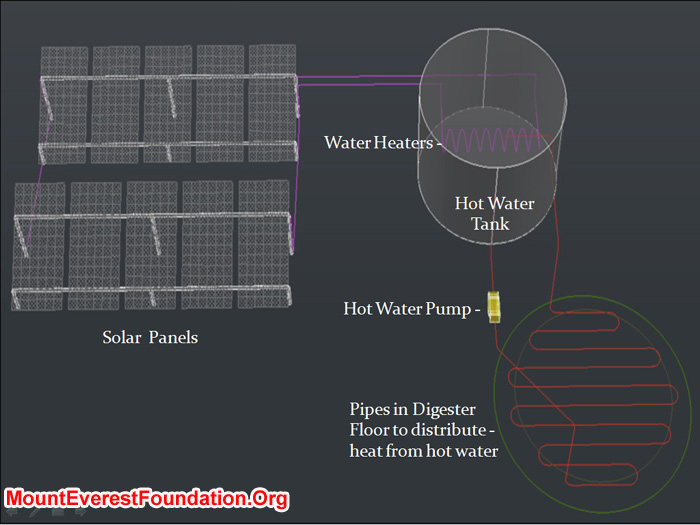
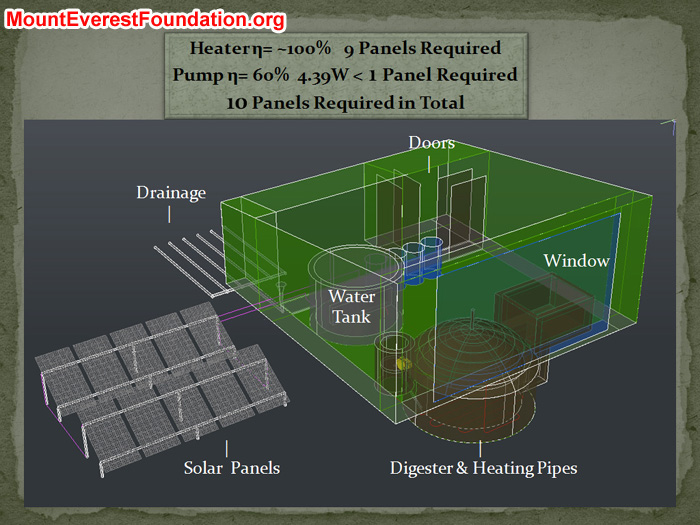
Proposed System to Heat Digester. Photo Nathaniel Janega. Proposed biogas system. Photo Nathaniel Janega. back to top
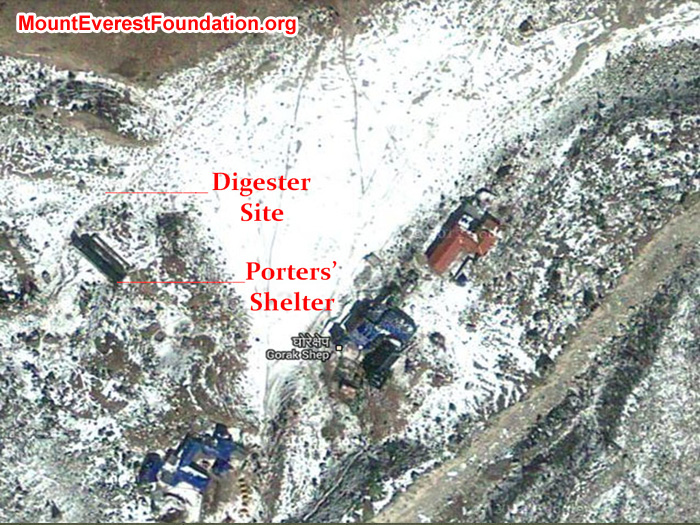
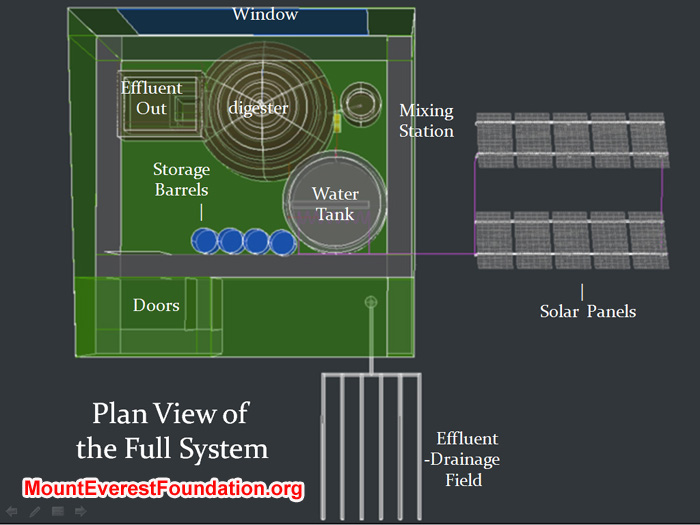
Image of proposed project site from Google earth. Photo Nathaniel Janega. Plan view of the site. Photo Nathaniel Janega.
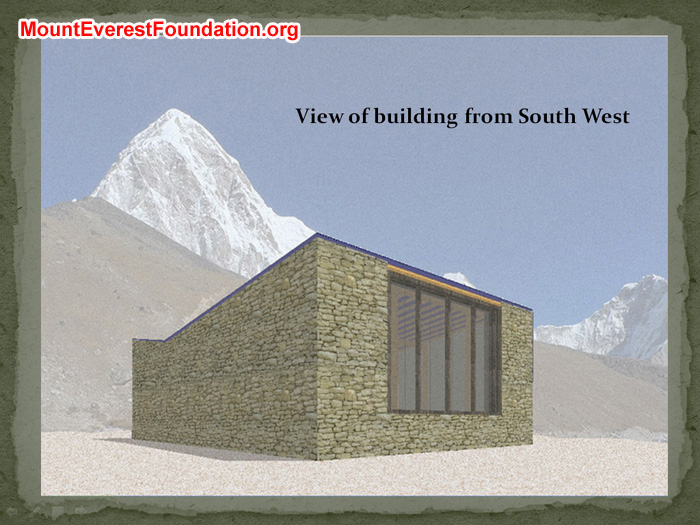
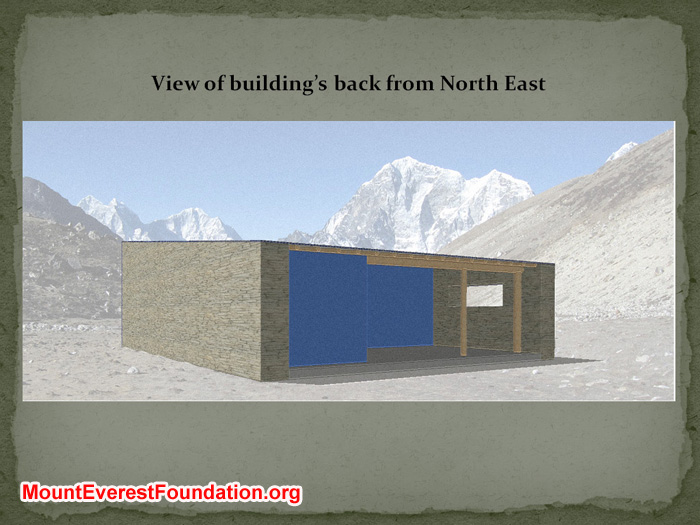
View of Future Building from South West. Photo Mike Eliason of Architect. View of future buildings back from North East. Photo Mike Eliason of Architect.
Recent News:
During April and May, Arnold Coster and Jon Kedrowski, while engaged in the month long project of climbing to the Summit of Everest with a succesful SummitClimb Everest expedition, heroically spent their rest days below basecamp studying the contamination of the drinking water and the drainage of the soil for installation of a biogas digester to convert the human waste from basecamp into useful cooking gas and fertilizer for local farmers. Well done Jon and Arnold! Here is a preliminary report of their findings.
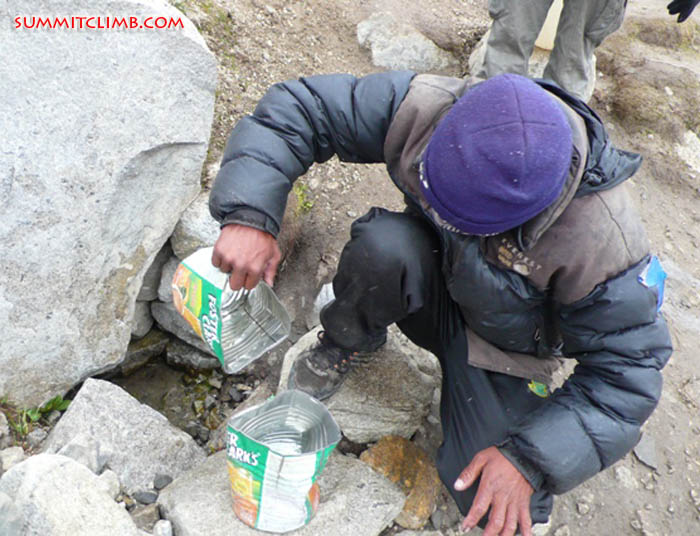
Porter dips water from a barely flowing spring at Gorak Shep. We studied water samples from this spring and found them to be contaminated.
Recent News by Jon Kedrowski, Ph.D.: The water quality testing in the Khumbu was done primarily in five locations: On the Khumbu Glacier at Basecamp, at the bottom of the glacier where it comes out and starts a river, and at Camp 2 on the Everest Route. I also surveyed and tested water sources in and near Luboche (4900m) and Gorak Shep (5200m).
Most of the sources at all locations had anywhere between 2 and 20x the USEPA legal limit for drinking water contamination for E.Coli and Total Coliforms.
I am looking forward to presenting the complete surveys and findings to the Mount Everest Biogas Team in their next Meeting in Seattle.
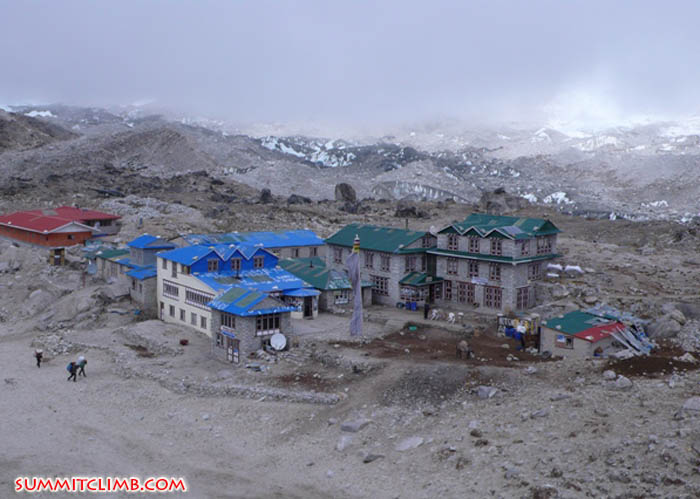
Gorak Shep, a busy tourist village at the edge of the Khumbu Glacier at 5,180 meters / 17,000 feet. At the bottom of the photo, you can see porters carrying toilet drums.
Recent News by Arnold Coster: The soil percolates very well: I dug three holes: one next to the porter house on the right. One halfway towards the dry lake and one in the dry lake. All in the same line. There where each 25cmx25cm and 40 cm deep.
The water soaks out in minutes. During the presoaking the holes almost empty straight away. After the presoaking it a little slower but not much, you see the water level drop and the slowest hole took only 8 min.
The soil consist of sand, small stones and gravel and its really hard to dig a hole. There is nothing solid like clay in the soil and between the rocks are air gaps. It's kind of loose, Therefore the soil percolates very well.
This is what I can tell you now, exact numbers I can send you later. I don't think they really matter though, It's pretty good if 25 liter soaks away in 8 min and this is a pretty low tech inaccurate test also. 7 or 8 min doesn't really matter for the conclusion.
Cleaning Up Mount Everest
While visiting our world’s highest mountain, climbers, trekkers, and walkers take away great memories, lots of photos and new friends, but leave behind their untreated waste. This needs to stop. At the Mount Everest Biogas Project our mission is to convert human waste from base camp into environmentally safe products for the people of Nepal, by designing a biogas system that can operate at high altitudes (above 5000 meters / 16,400 feet). The Mount Everest area is a destination for climbers, trekkers, and walkers from all over the world. Climbers come to the mountain to participate in one of the world’s most prestigious and challenging events – an icy and freezing cold and windy summit attempt to the top of Mt. Everest or one of its sister peaks. Trekkers, hikers and walkers come to experience the wide and beautiful trails through green terraced villages, the high altitude walk to world famous Everest Basecamp, and to trek up the spectacular view ridge of Kala Patar for one of a kind views of our world’s highest peak. You wont find any snow on these hiking trails, but lots of friendly sherpas and amazing views. At the Mt. Everest Biogas project, we are designing a new solution that will help out not only everyone’s favourite big mountain, but an innovative idea that can be broadened to high mountain environments round the world.
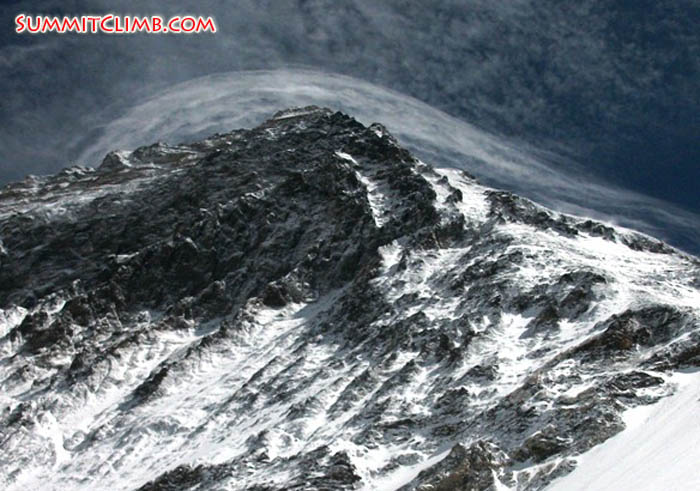
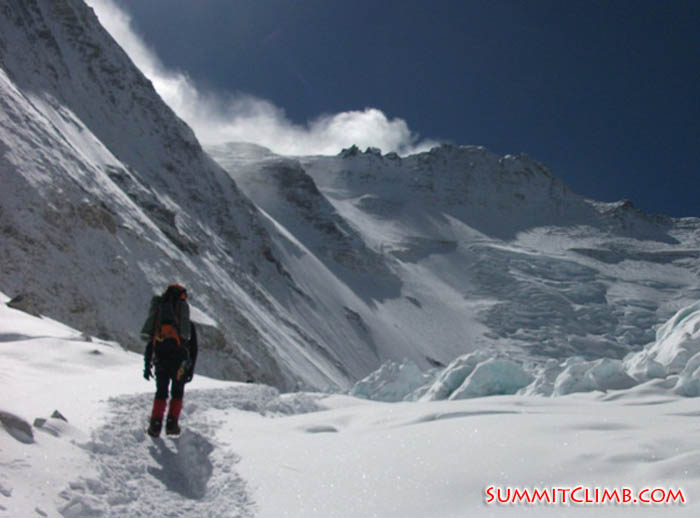
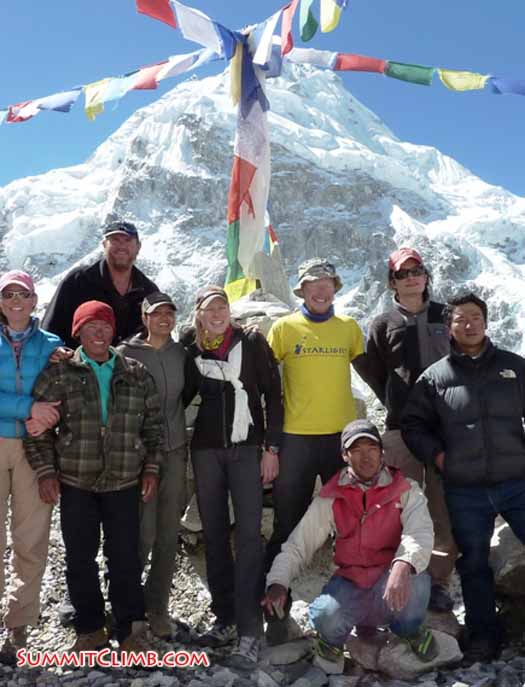
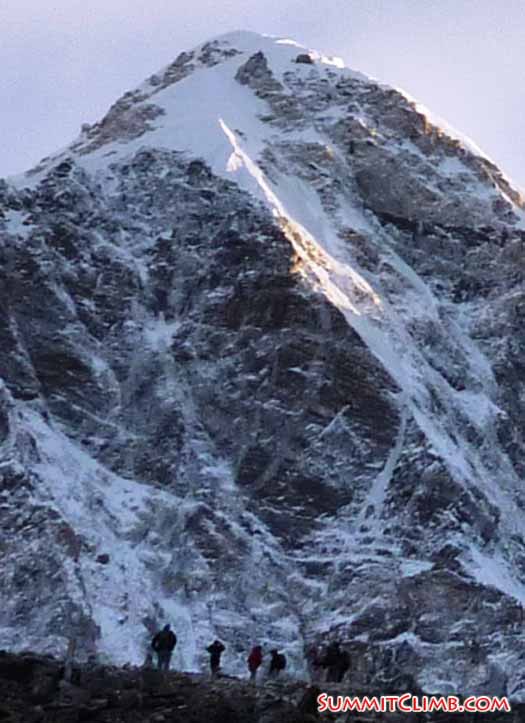
Stunning cloud swirls atop Everest (Alex Holt). Gavin sets off for Lhotse. Check out the winds aloft (Alex Holt). SummitTrek.com team in Everest basecamp. Trekkers walk up Kala Patar view ridge. Mount Pumori in background (Miyako Mori).
Short Term Goal:
The immediate goal is to construct a biogas digester which will operate at lower temperatures at Gorak Shep (elevation 5,180 meters / 17,000 feet) and evaluate its effectiveness in converting human waste from Mount Everest into methane gas for the local community and fertilizer for crops. Back to top
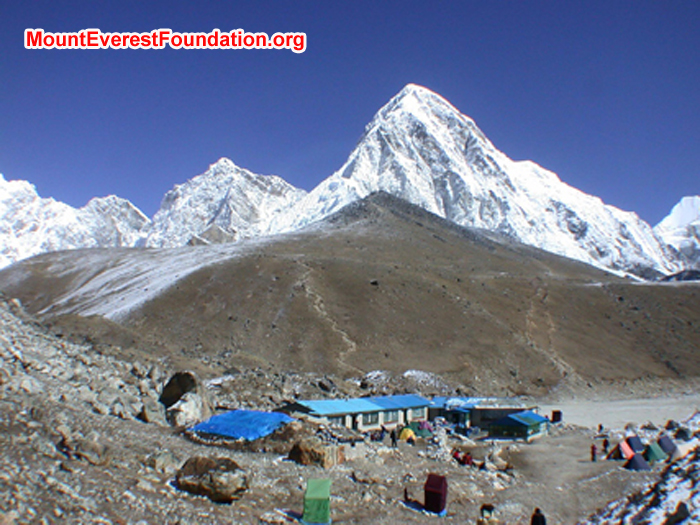

Gorak Shep (elevation 5,180 meters / 17,000 feet) with Mount Pumori in the background.Biogas Diagram. Back to top
Long Term Goal:
The long-term goal is to utilize 100% of the waste products generated in the base camps of Mt Everest and surrounding peaks in an anaerobic digester system which will generate methane gas and fertilizer. And second, to replicate the system in other high altitude areas thereby improving the lives of the people and the environment by reducing pollution, deforestation, health risks and costs to obtain alternate fuel sources and to produce high quality agricultural fertilizer to help out local farmers. Back to top
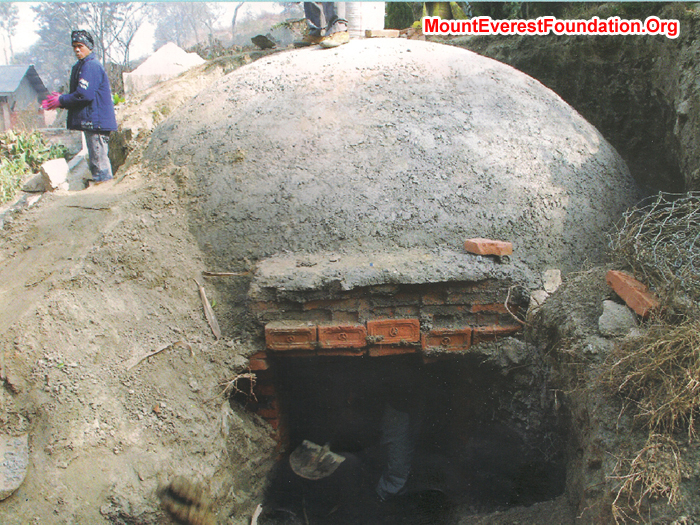
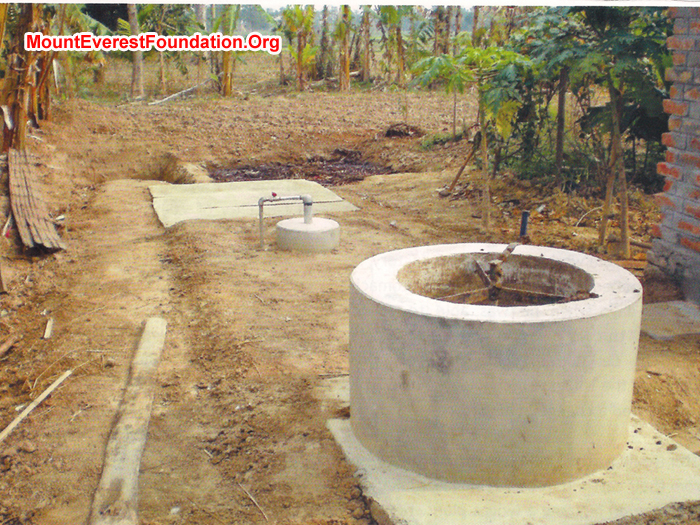
Building the biogas digester dome.What a biogas plant looks like after back filling.
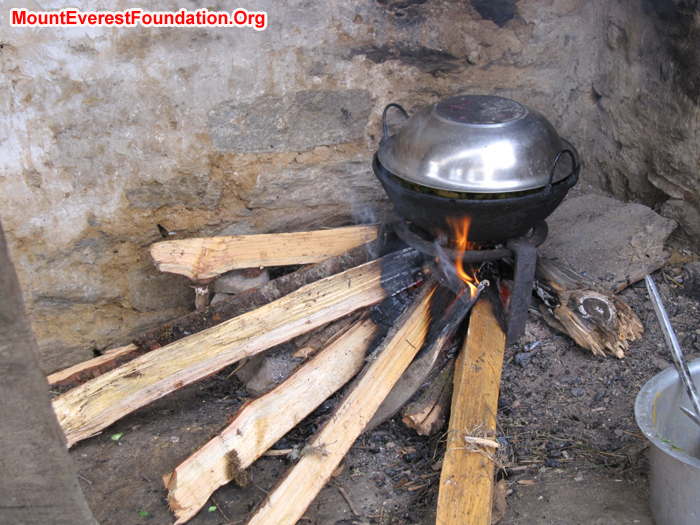
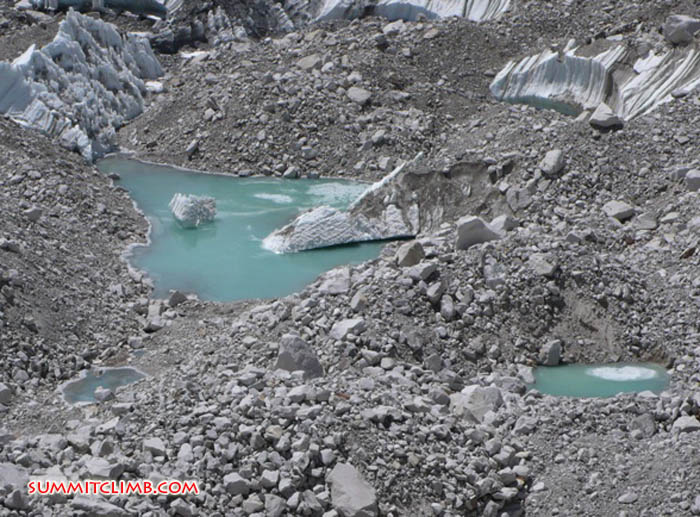
Traditional Nepalese cooking method before biogas. Burning wood on an open and chimneyless fire inside the house, where everyone breathes the toxic smoke, especially the cooks.On the way out of basecamp we took photos of glacial lakes for doctor Ulyana Nadia Horodyskyj, who is studying glacial recession. Back to top
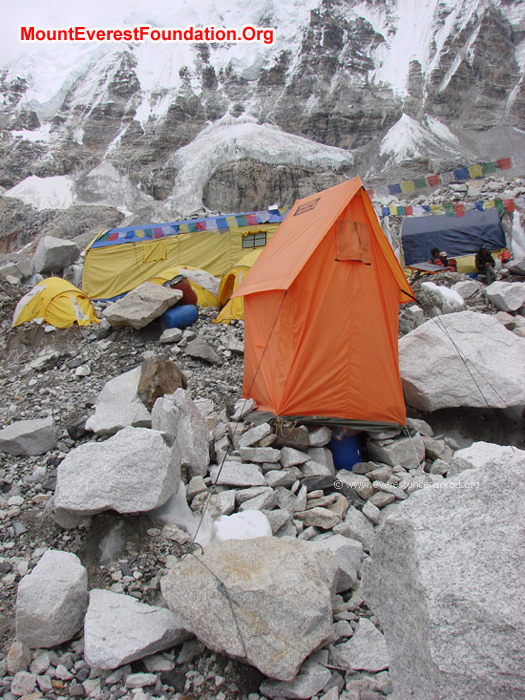
Everest basecamp toilet with blue barrel below slightly visible Back to top
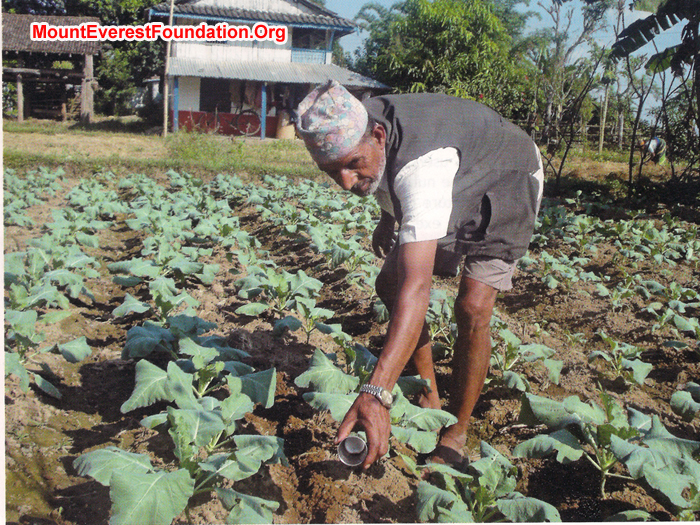
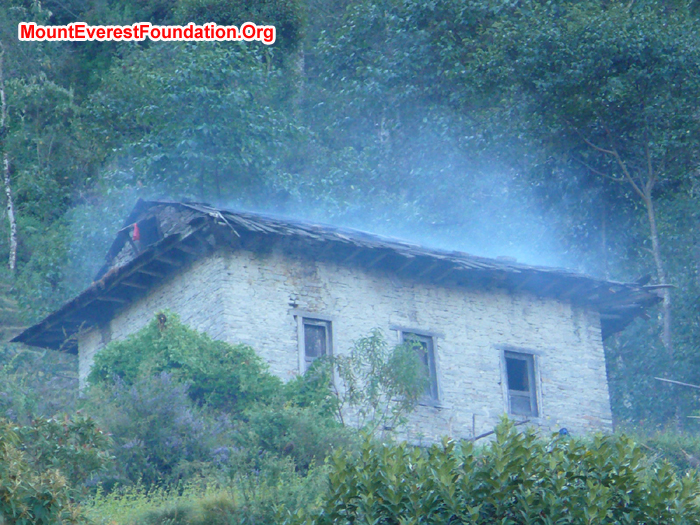
Using slurry from the digester to increase crop yields by as much as 20 percent. Why there are so many respiratory problems in Nepal. Before biogas they burned wood indoors with no chimney. Back to top
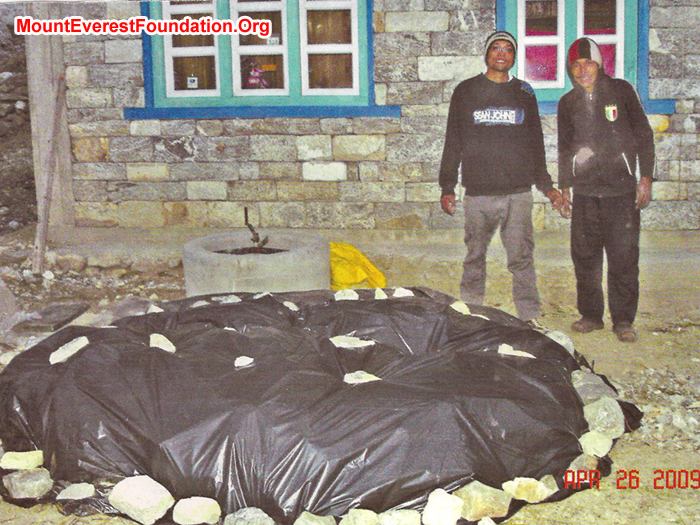
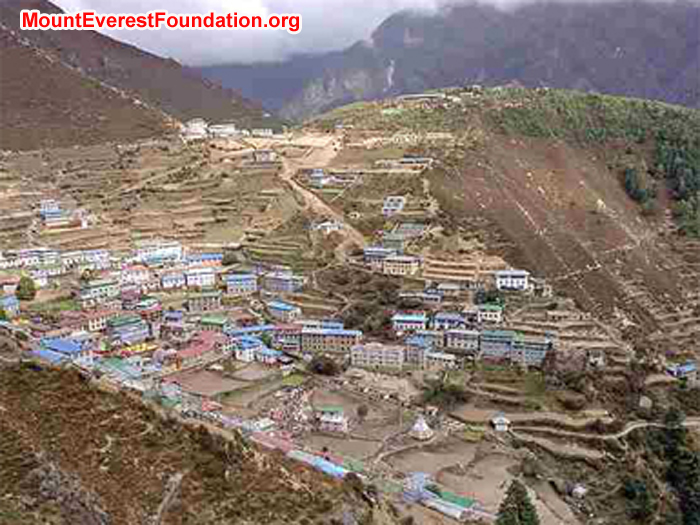
Here is one low-tech method of making biogas at higher elevations by stacking compost as insulation on the lid of the digester and covering with black plastic. Namche Bazaar, the largest village near to Everest, has suffered horrible deforestation, note the town has barely a single tree, the hillside stripped of vegetation , and the landslide on the right side of the photo. Back to top
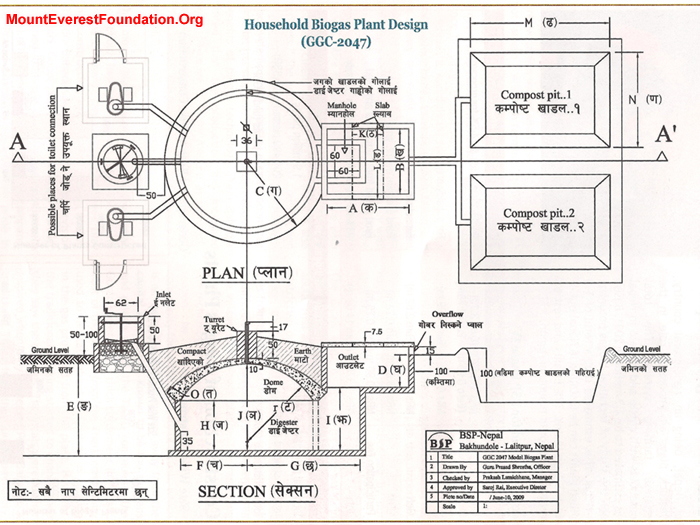
Biogas Schematic. Back to top
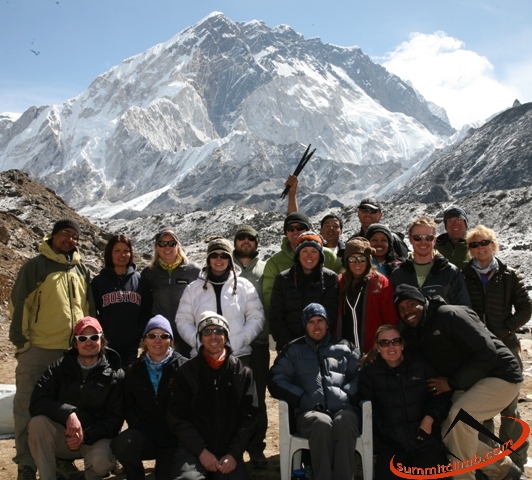
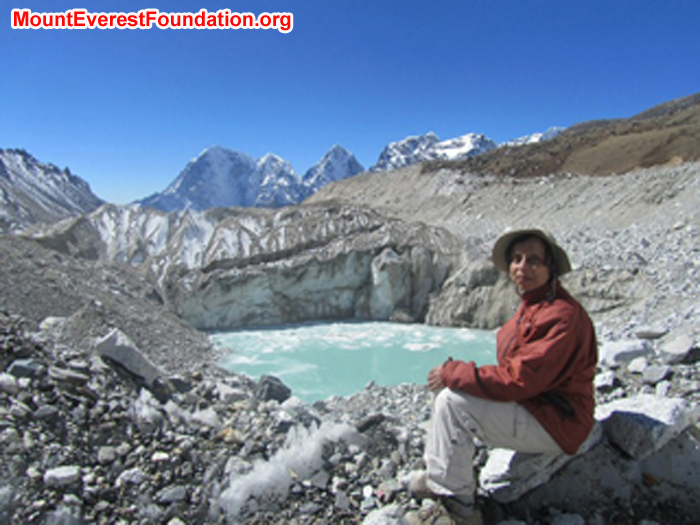
SummitTrek Spring team in Lobuche with Nuptse behind (Chris Howard) .Pramila Kumari resting beside a lake inside the Khumbu Glacier on the way to basecamp. Back to top
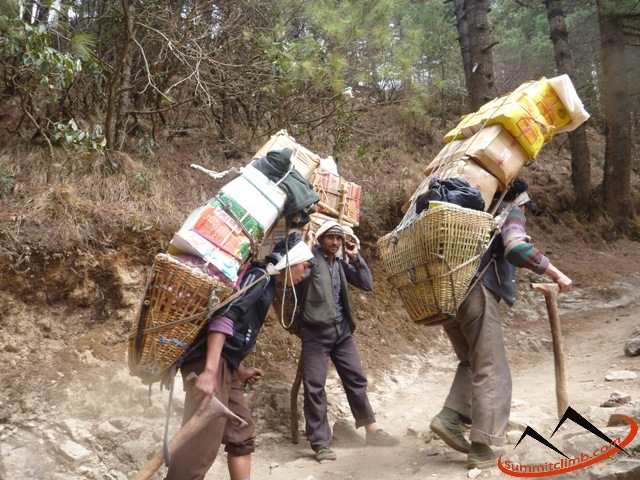
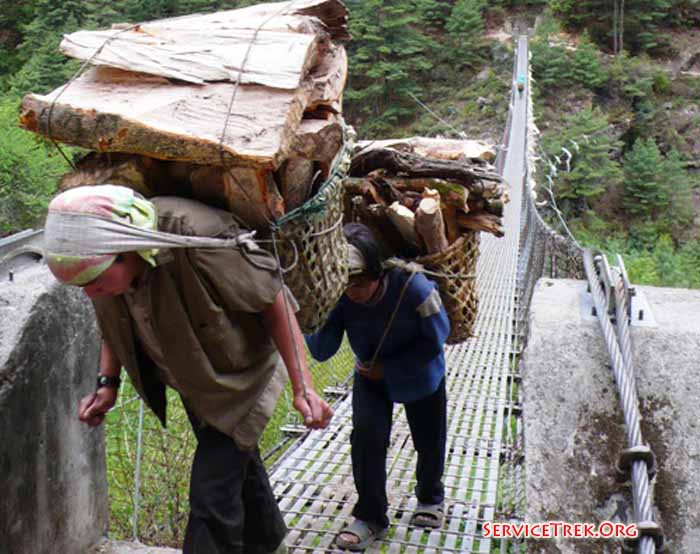
Porters with heavy loads on the way up to Namche Bazaar. Everything in this region has to be carried in on the backs of porters. There are no roads. (Stewart Edge). Deforestation in action: Woodcutters carrying firewood over the Monjo bridge. Back to top
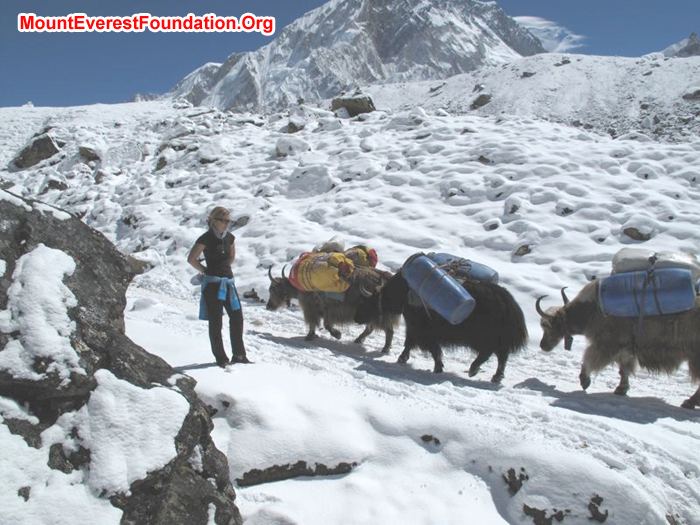
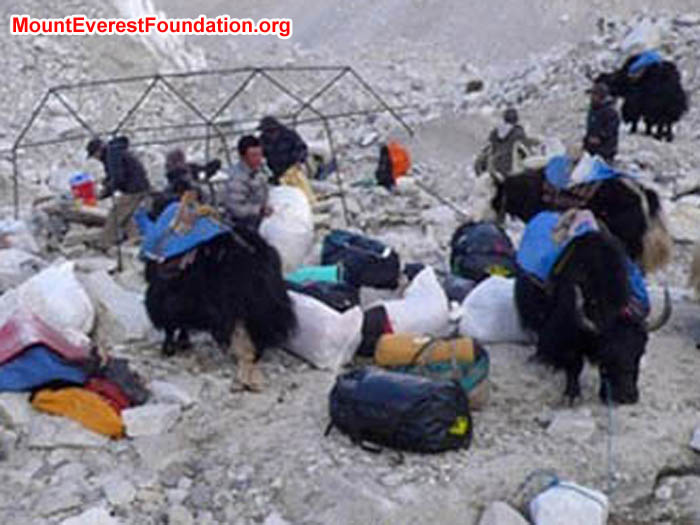
Yaks with blue barrels. Packing up basecamp at the end of the Everest Season. Each April and May Everest basecamp is home to 500-1000 people from Nepal and countries from all over the world.
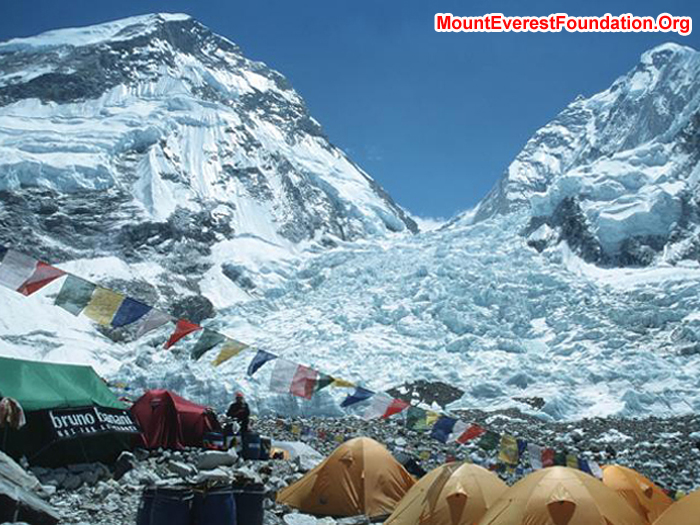
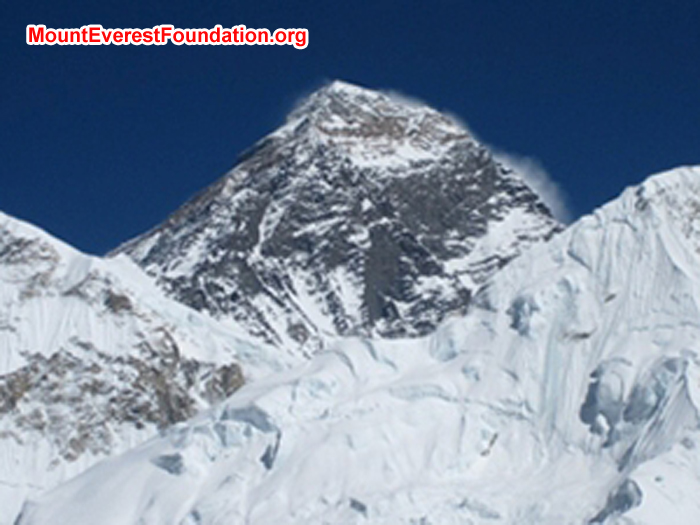
Everest basecamp at 5300 metres / 17,380 feet. On the left, the west ridge of Everest, in the centre, the famous Khumbu Icefall, right: Mount Nuptse. View of Mt. Everest from Kala Patar (Rick Gross). Back to top
For further details, please visit www.MtEverestBiogasProject.org , www.CleaningUpMountEverest.org and www.MountEverestFoundationNews.org .
The Man Trying to Fix Mount Everest's Towering Poop Problem
Volunteer engineers and architects want to solve Mount Everest's most unsolvable problem: its landfills of human waste.
Author: Sarah Emerson, Date: Jan 17, Publication: V.I.C.E.
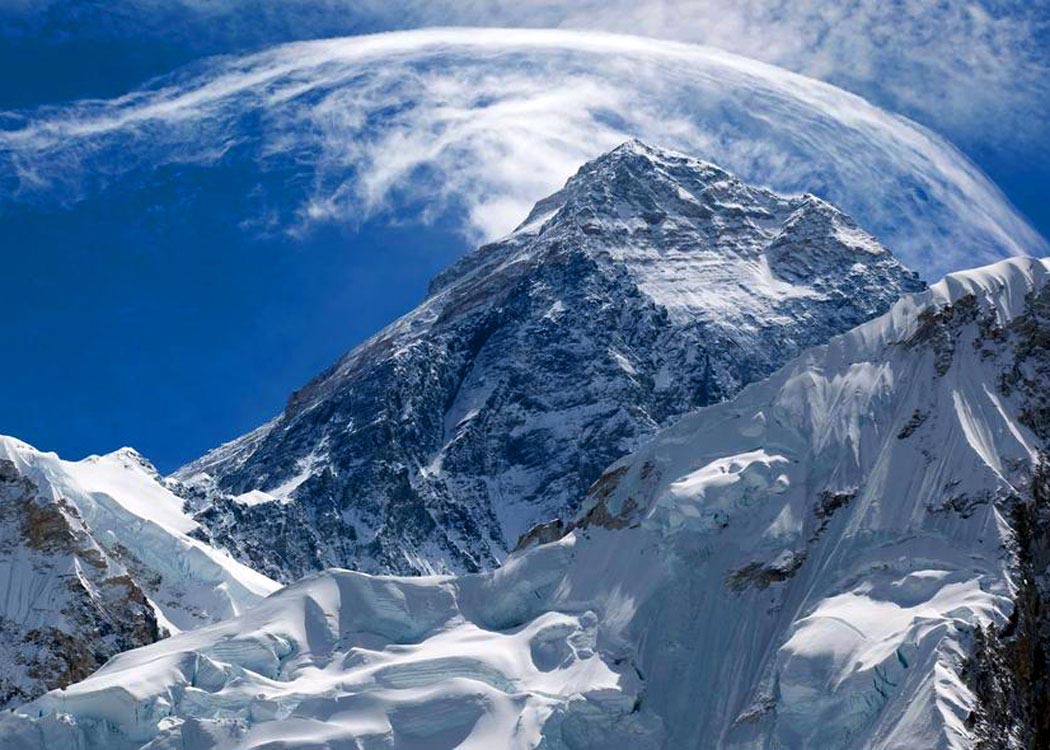
Mount Everest, Nepal. Image: Mount Everest Biogas Project
Mount Everest is more accessible than ever. Better gear, amenities, and the help of tireless guides have swamped the mountain with intrepid tourists. More than 36,000 people toured the region, marking a 34 percent increase in visitation compared.
The heightened interest in Mount Everest has been a revenue boon for Nepal. Climbers spend $30,000 to $100,000 each on the endeavor, depending on their choice of permit and expedition company. But more people also means more waste, including human waste. Yes, poop—lots of it.
More than 26,000 pounds of human excrement is dumped at Mount Everest’s Base Camp annually. There, it remains, fetid in blue barrels (equipped with toilet seats!), until Sherpa porters can transport it to Gorak Shep, a frozen lakebed that’s become Everest’s ad-hoc landfill. Nepal’s government ruled that climbers must leave the mountain with 17.6 lbs of trash or forfeit a $4,000 garbage deposit, but the excess of human waste has remained a different kind of dilemma.
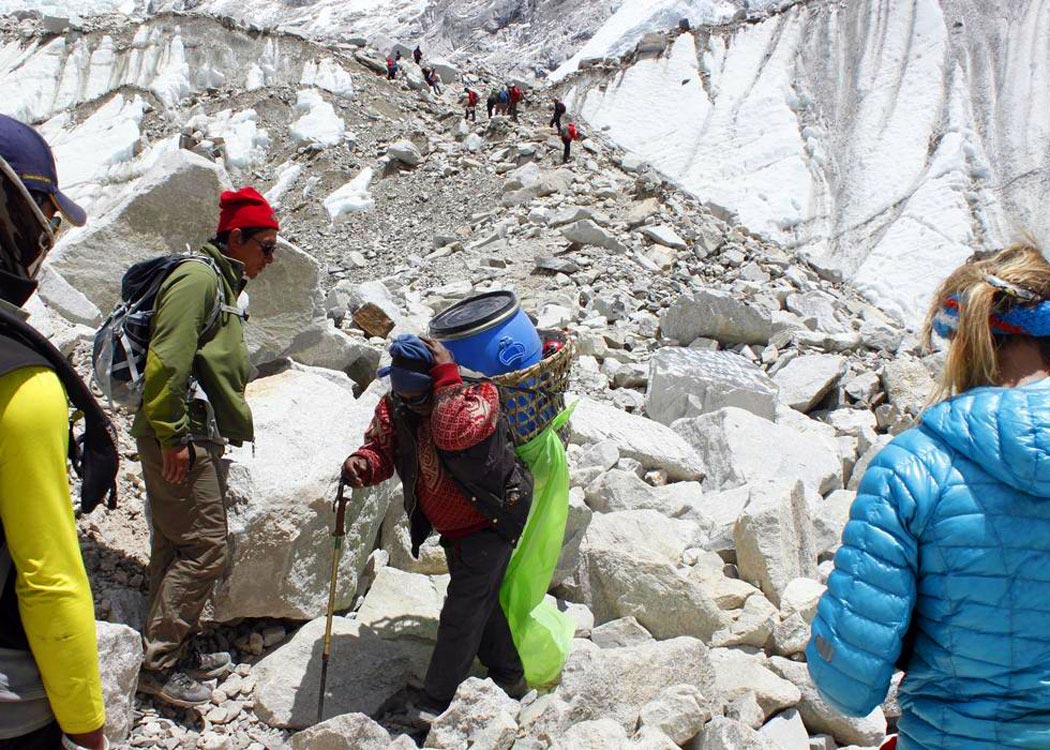
A porter with waste descending from Mount Everest Base Camp. Image: Mount Everest Biogas Project
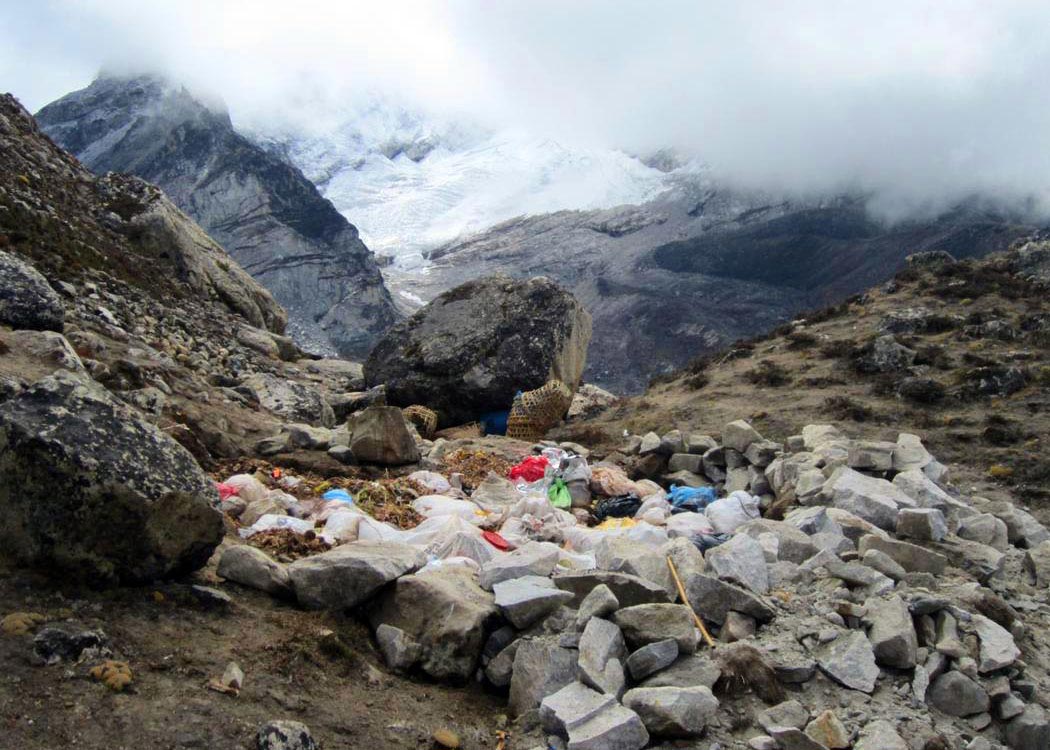
Trash and human waste at Mount Everest. Image: Mount Everest Biogas Project
“It just struck me from an emotional standpoint,” Garry Porter, a seasoned climber and retired Boeing Company engineer, told me.“We’d been in the most fantastic country in the world, had this trip, and we’re watching them haul our poop away. It didn’t balance with where we’d been,” Porter added. “And that was our final tribute to the Nepalese people?”
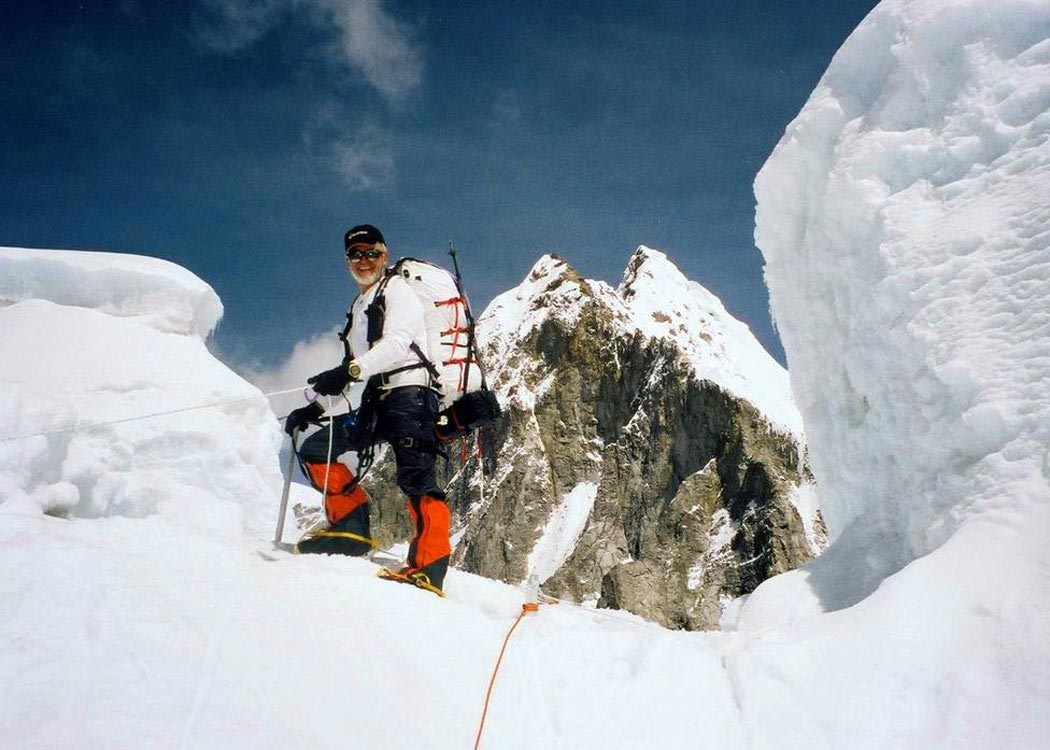
Garry Porter at Mount Everest. Image: Mount Everest Biogas Project.
Seven years ago, Porter decided to make poop his problem, and co-founded the Mount Everest Biogas Project, which relies on volunteer engineers and architects to tackle Everest’s most intractable issue. It couldn’t have happened soon enough. A survey of two water sources near Gorak Shep, funded by the National Science Foundation, found that one of them violated drinking water standards from the World Health Organization by a degree of four.“You can’t keep putting [excrement] in open pits near water sources and not expect to see an environmental problem,” Porter said.
Their solution? Convert all that waste into usable power with something called a “biogas digester.”
Biogas digesters aren’t flashy, but they get the job done: “This is not a new hightech anything,” Porter warned. They’re tanks full of bacteria that feed on organic waste. They produce methane gas as a byproduct, plus a liquidy fertilizer known as “effluent.” That gas can be captured, and used to power anything from Mount Everest's tea houses (lodges) to laptops, because, yep, there’s internet on Everest, too.
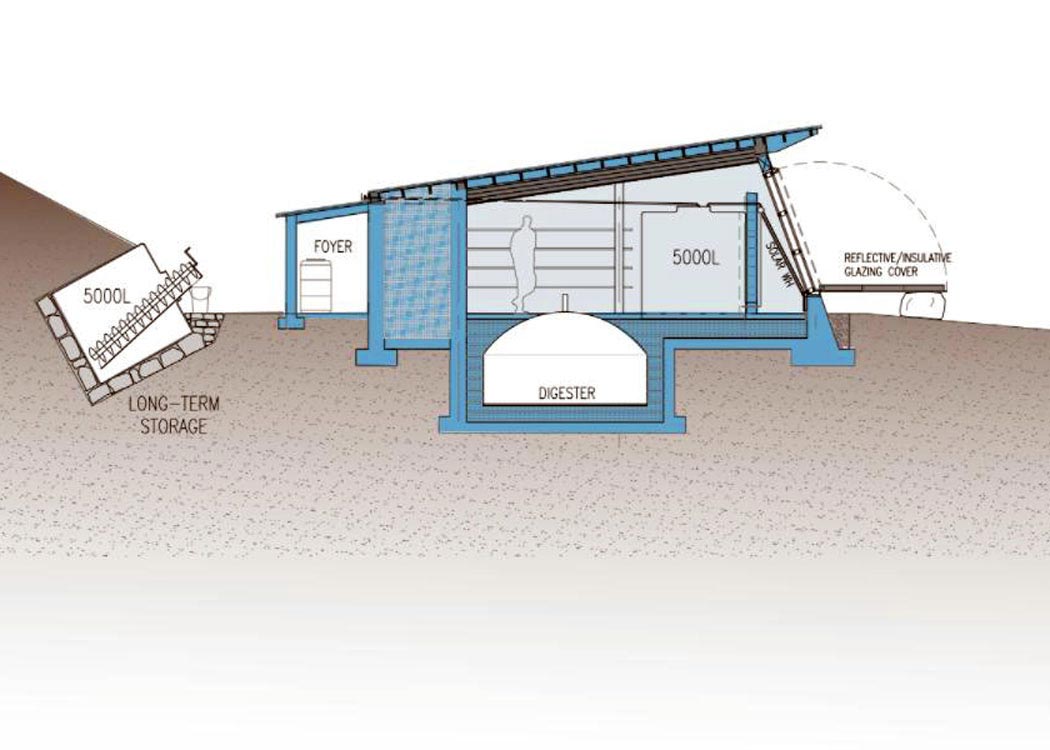
Garry Porter at Mount Everest. Image: Mount Everest Biogas Project.
In theory, providing Everest with an inexhaustible supply of poo power is doable. But, true to form, the mountain isn’t going to make things easy. Keeping those bacteria happy and hungry requires warmth; they are only active if their ecosystem’s temperature is somewhere between 68 and 86 degrees Fahrenheit. Base Camp, which sits 17,600 feet above sea level, can regularly reach subzero temperatures. Digesters have been used all around Nepal, China, and India, Porter said, but at lower, more temperate elevations. If this technology could be adapted for one of the world’s most inhospitable climates, it might also be applied at other mountains with human waste problems.The team needed a way to keep the digester warm, 24 hours a day, and with local, off-the-shelf hardware. Keeping this project grounded in Nepal—down to the last battery—was non-negotiable for Porter. “We want this to be a Nepalese project. We’ll build it at our expense, and turn the keys over to them,” he told me.
The solution was an 8.5 kilowatt solar array, similar to ones people have installed on their roofs, that the team acquired in Kathmandu. The solar array, once connected to 48 two volt batteries, created an excess of electricity able to warm the digester through the night.
“We’re ready to implement the design, we have buy-in from the customer, but we have to raise money,” Porter said, though he wasn’t able to provide a cost estimate when we spoke. The project is still in the prototyping stage, but the team, through a partnership between Seattle University and Kathmandu University, has proven the digester can operate on human waste and produce methane gas (at the optimal temperature range) in a lab setting.
The team is already considering next steps. Porter won’t allow the effluent to be used as fertilizer until he can test it for human pathogens—anything from norovirus to cholera, for instance. If disease-causing agents survive the digester, the effluent won’t be safe to use on crops for human consumption.

Nepalese tea house owners. Image: Mount Everest Biogas Project
The Mount Everest Biogas Project worked with two Nepalese organizations, Sagarmatha Pollution Control Committee and the Sagarmatha National Park Buffer Zone Management Committee, to ensure the design met their standards, and could be reproduced by local workers.“They said, ‘Well, our biggest question is when can you start, because what climbers are doing here is disrespectful to the mountain,’” Porter added.
Some climbers believe that, recently, the mountain has become less of an adventurer’s pilgrimage, and more of a wealthy person’s tourist trap. But, regardless of what Mount Everest has become, its modern legacy was quite literally built on the backs of an often nameless, invisible Sherpa workforce. The Mount Everest Biogas Project seems to be chipping away at some of that debt.
Porter’s reverence for Mount Everest is obvious, and, while he missed the summit on a climb, he’s certain the biogas project will succeed.
“How do we protect it, so it’s there for my kids, and my kids’ kids?,” Porter asked. “It’s just about paying it forward for me.”
Water Sampling which took place in GorakShep in May and was done by Arnold Coster and Jon Kedrowski for more details please visit www.cleaningupmounteverest.org
During April and May , Arnold Coster and Jon Kedrowski, while engaged in the month long project of climbing to the Summit of Everest with a succesfulSummitClimb Everest expedition, heroically spent their rest days below basecamp studying the contamination of the drinking water and the drainage of the soil for installation of a biogas digester to convert the human waste from basecamp into useful cooking gas and fertilizer for local farmers. Well done Jon and Arnold! Here is a preliminary report of their findings.
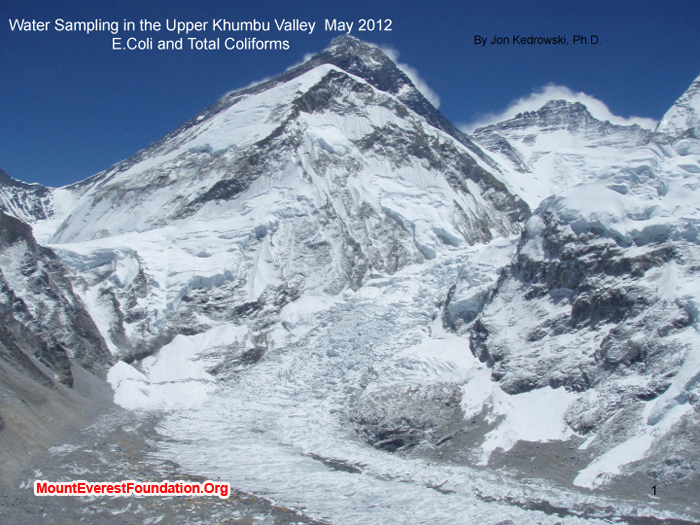
Water Sampling in the Upper Khumbu Valley.
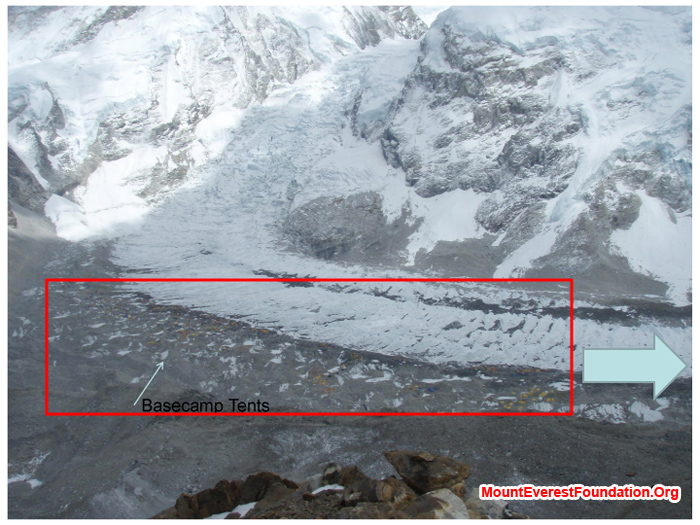
This is the area where basecamp tents are pitched near the Khumbu glacier
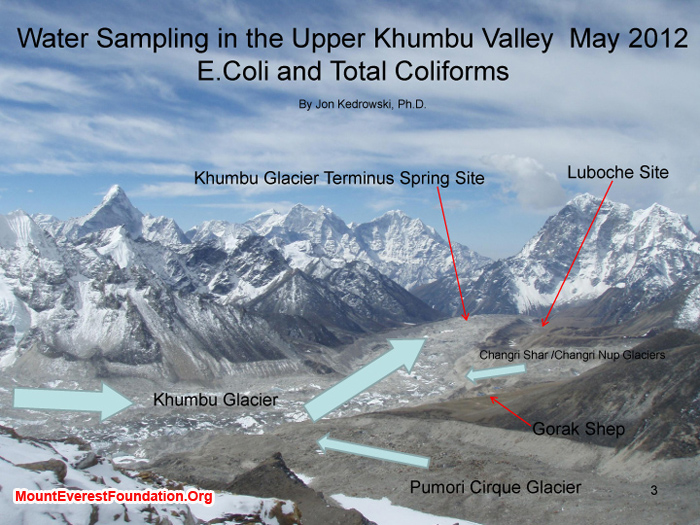
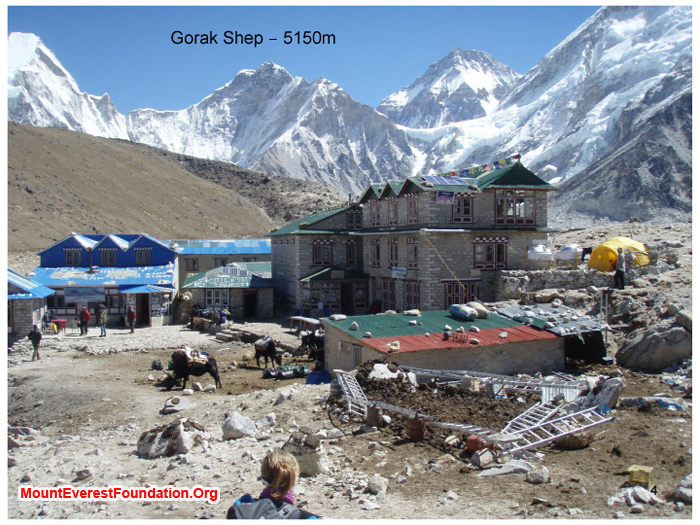
This image shows the sites where the water testing took place. This is GorakShep – a busy tourist village at the bottom of the Khumbu glacier 5,180 meters / 17,000 feet
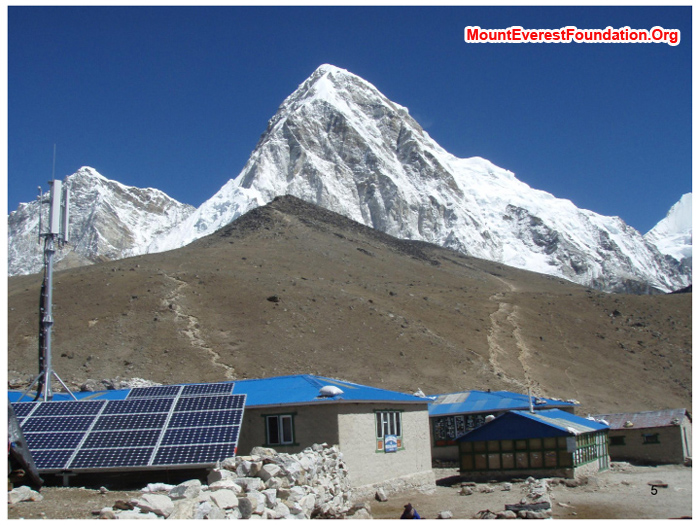
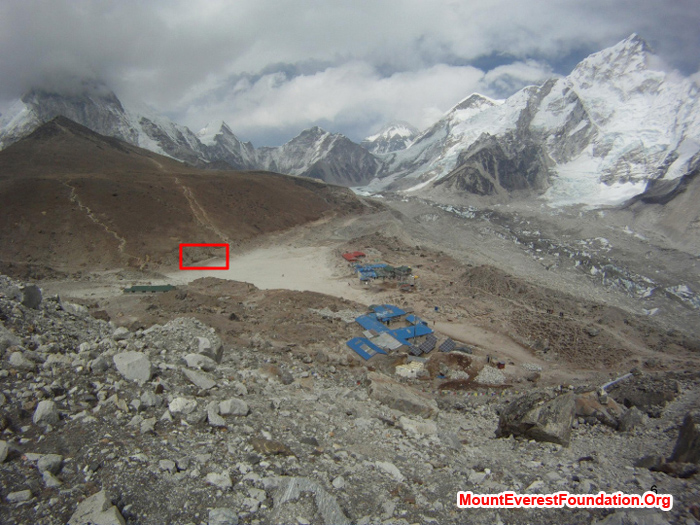
Another view of GroakShep this time with Pumori in the background. The red area indicates the Spring sites that we tested.
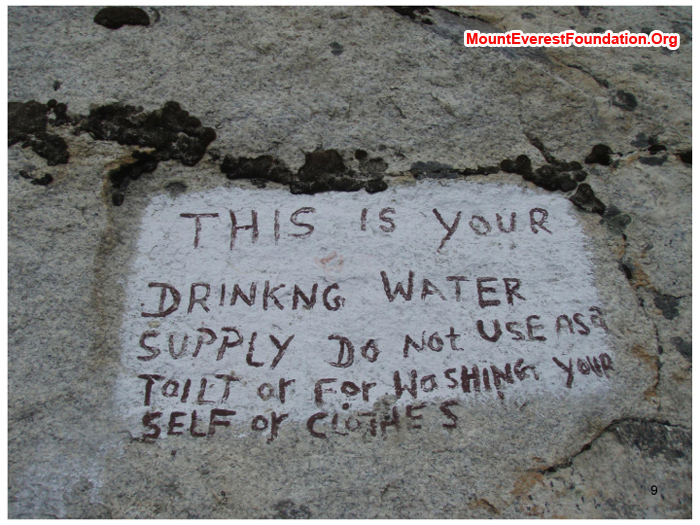
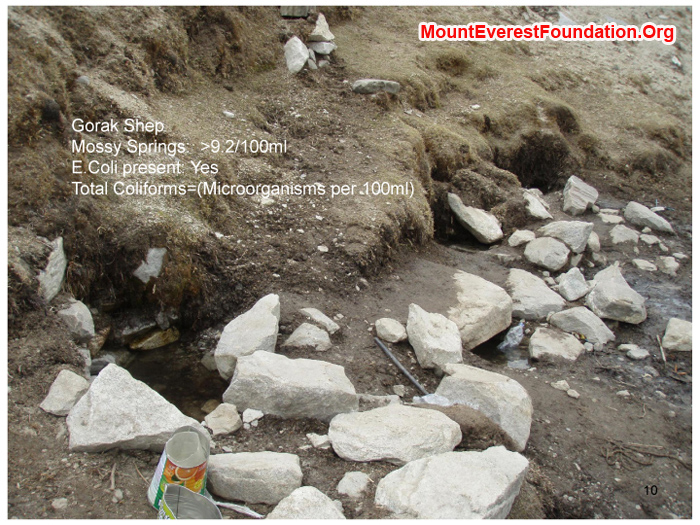
Notice written in Rock. Testing at GorakShep – e-coli present, Mossy Springs >9.2/100ml.
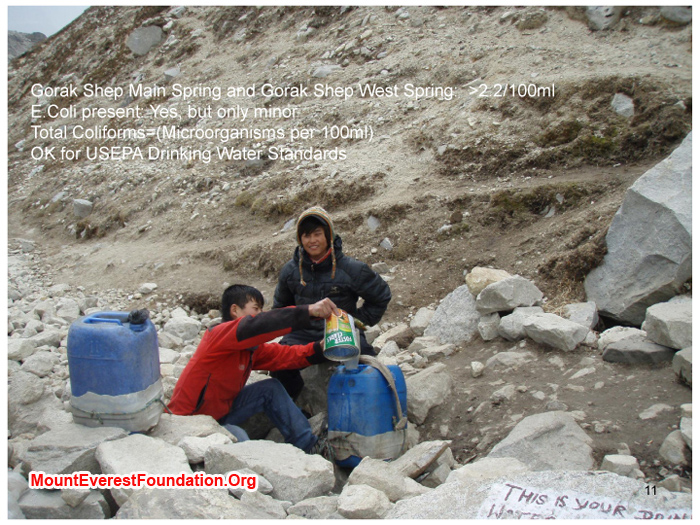
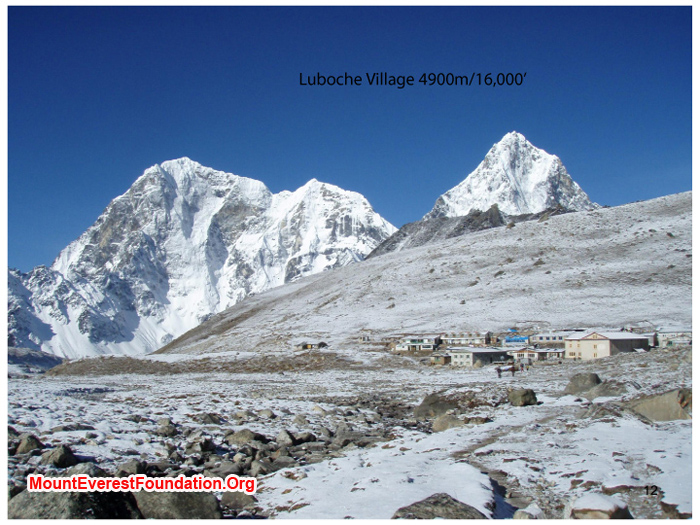
GorakShep Main and West springs – Minor e-coli present which means it is OK for USEPA drinking standards. Lobuche village.
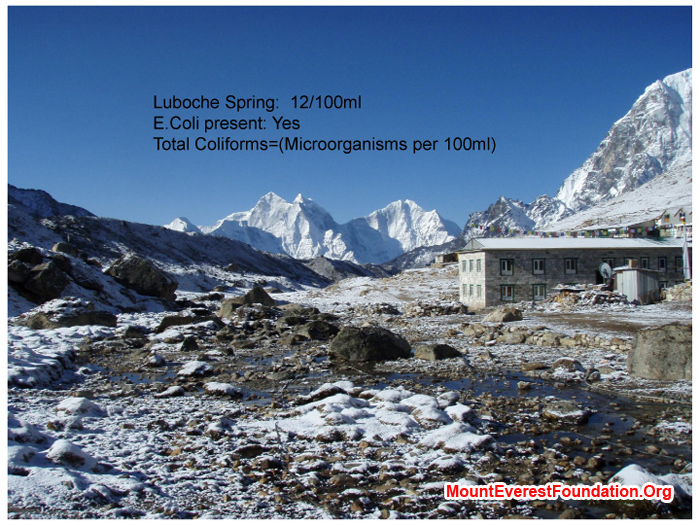
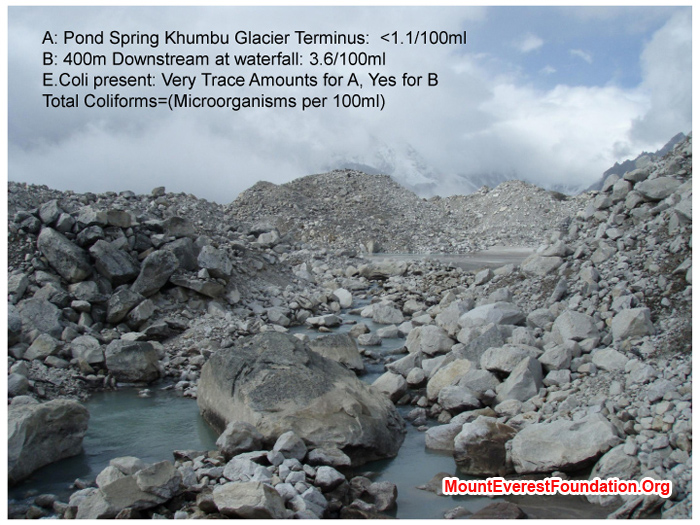
Lobuche Spring – E-coli present. Pond Spring Khumbu Glacier & 400m downstream at the waterfall, again e-coli present but just a trace this time
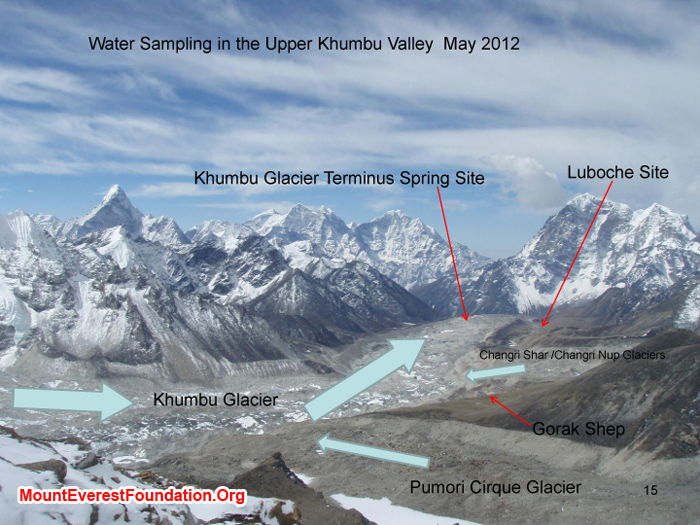
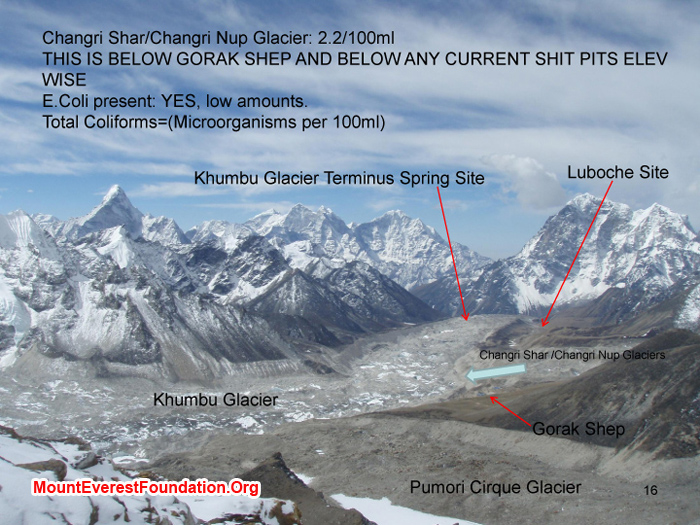
The blue arrows indicate the flow of the water sources. Another view of the sites which were tested. ChangriShar / ChangriNup Glacier results: 2.2/100ml again E-coli is present .
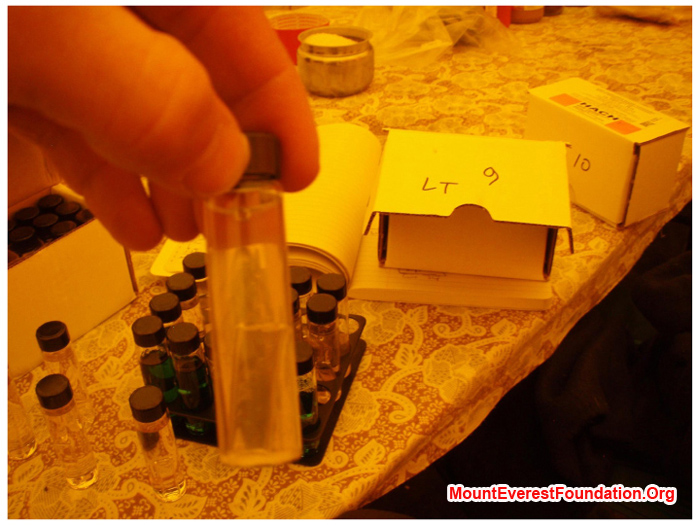
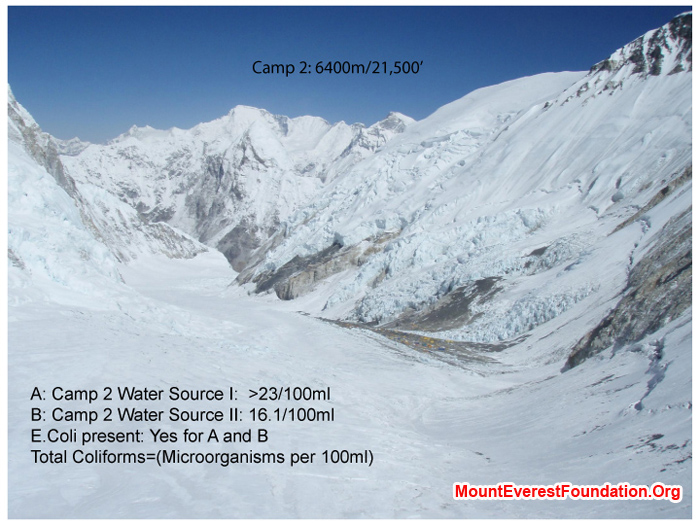
Tests taking place. Camp 2 again E-coli is present at both water sources.

Thanks for viewing our presentation - any questions?


